Welcome
Let’s start from the beginning. Quarkus. What’s Quarkus? That’s a pretty good question and probably a good start. If you go to the Quarkus web site, you’ll read that Quarkus is "A Kubernetes Native Java stack tailored for OpenJDK HotSpot & GraalVM, crafted from the best of breed Java libraries and standards." This description is somewhat unclear but does an outstanding job at using bankable keywords. It’s also written: "Supersonic Subatomic Java." This is a way of saying that Quarkus is really fast, and it’s really light. But what does Quarkus do?
In practice, Quarkus is a stack to develop distributed systems and modern applications in Java, Kotlin, or Scala. Quarkus applications are tailored for the Cloud, containers, and Kubernetes. That does not mean you can’t use Quarkus in other environments, there are no limits, but the principles infused in Quarkus have made containerization of applications more efficient. In this workshop, we will explain what Quarkus is and because the best way to understand Quarkus is to use it, build a set of microservices with it. Again, Quarkus is not limited to microservices, but it’s a generally well-understood type of architecture.
This workshop offers attendees an intro-level, hands-on session with Quarkus, from the first line of code to making services, to consuming them, and finally to assembling everything in a consistent system. But, what are we going to build? Well, it’s going to be a set of microservices:
-
Using Quarkus
-
Using blocking and non-blocking HTTP invocations
-
With some parts of the dark side of microservices (resilience, health, etc)
-
Use an event-based architecture using Apache Kafka
-
Use OpenAI to introduce some artificial intelligence
-
Deploy the entire application to Azure Container Apps
-
Answer the ultimate question: are super-heroes stronger than super-villains?
This workshop is a BYOL (Bring Your Own Laptop) session, so bring your Windows, OSX, or Linux laptop. You just need JDK 17 on your machine and Docker (having Apache Maven 3.9.x installed is optional as you will rely on the Apache Maven Wrapper). On Mac and Windows, Docker for x is recommended instead of the Docker toolbox setup. On Windows it is also recommended to have WSL (Windows Subsystem for Linux) installed.
What you are going to learn:
-
What is Quarkus, and how you can use it
-
How to build an HTTP endpoint (REST API) with Quarkus
-
How to access a relational database
-
How you can use Swagger and OpenAPI
-
How you test your microservice
-
How to build a reactive microservice, including reactive data access
-
How you improve the resilience of your service
-
How to invoke OpenAI/Azure OpenAI APIs using Semantic Kernel
-
How to build event-driven microservices with Kafka
-
How to build use contract testing so we are sure our microservices are fully functional
-
How to build native executable
-
How to containerize our microservices
-
How to deploy the microservices to Kubernetes
-
What is Azure Container Apps
-
How to push the Docker images to Azure Registry
-
How to create managed services in Azure (Postgres database, Kafka)
-
How to deploy microservices to Azure Container Apps
-
How to configure Docker images in Azure Container Apps
-
How to use Quarkus CLI to create a command-line application to load stress our microservices
-
How to extend Quarkus with extensions
-
And much more!
Ready? Here we go! Check the workshop at https://quarkus.io/quarkus-workshops/super-heroes/ or flash the QR Code if you don’t want to type.

Presenting the Workshop
This workshop should give you a practical introduction to Quarkus. You will practice all the needed tools to develop an entire microservice architecture, mixing classical HTTP, reactive and event-based microservices. You will finish by extending the capabilities of Quarkus and learn more about the ability to create native executables.
The idea is that you leave this workshop with a good understanding of what Quarkus is, what it is not, and how it can help you in your projects. Then, you’ll be prepared to investigate a bit more and, hopefully, contribute.
What Will You Be Developing?
In this workshop, you will develop an application that allows superheroes to fight against supervillains. You will be developing several microservices communicating with each other:
-
Super Hero UI: a React application to pick up a random superhero, a random supervillain, and makes them fight. The Super Hero UI is exposed via Quarkus and invokes the Fight REST API
-
Villain REST API: A classical HTTP microservice exposing CRUD operations on Villains, stored in a PostgreSQL database
-
Hero REST API: A reactive HTTP microservice exposing CRUD operations on Heroes, stored in a Postgres database
-
Narration REST API: This microservice talks to OpenAI/Azure OpenAI to generate a random narration of the fight.
-
Fight REST API: This REST API invokes the Hero and Villain APIs to get a random superhero and supervillain. It also invokes the Narration API to get a random narration of the fight. Each fight is, then, stored in a PostgreSQL database. This microservice can be developed using both the classical (imperative) or reactive approach. Invocations to the other microservices are protected using resilience patterns (retry, timeout, circuit-breakers)
-
Statistics: Each fight is asynchronously sent (via Kafka) to the Statistics microservice. It has an HTML + JQuery UI displaying all the statistics.
-
Command Line Interface: Quarkus can also be used to create CLI applications. You will create a CLI application that adds load to the Fight, Hero, and Villain microservices.
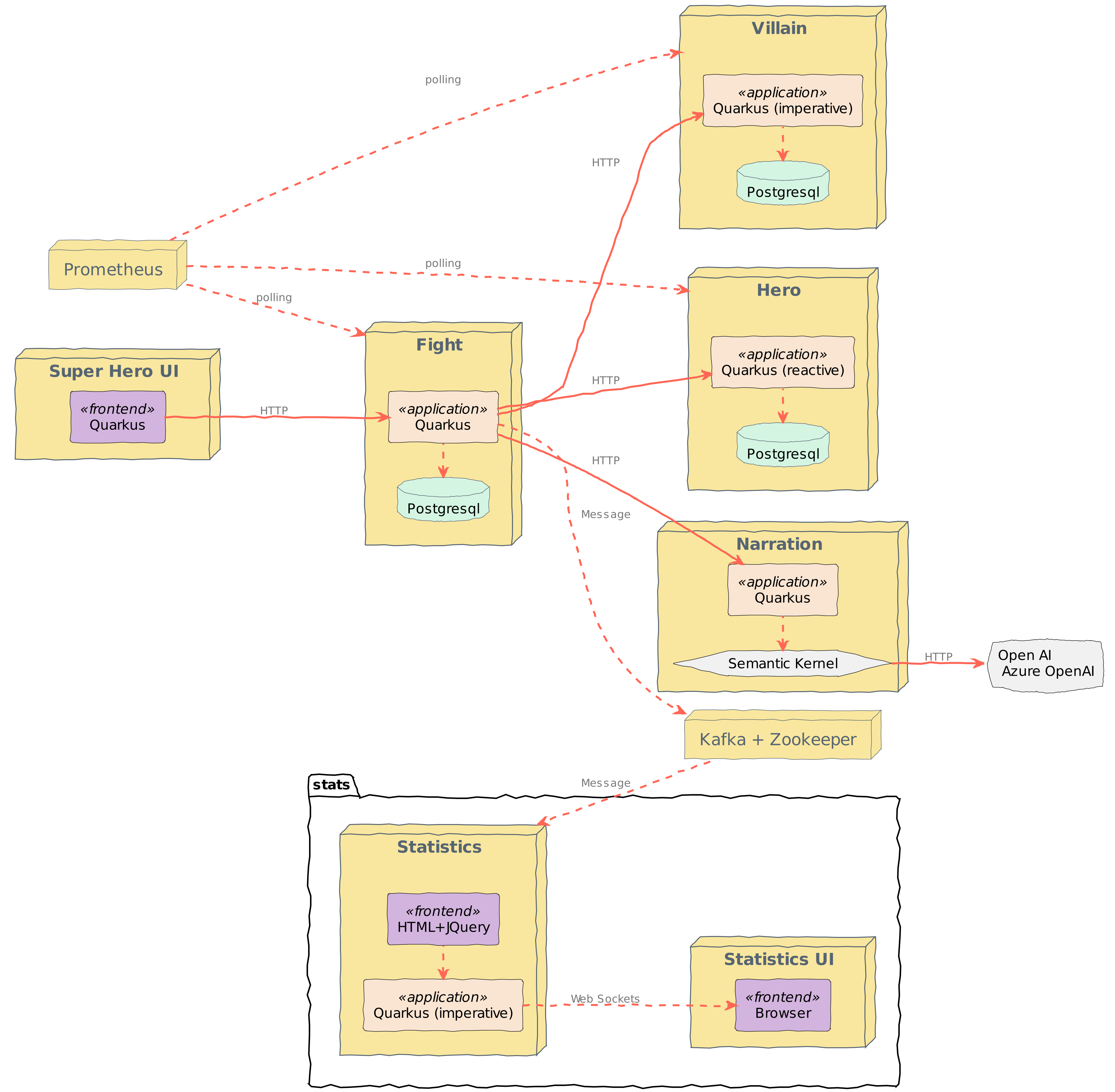
The main UI allows you to pick up one random Hero and Villain by clicking on "New Fighters." Then it’s just a matter of clicking on "Fight!" to get them to fight. If you click on "Narrate the Fight", you will have some AI-generated text describing the fight. The table at the bottom shows the list of the previous fights.
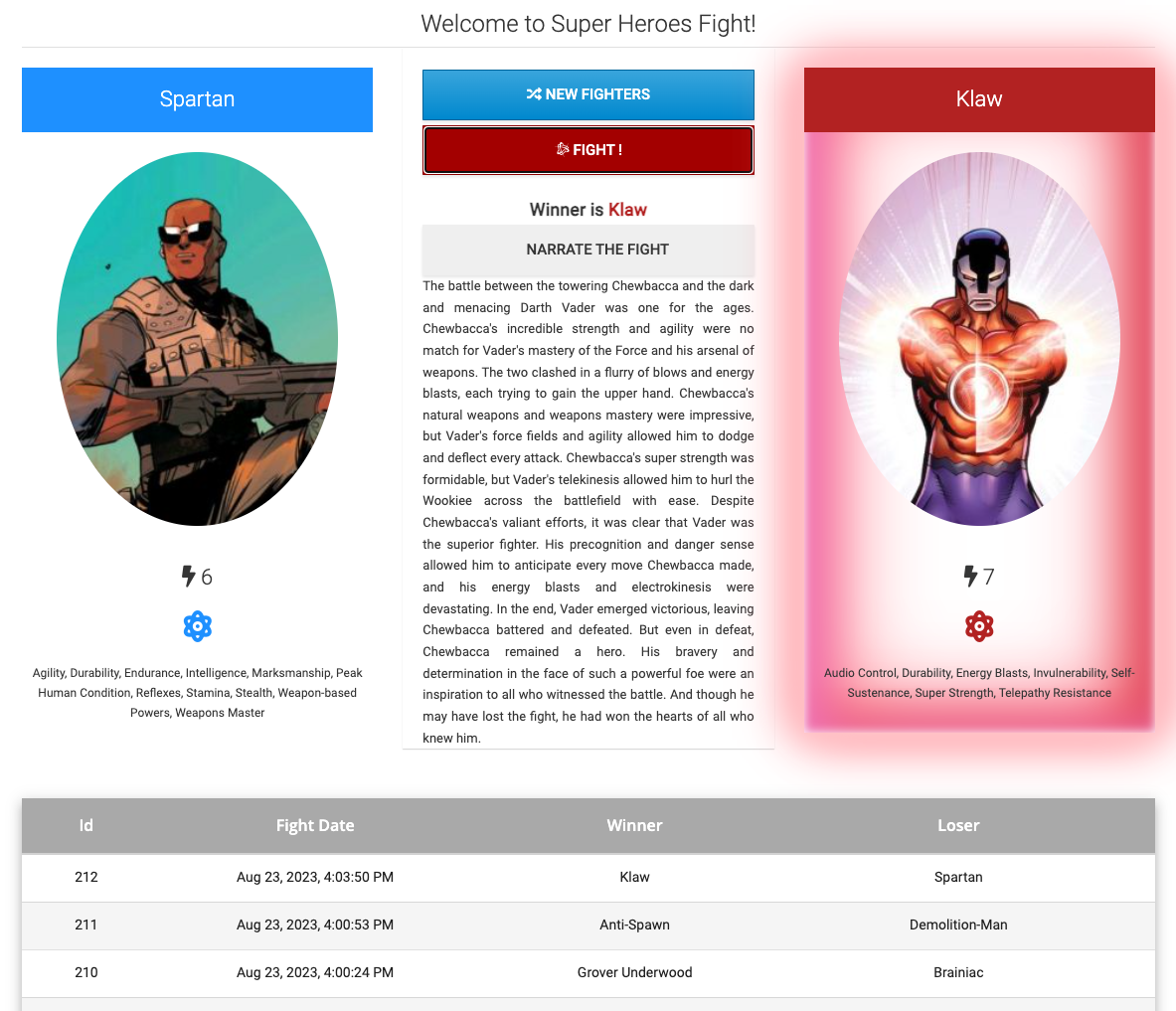
The Statistics UI shows the number of fights per hero and villain.
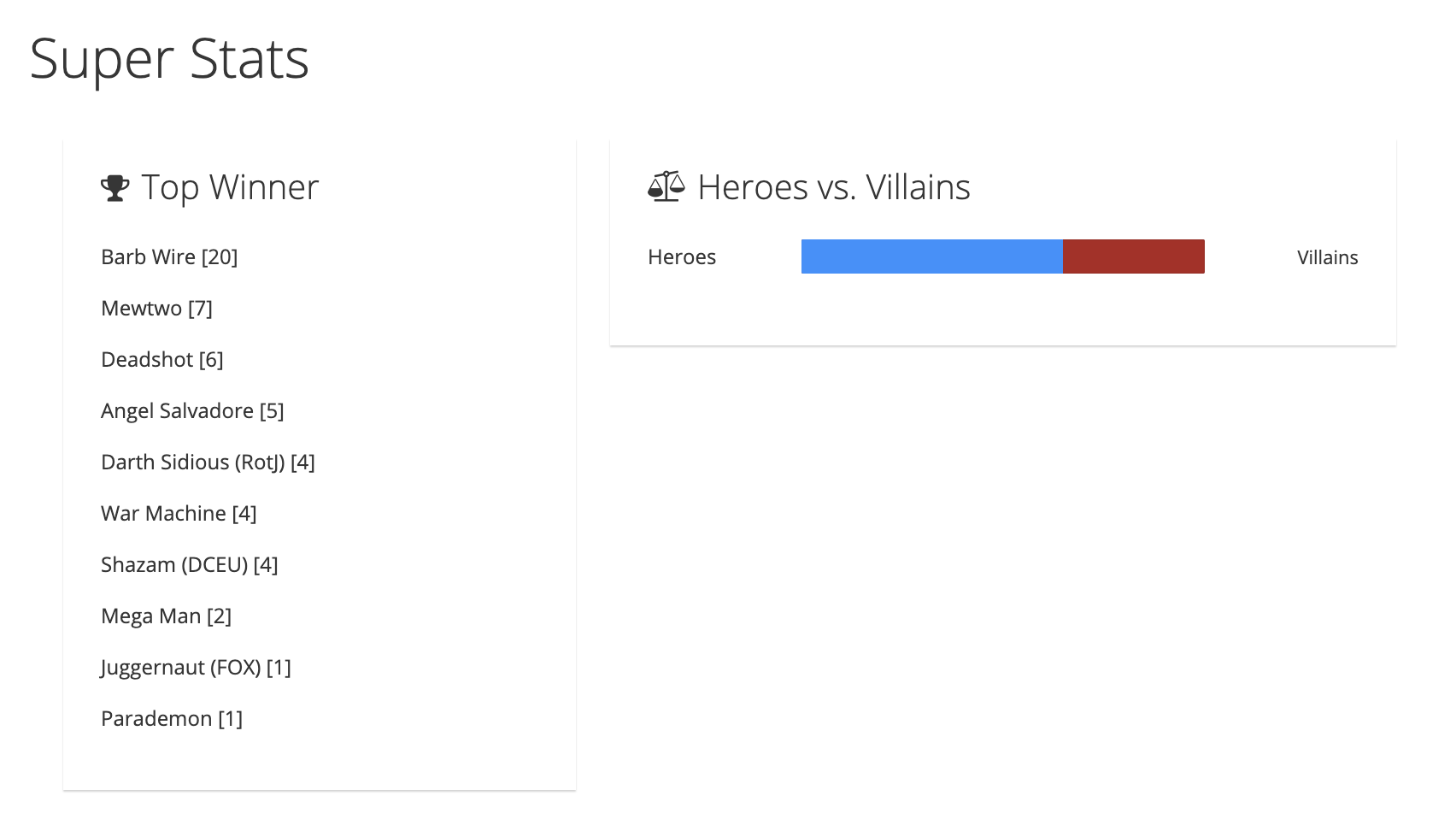
How Does This Workshop Work?
You have this material in your hands (either electronically or printed), and you can now follow it step by step. The structure of this workshop is as follows:
-
Installing all the needed tools: in this section, you will install all the tools and code to be able to develop, compile and execute our application
-
Developing microservices with Quarkus: in this section, you will develop a microservice architecture by creating several Maven projects, write some Java code, add JPA entities, JAX-RS REST endpoints, write some tests, use a React web application, and all that on Quarkus
-
Artificial Intelligence: in this section, you will use OpenAI or Azure OpenAI to invoke an AI so you can generate a random narration of the fight
-
Event-driven and Reactive microservices: in this section, you will create a reactive microservice and an event-driven microservice using Kafka
-
Build native executables: in this section, you will build native executables of all the microservices thanks to GraalVM
-
Containers: in this section, you will create Docker images of all the microservices
-
Cloud: once the microservices are all containerize, you can deploy them to Kubernetes
-
Azure Container Apps and Quarkus: this section introduces Quarkus and Azure Container Apps to make sure you have all the needed vocabulary to follow along
-
Running the Application Locally: in this section, you will build Docker images out of Quarkus microservices, execute them locally with Docker compose, push them to Azure Registry, all that using Docker and Azure CLI
-
Running the Application on Azure Container Apps: in this section, you will create an entire infrastructure on Azure (Postgres databases, Kafka, etc.) and deploy the microservices to Azure Container Apps
-
Command Line Interface: in this section, you will create a command line application with Quarkus
-
Extending Quarkus: in this section, you will create a Quarkus extension
If you already have the tools installed, skip the Installing all the needed tools section and jump to the section Developing with Quarkus, and start hacking some code and add-ons. This "à la carte" mode lets you make the most of this 6-hour long hands-on lab.
What Do You Have to Do?
This workshop should be as self-explanatory as possible. So your job is to follow the instructions by yourself, do what you are supposed to do, and do not hesitate to ask for any clarification or assistance; that’s why the team is here.
You will download a zip file (quarkus-super-heroes-workshop.zip) containing some of the code and you will need to complete it.
Oh, and be ready to have some fun!
Software Requirements
First of all, make sure you have a 64-bit computer with admin rights (so you can install all the needed tools) and at least 8Gb of RAM (as some tools need a few resources).
|
If you are using Mac OS X, make sure the version is greater than 10.11.x (El Capitan). |
This workshop will make use of the following software, tools, frameworks that you will need to install and know (more or less) how it works:
-
Any IDE you feel comfortable with (eg. Intellij IDEA, Eclipse IDE, VS Code..)
-
JDK 17
-
GraalVM 22.3
-
Docker or Podman
-
cURL (should already be installed in your OS, if not, check the appendix for installation instructions) and
jq -
OpenAI or Azure OpenAI keys
-
An Azure subscription and the Azure CLI
We will also be using Maven 3.9.x, but there is no need to install it.
Instead, the workshop scaffolding includes a maven wrapper, mvnw.
If you’d prefer to install your own Maven and don’t already have it, see the instructions at the end of the workshop.
The following section focuses on how to install and set up the needed software. You can skip the next section if you have already installed all the prerequisites.
|
This workshop assumes a bash shell. If you run on Windows, in particular, adjust the commands accordingly or install WSL. |
Installing Software
JDK 17
Essential for the development and execution of this workshop is the Java Development Kit (JDK).[1]
The JDK includes several tools such as a compiler (javac), a virtual machine, a documentation generator (`JavaDoc), monitoring tools (Visual VM) and so on[2].
The code in this workshop uses JDK 17.
Installing the JDK
To install the JDK 17, follows the instructions from https://adoptium.net/installation.html to download and install the JDK for your platform.
There is also an easier way to download and install Java if you are on Mac OS X: using SDKMAN!.
SDKMAN![3] is a tool for managing parallel versions of multiple Software Development Kits (SDK) on most Unix based systems.
It provides a convenient Command Line Interface (CLI) and API for installing, switching, removing and listing Candidates.
Developers often need to manage parallel versions of different builds of SDKs in their environment and switch from one to another.
Manually setting the PATH variable can become quickly painful.
That’s when SDKMAN! can help you.
Installing SDKMAN!
Installing SDKMAN! is easy. On Bash and ZSH shells simply open a new terminal and enter:
$ curl -s "https://get.sdkman.io" | bashFollow the instructions on-screen to complete installation.
Listing Java Versions
To install Java, we need to list the available versions on SDKMAN! using the list command.
The result is a table of entries grouped by the vendor and sorted by version:
$ sdk list java
==========================================================================
Available Java Versions for macOS ARM 64bit
==========================================================================
Vendor | Use | Version | Dist | Status | Identifier
--------------------------------------------------------------------------
Corretto | | 19.0.1 | amzn | | 19.0.1-amzn
....
Microsoft | | 17.0.5 | ms | | 17.0.5-ms
...
Oracle | | 19.0.1 | oracle | | 19.0.1-oracle
...
Temurin | | 19.0.1 | tem | | 19.0.1-tem
| >>> | 17.0.5 | tem | installed | 17.0.5-tem
| | 11.0.17 | tem | installed | 11.0.17-tem
==========================================================================If you have any Java candidate installed, you should see installed in the Status column.
If you don’t have any Java candidate installed, use SDKMAN! to install one or several.
Installing Java 17
There are several different vendors of Java, and each vendor has its own distribution. Most of these distributions are available on SDKMAN! and can easily be installed. Let’s install Temurin.
To install Temurin 17, we copy its identifier (17-tem), which is the version from the table, and we add it as an argument in the install command:
$ sdk install java 17-tem
Downloading: java 17-tem
Repackaging Java 17-tem...
Installing: java 17-tem
Done installing!
Do you want java 17-tem to be set as default? (Y/n):For Linux distributions, there are also packaged java installations.
# dnf (rpm-based)
dnf install java-17-openjdk
# Debian-based distributions:
$ apt-get install openjdk-17-jdkChecking for Java Installation
Once the installation is complete, it is necessary to set the JAVA_HOME variable and the $JAVA_HOME/bin directory to the PATH variable.
Check that your system recognizes Java by entering java -version and the Java compiler with javac -version.
$ java -version
openjdk version "17.0.5" 2022-10-18
OpenJDK Runtime Environment GraalVM CE 22.3.0 (build 17.0.5+8-jvmci-22.3-b08)
OpenJDK 64-Bit Server VM GraalVM CE 22.3.0 (build 17.0.5+8-jvmci-22.3-b08, mixed mode, sharing)
$ javac -version
javac 17.0.5Docker or Podman
Docker is a set of utilities that use OS-level virtualization to deliver software in packages called containers. Containers are isolated from one another and bundle their software, libraries, and configuration files; they can communicate with each other through well-defined channels.
Installing Docker
Quarkus use Testcontainers, and therefore also Docker, to ease the management of different technical services (database, monitoring…) during development.
Our workshop also uses Docker to manage these services in a production-style deployment.
So for this, we need to install docker and docker compose
Installation instructions are available on the following page:
-
Mac OS X - https://docs.docker.com/docker-for-mac/install/ (version 20+)
-
Windows - https://docs.docker.com/docker-for-windows/install/ (version 20+)
-
CentOS - https://docs.docker.com/install/linux/docker-ce/centos/
-
Debian - https://docs.docker.com/install/linux/docker-ce/debian/
-
Fedora - https://docs.docker.com/install/linux/docker-ce/fedora/
-
Ubuntu - https://docs.docker.com/install/linux/docker-ce/ubuntu/
On Linux, don’t forget the post-execution steps described on https://docs.docker.com/install/linux/linux-postinstall/.
If you do not have a Docker licence, you might prefer podman (https://podman.io/) instead of docker. To install podman and podman-compose please follow the instructions at https://quarkus.io/guides/podman. Do not forget the extra steps to configure the testcontainers library. As a convenience you can even alias docker to podman.
|
Checking for Docker Installation
Once installed, check that both docker and docker compose are available in your PATH.
For that, execute the following commands:
$ docker versionYou should see something like this:
Docker version 20.10.8, build 3967b7d
Cloud integration: v1.0.24
Version: 20.10.14
API version: 1.41Then, check the Docker Compose version:
$ docker compose versionDocker compose being a separate utility, you should get a different version than Docker itself:
Docker Compose version v2.5.0Finally, run your first container as follows:
$ docker run hello-worldFor the first time, this will download the hello-world image from the Docker Hub and run it.
You should get something like this:
Hello from Docker!
This message shows that your installation appears to be working correctly.
To generate this message, Docker took the following steps:
1. The Docker client contacted the Docker daemon.
2. The Docker daemon pulled the "hello-world" image from the Docker Hub.
(amd64)
3. The Docker daemon created a new container from that image which runs the
executable that produces the output you are currently reading.
4. The Docker daemon streamed that output to the Docker client, which sent it
to your terminal.
To try something more ambitious, you can run an Ubuntu container with:
$ docker run -it ubuntu bash
Share images, automate workflows, and more with a free Docker ID:
https://hub.docker.com/
For more examples and ideas, visit:
https://docs.docker.com/get-started/Some Docker Commands
Docker is a command-line utility where you can use several parameters and options to start/stop a container.
You invoke docker with zero, one, or several command-line options with the container or image ID you want to work with.
Docker comes with several options that are described in the documentation if you need more help.[4]
To get some help on the commands and options, you can type, use the following command:
$ docker help
Usage: docker [OPTIONS] COMMAND
$ docker help attach
Usage: docker attach [OPTIONS] CONTAINER
Attach local standard input, output, and error streams to a running containerHere are some commands that you will be using to start/stop containers in this workshop.
-
docker container ls: Lists containers. -
docker container start CONTAINER: Starts one or more stopped containers. -
docker compose -f docker-compose.yaml up -d: Starts all containers defined in a Docker Compose file. -
docker compose -f docker-compose.yaml down: Stops all containers defined in a Docker Compose file.
jq
Very often, when using cURL to invoke a RESTful web service, we get some JSON payload. cURL does not format this JSON so that you will get a flat String such as:
curl http://localhost:8083/api/heroes
[{"id":"1","name":"Chewbacca","level":"14"},{"id":"2","name":"Wonder Woman","level":"15"},{"id":"3","name":"Anakin Skywalker","level":"8"}]But what we want is to format the JSON payload, so it is easier to read.
For that, there is a neat utility tool called jq that we could use.
jq is a tool for processing JSON inputs, applying the given filter to its JSON text inputs, and producing the filter’s results as JSON on standard output.[5]
Installing jq
You can install it on Mac OSX with a simple brew install jq.
Checking for jq Installation
Once installed, it’s just a matter of piping the cURL output to jq like this:
curl http://localhost:8083/api/heroes | jq
[
{
"id": "1",
"name": "Chewbacca",
"lastName": "14"
},
{
"id": "2",
"name": "Wonder Woman",
"lastName": "15"
},
{
"id": "3",
"name": "Anakin Skywalker",
"lastName": "8"
}
]GraalVM 22.3
GraalVM extends the Java Virtual Machine (JVM) to support more languages and several execution modes.[6] It supports a large set of languages: Java of course, other JVM-based languages (such as Groovy, Kotlin etc.) but also JavaScript, Ruby, Python, R and C/C++. It includes a high-performance Java compiler, which can be used in a Just-In-Time (JIT) configuration on the HotSpot VM or in an Ahead-Of-Time (AOT) configuration with the GraalVM native compiler. One objective of GraalVM is to improve the performance of Java virtual machine-based languages to match the performance of native languages.
Prerequisites for GraalVM
On Linux, you need GCC and the Glibc and zlib headers. Examples for common distributions:
# dnf (rpm-based)
sudo dnf install gcc glibc-devel zlib-devel
# Debian-based distributions:
sudo apt-get install build-essential libz-dev zlib1g-devOn macOS X there are several ways to install GraalVM. But using SDKMAN! is the preferred option, as it allows you to easily switch between different versions of GraalVM if needed.
On Windows, you need the Developer Command Prompt for Microsoft Visual C++. Check the Windows prerequisites page for details.
Installing GraalVM
Listing GraalVM Versions
First of all, check if you already have the GraalVM Candidates installed on your machine.
To list the available versions of GraalVM, use the SDKMAN! list java command.
The result is a table of entries grouped by the vendor and sorted by version.
GraalVM has its own group and is listed under the GraalVM vendor:
$ sdk list java
=======================================================================
Available Java Versions for macOS ARM 64bit
=======================================================================
Vendor | Use | Version | Dist | Status | Identifier
-----------------------------------------------------------------------
GraalVM | | 22.3.r19 | grl | | 22.3.r19-grl
| | 22.3.r17 | grl | | 22.3.r17-grl
| | 22.3.r11 | grl | | 22.3.r11-grl
| | 22.2.r17 | grl | | 22.2.r17-grl
| | 22.2.r11 | grl | | 22.2.r11-grl
| | 22.1.0.r17 | grl | | 22.1.0.r17-grl
| | 22.1.0.r11 | grl | | 22.1.0.r11-grl
=======================================================================If you have any GraalVM candidate installed, you should see installed in the Status column.
If you don’t have any GraalVM candidate installed, use SDKMAN! to install one or several.
Installing a GraalVM Version
There are several versions of GraalVM available for different versions of the JDK.
Because we are using Java 17 in this fascicle, we will install the version of GraalVM that is compatible with Java 17 (the versions finishing with r17-grl).
Let’s install GraalVM 22.3.
$ sdk install java 22.3.r17-grl
Downloading: java 22.3.r17-grl
Repackaging Java 22.3.r17-grl...
Installing: java 22.3.r17-grl
Done installing!
Do you want java 22.3.r17-grl to be set as default? (Y/n):Once installed, define the GRAALVM_HOME environment variable to point to the directory where GraalVM is installed (eg. on Mac OS X it could be ~/.sdkman/candidates/java/22.3.r17-grl).
|
Mac OS X - Catalina
On Mac OS X Catalina, the installation of the |
Checking for GraalVM Installation
Once installed and set up, you should be able to run the following command and get something like the following output.
$ $GRAALVM_HOME/bin/native-image --versionYou should get something like:
native-image 22.0.2 2024-07-16
OpenJDK Runtime Environment Mandrel-24.0.2.0-Final (build 22.0.2+9)
OpenJDK 64-Bit Server VM Mandrel-24.0.2.0-Final (build 22.0.2+9, mixed mode)OpenAI or Azure OpenAI Subscriptions
The Narration microservice needs to access an AI service to generate the text narrating the fight. You can choose between OpenAI or Azure OpenAI. Azure OpenAI, or "OpenAI on Azure" is a service that provides REST API access to OpenAI’s models, including the GPT-4, GPT-3, Codex and Embeddings series. The difference between OpenAI and Azure OpenAI is that it runs on Azure global infrastructure, which meets your production needs for critical enterprise security, compliance, and regional availability.
OpenAI
OpenAI is a leading artificial intelligence research organization creating cutting-edge AI technologies. OpenAI offers a range of APIs that enable developers to integrate AI capabilities into their applications. Some of these APIs include:
-
GPT API: This API provides access to the GPT-3 and 4 language model
-
Codex API: This API provides access to the Codex model, which is a language model trained on a dataset of public code
-
DALL-E API: This API provides access to the DALL-E model, which is a language model trained on a dataset of text-image pairs
We will be using the GPT-3 API to generate the text narrating the fight.
First, you need to have an OpenAI subscription and then generate an API key. Then you need to ge the organisation id and key to invoke the API. To get the organisation id, go to OpenAI organisation settings and copy the organisation id.:
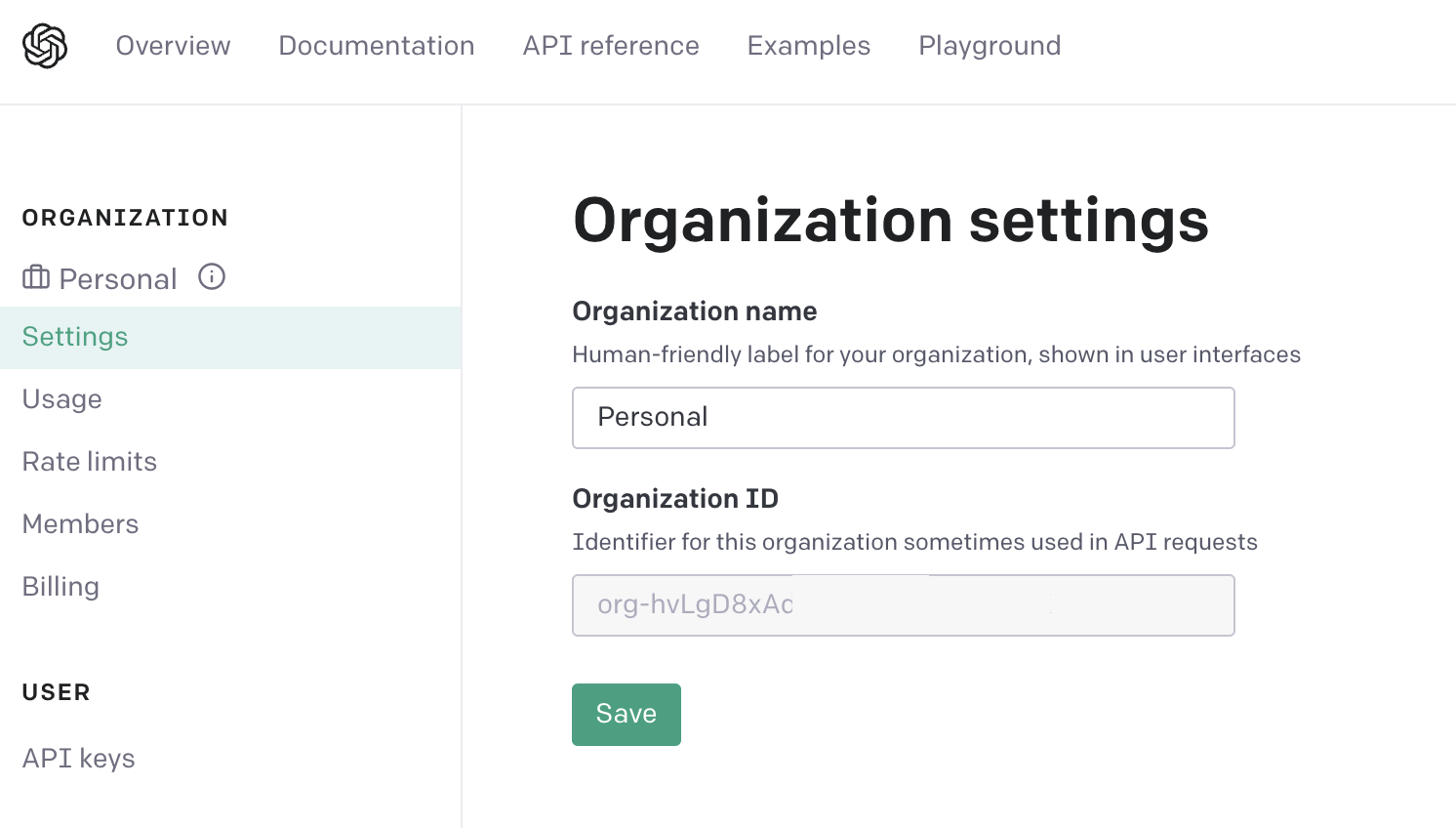
Then, to get the API key, go to OpenAI API keys and copy the API key:
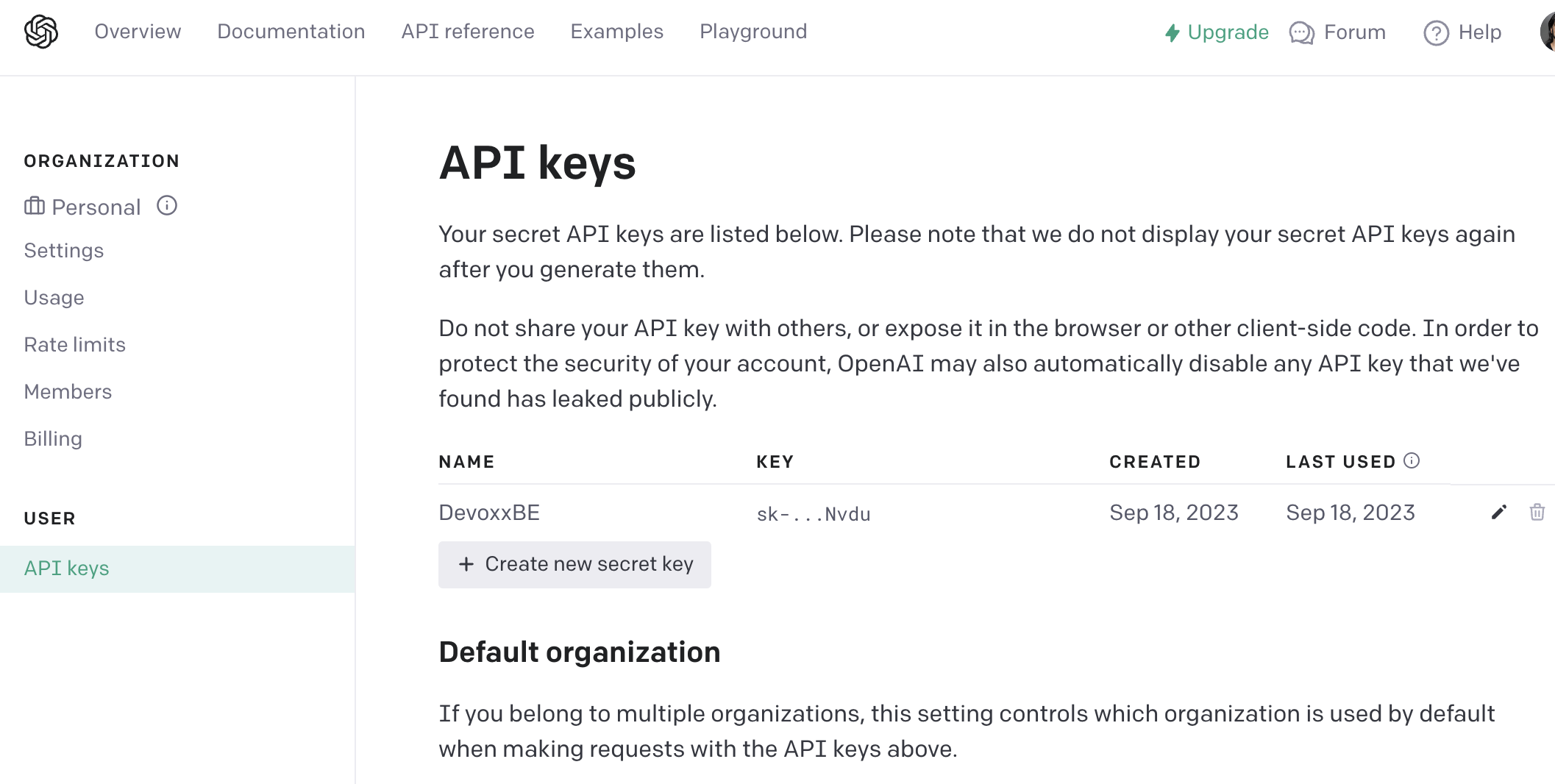
You will have to credit your OpenAI account with some money to be able to use the API.
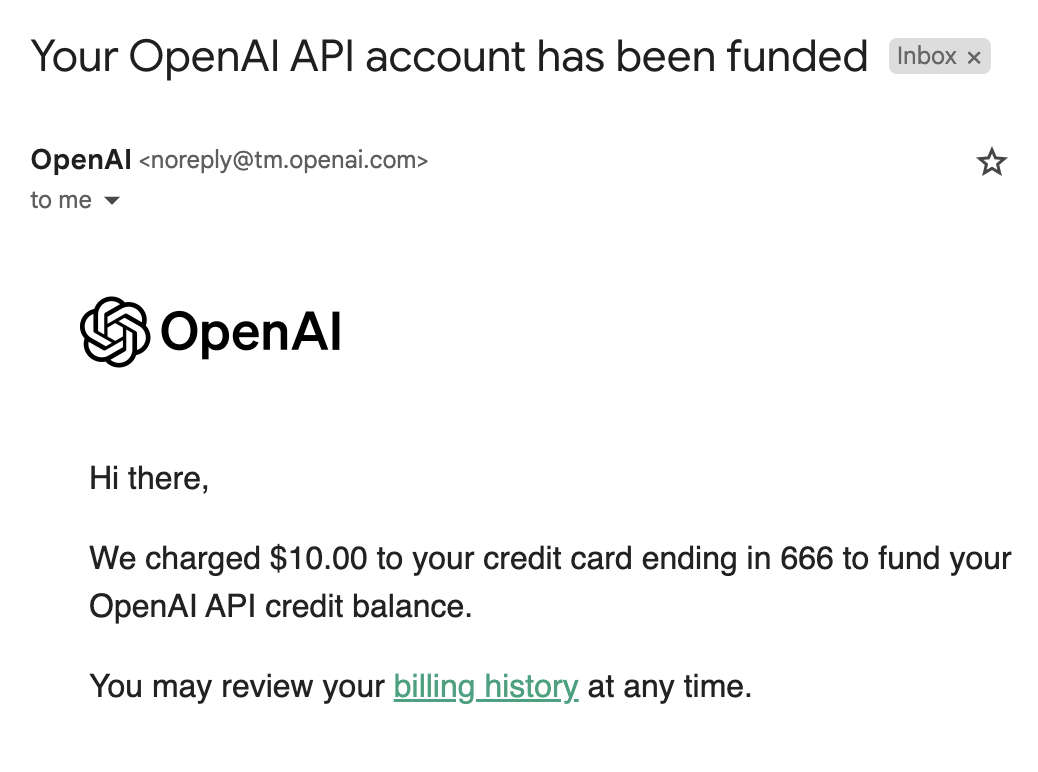
Azure OpenAI
If you already have an Azure subscription, you can use it to create an Azure OpenAI resource. Otherwise, you can create a free Azure subscription and use it to create an Azure OpenAI resource. Then, you need to use the Azure OpenAI service to generate the API key and endpoint URL. You can either do that using the Azure Portal or the Azure CLI.
The easiest being use the Azure CLI, we recommend that you install it and use it to create the Azure OpenAI resource and generate the API key and endpoint URL. Once Azure CLI is installed and you have your Azure subscription, sign in to your Azure account:
az login|
If you have several Azure subscription, make sure you are using the right one. For that, you can execute the following command to list all your subscriptions and set the one you want to use: |
Then, execute the following command to create the Azure OpenAI resources:
echo "Setting up environment variables..."
echo "----------------------------------"
PROJECT="<give-your-project-a-name>"
RESOURCE_GROUP="rg-$PROJECT"
LOCATION="eastus"
TAG="$PROJECT"
COGNITIVE_SERVICE="cognit-$PROJECT"
COGNITIVE_DEPLOYMENT="gpt35turbo"
echo "Creating the resource group..."
echo "------------------------------"
az group create \
--name "$RESOURCE_GROUP" \
--location "$LOCATION" \
--tags system="$TAG"
echo "Creating the Cognitive Service..."
echo "---------------------------------"
az cognitiveservices account create \
--name "$COGNITIVE_SERVICE" \
--resource-group "$RESOURCE_GROUP" \
--location "$LOCATION" \
--custom-domain "$COGNITIVE_SERVICE" \
--tags system="$TAG" \
--kind "OpenAI" \
--sku "S0"
echo "Deploying the model..."
echo "----------------------"
az cognitiveservices account deployment create \
--name "$COGNITIVE_SERVICE" \
--resource-group "$RESOURCE_GROUP" \
--deployment-name "$COGNITIVE_DEPLOYMENT" \
--model-name "gpt-35-turbo" \
--model-version "0301" \
--model-format "OpenAI" \
--sku-capacity 1 \
--sku-name "Standard"This script will create the Azure OpenAI resource and deploy the model. Once the script has executed, you can use the following command to get the API key and endpoint URL. You will need these properties later one when you will configure the Narration microservice:
echo "Storing the key and endpoint in environment variables..."
echo "--------------------------------------------------------"
AZUREOPENAI_KEY=$(
az cognitiveservices account keys list \
--name "$COGNITIVE_SERVICE" \
--resource-group "$RESOURCE_GROUP" \
| jq -r .key1
)
AZUREOPENAI_ENDPOINT=$(
az cognitiveservices account show \
--name "$COGNITIVE_SERVICE" \
--resource-group "$RESOURCE_GROUP" \
| jq -r .properties.endpoint
)
# Set the properties
echo "--------------------------------------------------"
echo "The following properties can be copied to either the rest-narration/src/main/resources/conf.properties or to the ~/.sk/conf.properties file:"
echo "--------------------------------------------------"
echo "client.azureopenai.key=$AZUREOPENAI_KEY"
echo "client.azureopenai.endpoint=$AZUREOPENAI_ENDPOINT"
echo "client.azureopenai.deploymentname=$COGNITIVE_DEPLOYMENT"Once you’ve finished the workshop, remember to delete the Azure OpenAI resources to avoid being charged for it:
# Clean up
az group delete \
--name "$RESOURCE_GROUP" \
--yes
az cognitiveservices account purge \
--name "$COGNITIVE_SERVICE" \
--resource-group "$RESOURCE_GROUP" \
--location "$LOCATION"
az cognitiveservices account delete \
--name "$COGNITIVE_SERVICE" \
--resource-group "$RESOURCE_GROUP"WSL
Windows Subsystem for Linux (WSL) lets developers run a GNU/Linux environment — including most command-line tools, utilities, and applications — directly on Windows, unmodified, without the overhead of a traditional virtual machine or dual-boot setup.
|
If you are using Windows, it is recommended to install WSL as all the commands use bash. |
Installing WSL
You can install everything you need to run Windows Subsystem for Linux (WSL) by entering this command in an administrator PowerShell or Windows Command Prompt and then restarting your machine:
wsl --installThis command will enable the required optional components, download the latest Linux kernel, set WSL 2 as your default, and install a Linux distribution for you (Ubuntu by default).
The first time you launch a newly installed Linux distribution, a console window will open and you’ll be asked to wait for files to de-compress and be stored on your machine. All future launches should take less than a second.
Azure CLI
The Azure command-line interface (Azure CLI) is a set of commands used to create and manage Azure resources. The Azure CLI is available across Azure services and is designed to get you working quickly with Azure, with an emphasis on automation. For this workshop you need to have Azure CLI installed locally on your machine.
Installing Azure CLI
The Azure CLI is available to install in Windows, macOS and Linux environments. It can also be run in a Docker container and Azure Cloud Shell. On Mac OS X, the easiest way to install Azure CLI is by executing the following command:
brew install azure-cliChecking for Azure CLI Installation
Once the installation is complete, you can execute a few commands to be sure the Azure CLI is correctly installed:
az version
az --versionSome Azure CLI Commands
Azure CLI is a command-line utility where you can use several parameters and options to create, query, or delete Azure resources. To get some help on the commands, you can type:
az help
az --help
az vm --help
az vm disk --help
az vm disk attach --helpRecap
Before going further, make sure the following commands work on your machine.
java -version
$GRAALVM_HOME/bin/native-image --version
curl --version
docker version
docker compose version
az --versionWe have not mentioned cURL up to now, because most modern operating systems ship with it pre-installed. If your system is missing cURL, the appendix includes instructions for installing cURL.
And also make sure to have your OpenAI or Azure credentials ready if you want to develop the "Narration" microservice.
Preparing for the Workshop
In this workshop, you will be developing an application dealing with Super Heroes (and Super-Villains 🦹) as well as Quarkus extensions. The code will be separated into two different directories:
Download the workshop scaffolding
We’ve done some of the layout for you. First, download the zip file https://raw.githubusercontent.com/quarkusio/quarkus-workshops/refs/heads/main/quarkus-workshop-super-heroes/dist/quarkus-super-heroes-workshop.zip, and unzip it wherever you want. This zip file contains some of the code of the workshop, along with assets you will need to complete it.
Super Heroes Application
Under the super-heroes directory you will find the entire Super Hero application spread throughout a set of subdirectories, each one containing a microservice or some tooling.
The final structure will be the following (don’t worry if you don’t have all this yet, this is what we’re aiming towards):

Most of these subdirectories are Maven projects and follow the Maven directory structure:
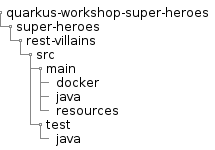
Checking Ports
During this workshop, we will use several ports.
Use lsof to make sure the following ports are free, so you don’t run into any conflicts.
lsof -i tcp:8080 # UI
lsof -i tcp:8082 # Fight REST API
lsof -i tcp:8083 # Hero REST API
lsof -i tcp:8084 # Villain REST API
lsof -i tcp:8085 # Statistics REST API
lsof -i tcp:8086 # Narration REST API
lsof -i tcp:5432 # Postgres
lsof -i tcp:2181 # Zookeeper
lsof -i tcp:9092 # KafkaReady?
After the prerequisites have been installed and the environment has been checked, it’s now time to write some code!
Creating a classical REST/HTTP Microservice
At the heart of the Super-Hero application comes Villains! You can’t have superheroes without super-villains.
We need to expose a REST API allowing CRUD operations on villains. This microservice is, let’s say, a classical REST microservice. It uses HTTP to expose a REST API and internally store data into a database. It’s using the imperative development model.
The fight microservice will use this service.
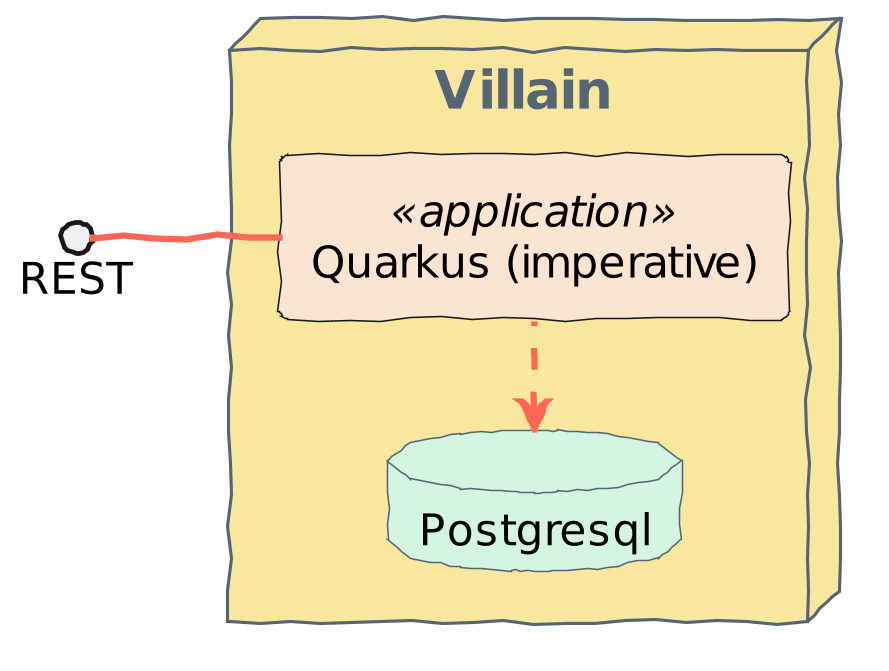
In the following sections, you learn:
-
How to create a new Quarkus application
-
How to implement REST API using JAX-RS and the Quarkus REST extension [7]
-
How to compose your application using beans
-
How to access your database using Hibernate ORM with Panache
-
How to use transactions
-
How to enable OpenAPI and Swagger-UI
| This service is exposed on the port 8084. |
But first, let’s describe our service. The Super-Villains microservice manages villains with their names, powers, and so on. The REST API allows adding, removing, listing, and picking a random villain from the stored set. Nothing outstanding but a good first step to discover Quarkus.
Villain Microservice
First thing first, we need a project. That’s what you are going to see in this section.
Bootstrapping the Villain REST Endpoint
The easiest way to create a new Quarkus project is to use the Quarkus Maven plugin.
Open a terminal and run the following command under the quarkus-workshop-super-heroes/super-heroes directory:
./mvnw io.quarkus:quarkus-maven-plugin:3.27.0:create \
-DplatformVersion=3.27.0 \
-DprojectGroupId=io.quarkus.workshop.super-heroes \
-DprojectArtifactId=rest-villains \
-DclassName="io.quarkus.workshop.superheroes.villain.VillainResource" \
-Dpath="api/villains" \
-Dextensions="rest-jackson"|
Notice that we scaffold the project with Quarkus REST ( |
Remember that mvnw is the maven wrapper. It behaves like mvn,
but allows a project’s build dependencies to be encapsulated.
The last line selects the extension we want to use.
As a start, we only select rest-jackson, which will also import rest.
If you want your IDE to manage this new Maven project, you can declare it in the parent POM (quarkus-super-heroes/pom.xml) by adding this new module in the <modules> section:
<module>super-heroes/rest-villains</module>|
Prefer a Web UI?
Instead of the Maven command, you can use https://code.quarkus.io and select the |
Directory Structure
Once you bootstrap the project, you get the following directory structure with a few Java classes and other artifacts :
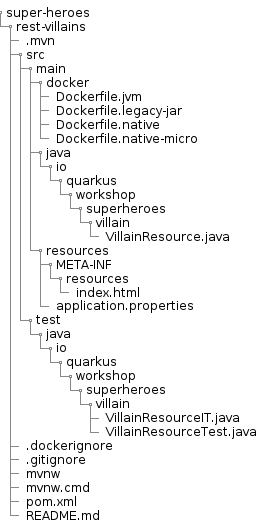
The Maven archetype generates the following rest-villains sub-directory:
-
The Maven structure with a
pom.xml -
An
io.quarkus.workshop.superheroes.villain.VillainResourceresource exposed on/api/villains -
An associated unit test
VillainResourceTest -
The landing page
index.htmlthat is accessible on http://localhost:8080 after starting the application -
Example
Dockerfilefiles for both native and JVM modes insrc/main/docker -
The
application.propertiesconfiguration file
Once generated, look at the pom.xml.
You will find the import of the Quarkus BOM, allowing you to omit the version on the different Quarkus dependencies.
In addition, you can see the quarkus-maven-plugin responsible for the packaging of the application and providing the development mode.
<project>
<!-- ... -->
<properties>
<compiler-plugin.version>3.11.0</compiler-plugin.version>
<maven.compiler.release>17</maven.compiler.release>
<project.build.sourceEncoding>UTF-8</project.build.sourceEncoding>
<project.reporting.outputEncoding>UTF-8</project.reporting.outputEncoding>
<quarkus.platform.artifact-id>quarkus-bom</quarkus.platform.artifact-id>
<quarkus.platform.group-id>io.quarkus</quarkus.platform.group-id>
<quarkus.platform.version>3.27.0</quarkus.platform.version>
<skipITs>true</skipITs>
<surefire-plugin.version>3.5.3</surefire-plugin.version>
</properties>
<!-- ... -->
<dependencyManagement>
<dependencies>
<dependency>
<groupId>${quarkus.platform.group-id}</groupId>
<artifactId>${quarkus.platform.artifact-id}</artifactId>
<version>${quarkus.platform.version}</version>
<type>pom</type>
<scope>import</scope>
</dependency>
</dependencies>
</dependencyManagement>
<!-- ... -->
<build>
<plugins>
<plugin>
<groupId>${quarkus.platform.group-id}</groupId>
<artifactId>quarkus-maven-plugin</artifactId>
<version>${quarkus.platform.version}</version>
<extensions>true</extensions>
<executions>
<execution>
<goals>
<goal>build</goal>
<goal>generate-code</goal>
<goal>generate-code-tests</goal>
</goals>
</execution>
</executions>
</plugin>
<!-- ... -->
</plugins>
</build>
<!-- ... -->
</project>If we focus on the dependencies section, you can see the extensions allowing the development of REST applications (rest and rest-jackson)
<dependencies>
<dependency>
<groupId>io.quarkus</groupId>
<artifactId>quarkus-arc</artifactId>
</dependency>
<dependency>
<groupId>io.quarkus</groupId>
<artifactId>quarkus-rest</artifactId>
</dependency>
<dependency>
<groupId>io.quarkus</groupId>
<artifactId>quarkus-rest-jackson</artifactId>
</dependency>
<!-- ... -->
</dependencies>-
quarkus-arcis the dependency injection framework integrated into Quarkus. It’s designed to perform build-time injections. We will see later why this is essential for Quarkus. -
quarkus-restis the framework we will use to implement our REST API. It uses JAX-RS annotations such as@Path,@GET… -
quarkus-rest-jacksonadds JSON object mapping capabilities to Quarkus REST.
The Villain Resource
During the project creation, the VillainResource.java file has been created with the following content:
package io.quarkus.workshop.superheroes.villain;
import jakarta.ws.rs.GET;
import jakarta.ws.rs.Path;
import jakarta.ws.rs.Produces;
import jakarta.ws.rs.core.MediaType;
@Path("/api/villains")
public class VillainResource {
@GET
@Produces(MediaType.TEXT_PLAIN)
public String hello() {
return "Hello from Quarkus REST";
}
}It’s a very simple REST endpoint returning a "Hello World" to requests on /api/villains.
It uses JAX-RS annotations:
-
@Pathindicates the HTTP path handled by the resource, -
@GETindicates that the method should be called when receiving aGETrequest on/api/villains.
Methods can also have their own @Path annotation suffixed to the class one (if any).
|
Running the Application
Now we are ready to run our application.
Use: ./mvnw quarkus:dev in the rest-villains directory:
$ ./mvnw quarkus:dev
[INFO] Scanning for projects...
[INFO]
[INFO] -----------< io.quarkus.workshop.super-heroes:rest-villains >-----------
[INFO] Building rest-villains 1.0.0-SNAPSHOT
[INFO] --------------------------------[ jar ]---------------------------------
[INFO]
[INFO] --- quarkus-maven-plugin:3.27.0:dev (default-cli) @ rest-villains ---
[INFO] Invoking resources:3.27.0:resources (default-resources) @ rest-villains
[INFO] Copying 2 resources from src/main/resources to target/classes
[INFO] Invoking quarkus:3.27.0:generate-code (default) @ rest-villains
[INFO] Invoking compiler:3.11.0:compile (default-compile) @ rest-villains
[INFO] Nothing to compile - all classes are up to date
[INFO] Invoking resources:3.27.0:testResources (default-testResources) @ rest-villains
[INFO] skip non existing resourceDirectory /Users/agoncal/Documents/Code/Temp/quarkus-super-heroes/super-heroes/rest-villains/src/test/resources
[INFO] Invoking quarkus:3.27.0:generate-code-tests (default) @ rest-villains
[INFO] Invoking compiler:3.11.0:testCompile (default-testCompile) @ rest-villains
[INFO] Nothing to compile - all classes are up to date
Listening for transport dt_socket at address: 5005
__ ____ __ _____ ___ __ ____ ______
--/ __ \/ / / / _ | / _ \/ //_/ / / / __/
-/ /_/ / /_/ / __ |/ , _/ ,< / /_/ /\ \
--\___\_\____/_/ |_/_/|_/_/|_|\____/___/
2022-11-15 14:05:29,414 INFO [io.quarkus] (Quarkus Main Thread) rest-villains 1.0.0-SNAPSHOT on JVM (powered by Quarkus 3.27.0) started in 1.093s. Listening on: http://localhost:8080
2022-11-15 14:05:29,423 INFO [io.quarkus] (Quarkus Main Thread) Profile dev activated. Live Coding activated.
2022-11-15 14:05:29,423 INFO [io.quarkus] (Quarkus Main Thread) Installed features: [cdi, rest, rest-jackson, smallrye-context-propagation, vertx]
Tests paused
Press [r] to resume testing, [o] Toggle test output, [:] for the terminal, [h] for more options>Then check that the endpoint returns hello as expected:
curl http://localhost:8080/api/villainsYou should see the following
Hello from Quarkus RESTAlternatively, you can open http://localhost:8080/api/villains in your browser.
Development Mode
quarkus:dev runs Quarkus in development mode.
It enables hot deployment with background compilation, which means that when you modify your Java files or your resource files and invoke a REST endpoint (i.e., cURL command or refresh your browser), these changes will automatically take effect.
It works too for resource files like the configuration property and HTML files.
Refreshing the browser triggers a scan of the workspace, and if any changes are detected, the Java files are recompiled and the application is redeployed; your request is then serviced by the redeployed application.
If there are any issues with compilation or deployment an error page will let you know.
The development mode also allows debugging and listens for a debugger on port 5005.
If you want to wait for the debugger to attach before running, you can pass -Dsuspend=true on the command line.
If you don’t want the debugger at all, you can use -Ddebug=false.
Alright, time to change some code.
Open your favorite IDE and import the project.
To check that the hot reload is working, update the VillainResource.hello() method by returning the String "Hello Villain Resource".
Now, execute the cURL command again:
curl http://localhost:8080/api/villainsThe output has changed ("Hello Villain Resource") without you having to stop and restart Quarkus!
Testing the Application
All right, so far, so good, but wouldn’t it be better with a few tests, just in case.
In the generated pom.xml file, you can see two test dependencies:
<dependencies>
<!-- ... -->
<dependency>
<groupId>io.quarkus</groupId>
<artifactId>quarkus-junit5</artifactId>
<scope>test</scope>
</dependency>
<dependency>
<groupId>io.rest-assured</groupId>
<artifactId>rest-assured</artifactId>
<scope>test</scope>
</dependency>
</dependencies>So, we will use Junit 5 combined with RESTAssured, which eases the testing of REST applications.
If you look at the maven-surefire-plugin configuration in the pom.xml, you will see that we set the java.util.logging system property to ensure tests will use the correct method log manager.
<plugin>
<artifactId>maven-surefire-plugin</artifactId>
<version>${surefire-plugin.version}</version>
<configuration>
<systemPropertyVariables>
<java.util.logging.manager>org.jboss.logmanager.LogManager</java.util.logging.manager>
<maven.home>${maven.home}</maven.home>
</systemPropertyVariables>
</configuration>
</plugin>The generated project contains a simple test in VillainResourceTest.java.
package io.quarkus.workshop.superheroes.villain;
import io.quarkus.test.junit.QuarkusTest;
import org.junit.jupiter.api.Test;
import static io.restassured.RestAssured.given;
import static org.hamcrest.CoreMatchers.is;
@QuarkusTest
public class VillainResourceTest {
@Test
public void testHelloEndpoint() {
given()
.when().get("/api/villains")
.then()
.statusCode(200)
.body(is("Hello from Quarkus REST"));
}
}By using the QuarkusTest runner, the VillainResourceTest class instructs JUnit to start the application before the tests.
Then, the testHelloEndpoint method checks the HTTP response status code and content.
Notice that these tests use RestAssured, but feel free to use your favorite library.[8]
|
Quarkus provides a RestAssured integration that updates the default port used by RestAssured before the tests are run.
So in your RestAssured tests, you don’t have to specify the default test port 8081 used by Quarkus.
You can also configure the ports used by tests by configuring the |
In the terminal running the application in dev mode (./mvnw quarkus:dev), you should see at the bottom:
Tests paused
Press [r] to resume testing, [o] Toggle test output, [:] for the terminal, [h] for more options>Hit the r key, and watch Quarkus execute your tests automatically and even continuously.
Unfortunately, this first run didn’t end well:
2022-11-15 14:13:17,924 ERROR [io.qua.test] (Test runner thread) ==================== TEST REPORT #1 ====================
2022-11-15 14:13:17,925 ERROR [io.qua.test] (Test runner thread) Test VillainResourceTest#testHelloEndpoint() failed
: java.lang.AssertionError: 1 expectation failed.
Response body doesn't match expectation.
Expected: is "Hello from Quarkus REST"
Actual: Hello Villain Resource
at io.restassured.internal.ValidatableResponseImpl.body(ValidatableResponseImpl.groovy)
at io.quarkus.workshop.superheroes.villain.VillainResourceTest.testHelloEndpoint(VillainResourceTest.java:18)
2022-11-15 14:13:17,927 ERROR [io.qua.test] (Test runner thread) >>>>>>>>>>>>>>>>>>>> Summary: <<<<<<<<<<<<<<<<<<<<
io.quarkus.workshop.superheroes.villain.VillainResourceTest#testHelloEndpoint(VillainResourceTest.java:18) VillainResourceTest#testHelloEndpoint() 1 expectation failed.
Response body doesn't match expectation.
Expected: is "Hello from Quarkus REST"
Actual: Hello Villain Resource
2022-11-15 14:13:17,929 ERROR [io.qua.test] (Test runner thread) >>>>>>>>>>>>>>>>>>>> 1 TEST FAILED <<<<<<<<<<<<<<<<<<<<
2022-11-15 14:13:18,155 ERROR [io.qua.test] (Test runner thread) ==================== TEST REPORT #2 ====================
2022-11-15 14:13:18,155 ERROR [io.qua.test] (Test runner thread) Test VillainResourceTest#testHelloEndpoint() failed
: java.lang.AssertionError: 1 expectation failed.
Response body doesn't match expectation.
Expected: is "Hello from Quarkus REST"
Actual: Hello Villain Resource
at io.restassured.internal.ValidatableResponseImpl.body(ValidatableResponseImpl.groovy)
at io.quarkus.workshop.superheroes.villain.VillainResourceTest.testHelloEndpoint(VillainResourceTest.java:18)
2022-11-15 14:13:18,156 ERROR [io.qua.test] (Test runner thread) >>>>>>>>>>>>>>>>>>>> Summary: <<<<<<<<<<<<<<<<<<<<
io.quarkus.workshop.superheroes.villain.VillainResourceTest#testHelloEndpoint(VillainResourceTest.java:18) VillainResourceTest#testHelloEndpoint() 1 expectation failed.
Response body doesn't match expectation.
Expected: is "Hello from Quarkus REST"
Actual: Hello Villain Resource
2022-11-15 14:13:18,157 ERROR [io.qua.test] (Test runner thread) >>>>>>>>>>>>>>>>>>>> 1 TEST FAILED <<<<<<<<<<<<<<<<<<<<It fails! It’s expected, you changed the output of VillainResource.hello() earlier.
Adjust the test body condition accordingly:
package io.quarkus.workshop.superheroes.villain;
import io.quarkus.test.junit.QuarkusTest;
import org.junit.jupiter.api.Test;
import static io.restassured.RestAssured.given;
import static org.hamcrest.CoreMatchers.is;
@QuarkusTest
public class VillainResourceTest {
@Test
public void testHelloEndpoint() {
given()
.when().get("/api/villains")
.then()
.statusCode(200)
.body(is("Hello Villain Resource"));
}
}Save the file, and watch the dev mode automatically rerunning your test (and passing)
--
2022-11-15 14:15:22,997 INFO [io.qua.test] (Test runner thread) All tests are now passing
--
All 1 test is passing (0 skipped), 1 test was run in 186ms. Tests completed at 14:15:23.
Press [r] to re-run, [o] Toggle test output, [:] for the terminal, [h] for more options>Continuous testing is a big part of Quarkus development. Quarkus detects and runs the tests for you.
You can also run the tests from a terminal using:
./mvnw testPackaging and Running the Application
The application is packaged using the ./mvnw package command (it also runs the tests).
That command generates:
-
target/rest-villains-1.0.0-SNAPSHOT.jar: containing just the classes and resources of the projects, it’s the regular artifact produced by the Maven build (it is not an executable jar); -
target/quarkus-app/: this directory uses the fast jar packaging. It contains an executable jar (quarkus-run.jar), and all the dependencies (structured intoapp,libandquarkus).
This fast jar takes advantage of the build-time principle of Quarkus (we discuss it soon) to improve the application performances and which can be easily transposed to container layers.
Stop the application running in dev mode (by hitting q or CTRL+C), and run the application using: java -jar target/quarkus-app/quarkus-run.jar.
|
Before running the application, don’t forget to stop the hot reload mode (hit CTRL+C), or you will have a port conflict. |
|
Troubleshooting
You might come across the following error while developing: If this is the case, it’s just a matter of adding the node name of your machine to the /etc/hosts. For that, first, get the name of your node with the following command: Then |
In another terminal, check that the application runs using:
curl http://localhost:8080/api/villains
Hello Villain ResourceTransactions and ORM
The Villain API’s role is to allow CRUD operations on Super Villains. In this module we will create a Villain entity and persist/update/delete/retrieve it from a PostgreSQL database in a transactional way.
This microservice uses an imperative/classic execution model. Interactions with the database will uses Hibernate ORM and will block until the responses from the database are retrieved.
Directory Structure
In this module we will add extra classes to the Villain API project. You will end-up with the following directory structure:
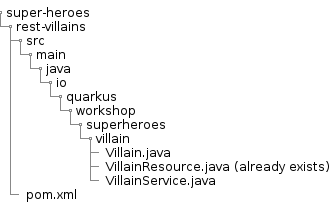
Installing the PostgreSQL Dependency, Hibernate with Panache and Hibernate Validator
This microservice:
-
Interacts with a PostgreSQL database - so it needs a driver
-
Uses Hibernate with Panache - needs the extension providing it
-
Validates payloads and entities - needs a validator
-
Consumes and produces JSON - needs a JSON mapper
Hibernate ORM is the de-facto JPA implementation and offers you the full breadth of an Object Relational Mapper. It makes complex mappings possible, but it does not make simple and common mappings trivial. Hibernate ORM with Panache focuses on making your entities trivial and fun to write in Quarkus.[9]
Because JPA and Bean Validation work well together, we will use Bean Validation to constrain our business model.
To add the required dependencies, just run the following command under the super-heroes/rest-villains directory:
./mvnw quarkus:add-extension -Dextensions="jdbc-postgresql,hibernate-orm-panache,hibernate-validator"
No need to add an extension for JSON, we already included rest-jackson.
|
This will add the following dependencies in the pom.xml file:
<dependencies>
<!-- ... -->
<dependency>
<groupId>io.quarkus</groupId>
<artifactId>quarkus-hibernate-orm-panache</artifactId>
</dependency>
<dependency>
<groupId>io.quarkus</groupId>
<artifactId>quarkus-hibernate-validator</artifactId>
</dependency>
<dependency>
<groupId>io.quarkus</groupId>
<artifactId>quarkus-jdbc-postgresql</artifactId>
</dependency>
<!-- ... -->
</dependencies>From now on, you can choose to either edit your pom directly or use the quarkus:add-extension command.
Villain Entity
To define a Panache entity, simply extend PanacheEntity, annotate it with @Entity and add your columns as public fields (no need to have getters and setters).
The Villain entity should look like this:
package io.quarkus.workshop.superheroes.villain;
import io.quarkus.hibernate.orm.panache.PanacheEntity;
import jakarta.persistence.Column;
import jakarta.persistence.Entity;
import jakarta.validation.constraints.Min;
import jakarta.validation.constraints.NotNull;
import jakarta.validation.constraints.Size;
import java.util.Random;
@Entity
public class Villain extends PanacheEntity {
@NotNull
@Size(min = 3, max = 50)
public String name;
public String otherName;
@NotNull
@Min(1)
public int level;
public String picture;
@Column(columnDefinition = "TEXT")
public String powers;
@Override
public String toString() {
return "Villain{" +
"id=" + id +
", name='" + name + '\'' +
", otherName='" + otherName + '\'' +
", level=" + level +
", picture='" + picture + '\'' +
", powers='" + powers + '\'' +
'}';
}
}Notice that you can put all your JPA column annotations and Bean Validation constraint annotations on the public fields.
Adding Operations
Thanks to Panache, once you have written the Villain entity, here are the most common operations you will be able to do:
// creating a villain
Villain villain = new Villain();
villain.name = "Lex Luthor";
villain.level = 9;
// persist it
villain.persist();
// getting a list of all Villain entities
List<Villain> villains = Villain.listAll();
// finding a specific villain by ID
villain = Villain.findById(id);
// counting all villains
long countAll = Villain.count();But we are missing a business method: we need to return a random villain.
For that it’s just a matter to add the following method to our Villain.java entity:
public static Villain findRandom() {
long countVillains = count();
Random random = new Random();
int randomVillain = random.nextInt((int) countVillains);
return findAll().page(randomVillain, 1).firstResult();
}|
You would need to add the following import statement if not done automatically by your IDE |
Picking a random villain is achieved as follows:
-
Gets the number of villains stored in the database (
count()) -
Picks a random number between 0 and
count() -
Asks Hibernate with Panache to find all villains in a paginated way and return the random page containing 1 villain.
Configuring Hibernate
Quarkus development mode is really useful for applications that mix front end or services and database access.
We use quarkus.hibernate-orm.database.generation=drop-and-create in conjunction with import.sql so every change to your app and in particular to your entities, the database schema will be properly recreated and your data (stored in import.sql) will be used to repopulate it from scratch.
This is best to perfectly control your environment and works magic with Quarkus live reload mode:
your entity changes or any change to your import.sql is immediately picked up and the schema updated without restarting the application!
For that, make sure to have the following configuration in your application.properties (located in src/main/resources):
# drop and create the database at startup (use `update` to only update the schema)
quarkus.hibernate-orm.database.generation=drop-and-createVillain Service
To manipulate the Villain entity we will develop a transactional VillainService class.
The idea is to wrap methods modifying the database (e.g. entity.persist()) within a transaction.
Marking a CDI bean method @Transactional will do that for you and make that method a transaction boundary.
@Transactional can be used to control transaction boundaries on any bean at the method level or at the class level to ensure every method is transactional.
You can control whether and how the transaction is started with parameters on @Transactional:
-
@Transactional(REQUIRED)(default): starts a transaction if none was started, stays with the existing one otherwise. -
@Transactional(REQUIRES_NEW): starts a transaction if none was started ; if an existing one was started, suspends it and starts a new one for the boundary of that method. -
@Transactional(MANDATORY): fails if no transaction was started ; works within the existing transaction otherwise. -
@Transactional(SUPPORTS): if a transaction was started, joins it ; otherwise works with no transaction. -
@Transactional(NOT_SUPPORTED): if a transaction was started, suspends it and works with no transaction for the boundary of the method ; otherwise works with no transaction. -
@Transactional(NEVER): if a transaction was started, raises an exception ; otherwise works with no transaction.
Creates a new VillainService.java file in the same package with the following content:
package io.quarkus.workshop.superheroes.villain;
import static jakarta.transaction.Transactional.TxType.REQUIRED;
import static jakarta.transaction.Transactional.TxType.SUPPORTS;
import java.util.List;
import jakarta.enterprise.context.ApplicationScoped;
import jakarta.transaction.Transactional;
import jakarta.validation.Valid;
import org.eclipse.microprofile.config.inject.ConfigProperty;
@ApplicationScoped
@Transactional(REQUIRED)
public class VillainService {
@Transactional(SUPPORTS)
public List<Villain> findAllVillains() {
return Villain.listAll();
}
@Transactional(SUPPORTS)
public Villain findVillainById(Long id) {
return Villain.findById(id);
}
@Transactional(SUPPORTS)
public Villain findRandomVillain() {
Villain randomVillain = null;
while (randomVillain == null) {
randomVillain = Villain.findRandom();
}
return randomVillain;
}
public Villain persistVillain(@Valid Villain villain) {
villain.persist();
return villain;
}
public Villain updateVillain(@Valid Villain villain) {
Villain entity = Villain.findById(villain.id);
entity.name = villain.name;
entity.otherName = villain.otherName;
entity.level = villain.level;
entity.picture = villain.picture;
entity.powers = villain.powers;
return entity;
}
public void deleteVillain(Long id) {
Villain.deleteById(id);
}
}The @ApplicationScoped annotation declares a bean.
The other component of the application can access this bean.
Arc, the dependency injection framework integrated in Quarkus, handles the creation and the access to this class.
Notice that both methods that persist and update a villain, pass a Villain object as a parameter.
Thanks to the Bean Validation’s @Valid annotation, the Villain object will be checked to see if it’s valid or not.
If it’s not, the transaction will be rolled back.
Accessing a database in dev mode
Our project now requires a connection to a PostgreSQL database. In dev mode, no need to start a database or configure anything. Quarkus does that for us (just make sure you have Docker up and running).
Start the application in dev mode with ./mvnw quarkus:dev.
In the log, you will see the following:
2021-09-21 15:58:44,640 INFO [org.tes.doc.DockerClientProviderStrategy] (build-38) Loaded org.testcontainers.dockerclient.UnixSocketClientProviderStrategy from ~/.testcontainers.properties, will try it first
2021-09-21 15:58:45,068 INFO [org.tes.doc.DockerClientProviderStrategy] (build-38) Found Docker environment with local Unix socket (unix:///var/run/docker.sock)
2021-09-21 15:58:45,070 INFO [org.tes.DockerClientFactory] (build-38) Docker host IP address is localhost
2021-09-21 15:58:45,116 INFO [org.tes.DockerClientFactory] (build-38) Connected to docker:
Server Version: 20.10.8
API Version: 1.41
Operating System: Docker Desktop
Total Memory: 5943 MB
2021-09-21 15:58:45,118 INFO [org.tes.uti.ImageNameSubstitutor] (build-38) Image name substitution will be performed by: DefaultImageNameSubstitutor (composite of 'ConfigurationFileImageNameSubstitutor' and 'PrefixingImageNameSubstitutor')
2021-09-21 15:58:45,453 INFO [org.tes.uti.RegistryAuthLocator] (build-38) Credential helper/store (docker-credential-desktop) does not have credentials for index.docker.io
2021-09-21 15:58:45,957 INFO [org.tes.DockerClientFactory] (build-38) Ryuk started - will monitor and terminate Testcontainers containers on JVM exit
2021-09-21 15:58:45,958 INFO [org.tes.DockerClientFactory] (build-38) Checking the system...
2021-09-21 15:58:45,958 INFO [org.tes.DockerClientFactory] (build-38) ✔︎ Docker server version should be at least 1.6.0
2021-09-21 15:58:46,083 INFO [org.tes.DockerClientFactory] (build-38) ✔︎ Docker environment should have more than 2GB free disk space
2021-09-21 15:58:46,143 INFO [🐳 .2]] (build-38) Creating container for image: postgres:13.2
2021-09-21 15:58:46,217 INFO [🐳 .2]] (build-38) Starting container with ID: a7fd54795185ab17baf487388c1e3280fdfea3f6ef8670c0336d367dba3e1d9e
2021-09-21 15:58:46,545 INFO [🐳 .2]] (build-38) Container postgres:13.2 is starting: a7fd54795185ab17baf487388c1e3280fdfea3f6ef8670c0336d367dba3e1d9e
2021-09-21 15:58:48,043 INFO [🐳 .2]] (build-38) Container postgres:13.2 started in PT1.959377S
2021-09-21 15:58:48,044 INFO [io.qua.dev.pos.dep.PostgresqlDevServicesProcessor] (build-38) Dev Services for the default datasource (postgresql) startedQuarkus detects the need for a database and starts one using a Docker container. It automatically configures the application, which means we are good to go and implement our REST API.
|
If the application fails to start properly and the logs contain something like try launching the application again
after having the |
VillainResource Endpoint
The VillainResource was bootstrapped with only one method hello().
We need to add extra methods that will allow CRUD operations on villains.
Here are the new methods to add to the VillainResource class:
package io.quarkus.workshop.superheroes.villain;
import org.jboss.logging.Logger;
import org.jboss.resteasy.reactive.RestPath;
import org.jboss.resteasy.reactive.RestResponse;
import jakarta.validation.Valid;
import jakarta.ws.rs.DELETE;
import jakarta.ws.rs.GET;
import jakarta.ws.rs.POST;
import jakarta.ws.rs.PUT;
import jakarta.ws.rs.Path;
import jakarta.ws.rs.Produces;
import jakarta.ws.rs.core.Context;
import jakarta.ws.rs.core.UriBuilder;
import jakarta.ws.rs.core.UriInfo;
import java.util.List;
import static jakarta.ws.rs.core.MediaType.TEXT_PLAIN;
@Path("/api/villains")
public class VillainResource {
Logger logger;
VillainService service;
public VillainResource(Logger logger, VillainService service) {
this.service = service;
this.logger = logger;
}
@GET
@Path("/random")
public RestResponse<Villain> getRandomVillain() {
Villain villain = service.findRandomVillain();
logger.debug("Found random villain " + villain);
return RestResponse.ok(villain);
}
@GET
public RestResponse<List<Villain>> getAllVillains() {
List<Villain> villains = service.findAllVillains();
logger.debug("Total number of villains " + villains.size());
return RestResponse.ok(villains);
}
@GET
@Path("/{id}")
public RestResponse<Villain> getVillain(@RestPath Long id) {
Villain villain = service.findVillainById(id);
if (villain != null) {
logger.debug("Found villain " + villain);
return RestResponse.ok(villain);
} else {
logger.debug("No villain found with id " + id);
return RestResponse.noContent();
}
}
@POST
public RestResponse<Void> createVillain(@Valid Villain villain, @Context UriInfo uriInfo) {
villain = service.persistVillain(villain);
UriBuilder builder = uriInfo.getAbsolutePathBuilder().path(Long.toString(villain.id));
logger.debug("New villain created with URI " + builder.build().toString());
return RestResponse.created(builder.build());
}
@PUT
public RestResponse<Villain> updateVillain(@Valid Villain villain) {
villain = service.updateVillain(villain);
logger.debug("Villain updated with new valued " + villain);
return RestResponse.ok(villain);
}
@DELETE
@Path("/{id}")
public RestResponse<Void> deleteVillain(@RestPath Long id) {
service.deleteVillain(id);
logger.debug("Villain deleted with " + id);
return RestResponse.noContent();
}
@GET
@Path("/hello")
@Produces(TEXT_PLAIN)
public String hello() {
return "Hello Villain Resource";
}
}Note that we added @Path("/hello") to the hello method to not conflict with the getAllVillains() method.
Dependency Injection
Dependency injection in Quarkus is based on ArC which is a CDI-based dependency injection solution tailored for Quarkus' architecture.[10] You can learn more about it in the Contexts and Dependency Injection guide.[11]
ArC handles injection at build time.
You can use field injection and inject the VillainService and the logger using:
@Inject Logger logger;
@Inject VillainService service;But in your previous class, we used constructor injection.
Both the VillainService and the Logger are injected as constructor parameter:
public VillainResource(Logger logger, VillainService service) {
this.service = service;
this.logger = logger;
}Adding Data
To load some SQL statements when Hibernate ORM starts, add the following import.sql in the root of the resources directory.
It contains SQL statements terminated by a semicolon.
This is useful to have a data set ready for the tests or demos.
ALTER SEQUENCE villain_seq RESTART WITH 50;
INSERT INTO villain(id, name, otherName, picture, powers, level)
VALUES (nextval('villain_seq'), 'Buuccolo', 'Majin Buu',
'https://www.superherodb.com/pictures2/portraits/10/050/15355.jpg',
'Accelerated Healing, Adaptation, Agility, Flight, Immortality, Intelligence, Invulnerability, Reflexes, Self-Sustenance, Size Changing, Spatial Awareness, Stamina, Stealth, Super Breath, Super Speed, Super Strength, Teleportation',
22);
INSERT INTO villain(id, name, otherName, picture, powers, level)
VALUES (nextval('villain_seq'), 'Darth Vader', 'Anakin Skywalker',
'https://www.superherodb.com/pictures2/portraits/10/050/10444.jpg',
'Accelerated Healing, Agility, Astral Projection, Cloaking, Danger Sense, Durability, Electrokinesis, Energy Blasts, Enhanced Hearing, Enhanced Senses, Force Fields, Hypnokinesis, Illusions, Intelligence, Jump, Light Control, Marksmanship, Precognition, Psionic Powers, Reflexes, Stealth, Super Speed, Telekinesis, Telepathy, The Force, Weapons Master',
13);
INSERT INTO villain(id, name, otherName, picture, powers, level)
VALUES (nextval('villain_seq'), 'The Rival (CW)', 'Edward Clariss',
'https://www.superherodb.com/pictures2/portraits/10/050/13846.jpg',
'Accelerated Healing, Agility, Bullet Time, Durability, Electrokinesis, Endurance, Enhanced Senses, Intangibility, Marksmanship, Phasing, Reflexes, Speed Force, Stamina, Super Speed, Super Strength',
10);Ok, but that’s just a few entries.
Download the SQL file import.sql and copy it under src/main/resources.
Now, you have more than 500 villains that will be loaded in the database.
If you didn’t yet, start the application in dev mode by executing the following command under the rest-villains directory:
./mvnw quarkus:devThen, open your browser to http://localhost:8080/api/villains. You should see lots of heroes…
CRUD Tests in VillainResourceTest
To test the VillainResource endpoint, we just need to extend the VillainResourceTest we already have.
No need to configure anything, Quarkus will start a test database for you.
In io.quarkus.workshop.superheroes.villain.VillainResourceTest, you will add the following test methods to the VillainResourceTest class:
-
shouldNotGetUnknownVillain: giving a random Villain identifier, theVillainResourceendpoint should return a 204 (No content) -
shouldGetRandomVillain: checks that theVillainResourceendpoint returns a random villain -
shouldNotAddInvalidItem: passing an invalidVillainshould fail when creating it (thanks to the@Validannotation) -
shouldGetInitialItems: checks that theVillainResourceendpoint returns the list of heroes -
shouldAddAnItem: checks that theVillainResourceendpoint creates a validVillain -
shouldUpdateAnItem: checks that theVillainResourceendpoint updates a newly createdVillain -
shouldRemoveAnItem: checks that theVillainResourceendpoint deletes a villain from the database
The code is as follows:
package io.quarkus.workshop.superheroes.villain;
import io.quarkus.test.junit.QuarkusTest;
import io.restassured.common.mapper.TypeRef;
import org.hamcrest.core.Is;
import org.junit.jupiter.api.MethodOrderer;
import org.junit.jupiter.api.Order;
import org.junit.jupiter.api.Test;
import org.junit.jupiter.api.TestMethodOrder;
import java.util.List;
import java.util.Random;
import static io.restassured.RestAssured.get;
import static io.restassured.RestAssured.given;
import static jakarta.ws.rs.core.HttpHeaders.ACCEPT;
import static jakarta.ws.rs.core.HttpHeaders.CONTENT_TYPE;
import static jakarta.ws.rs.core.MediaType.APPLICATION_JSON;
import static jakarta.ws.rs.core.MediaType.TEXT_PLAIN;
import static jakarta.ws.rs.core.Response.Status.BAD_REQUEST;
import static jakarta.ws.rs.core.Response.Status.CREATED;
import static jakarta.ws.rs.core.Response.Status.NO_CONTENT;
import static jakarta.ws.rs.core.Response.Status.OK;
import static org.hamcrest.CoreMatchers.is;
import static org.junit.jupiter.api.Assertions.assertEquals;
import static org.junit.jupiter.api.Assertions.assertNotNull;
import static org.junit.jupiter.api.Assertions.assertTrue;
@QuarkusTest
@TestMethodOrder(MethodOrderer.OrderAnnotation.class)
public class VillainResourceTest {
private static final String JSON = "application/json;charset=UTF-8";
private static final String DEFAULT_NAME = "Super Chocolatine";
private static final String UPDATED_NAME = "Super Chocolatine (updated)";
private static final String DEFAULT_OTHER_NAME = "Super Chocolatine chocolate in";
private static final String UPDATED_OTHER_NAME = "Super Chocolatine chocolate in (updated)";
private static final String DEFAULT_PICTURE = "super_chocolatine.png";
private static final String UPDATED_PICTURE = "super_chocolatine_updated.png";
private static final String DEFAULT_POWERS = "does not eat pain au chocolat";
private static final String UPDATED_POWERS = "does not eat pain au chocolat (updated)";
private static final int DEFAULT_LEVEL = 42;
private static final int UPDATED_LEVEL = 43;
private static final int NB_VILLAINS = 570;
private static String villainId;
@Test
public void testHelloEndpoint() {
given().header(ACCEPT, TEXT_PLAIN).when().get("/api/villains/hello").then().statusCode(200).body(is("Hello Villain Resource"));
}
@Test
void shouldNotGetUnknownVillain() {
Long randomId = new Random().nextLong();
given().pathParam("id", randomId).when().get("/api/villains/{id}").then().statusCode(NO_CONTENT.getStatusCode());
}
@Test
void shouldGetRandomVillain() {
given().when().get("/api/villains/random").then().statusCode(OK.getStatusCode()).contentType(APPLICATION_JSON);
}
@Test
void shouldNotAddInvalidItem() {
Villain villain = new Villain();
villain.name = null;
villain.otherName = DEFAULT_OTHER_NAME;
villain.picture = DEFAULT_PICTURE;
villain.powers = DEFAULT_POWERS;
villain.level = 0;
given()
.body(villain)
.header(CONTENT_TYPE, JSON)
.header(ACCEPT, JSON)
.when()
.post("/api/villains")
.then()
.statusCode(BAD_REQUEST.getStatusCode());
}
@Test
@Order(1)
void shouldGetInitialItems() {
List<Villain> villains = get("/api/villains")
.then()
.statusCode(OK.getStatusCode())
.contentType(APPLICATION_JSON)
.extract()
.body()
.as(getVillainTypeRef());
assertEquals(NB_VILLAINS, villains.size());
}
@Test
@Order(2)
void shouldAddAnItem() {
Villain villain = new Villain();
villain.name = DEFAULT_NAME;
villain.otherName = DEFAULT_OTHER_NAME;
villain.picture = DEFAULT_PICTURE;
villain.powers = DEFAULT_POWERS;
villain.level = DEFAULT_LEVEL;
String location = given()
.body(villain)
.header(CONTENT_TYPE, JSON)
.header(ACCEPT, JSON)
.when()
.post("/api/villains")
.then()
.statusCode(CREATED.getStatusCode())
.extract()
.header("Location");
assertTrue(location.contains("/api/villains"));
// Stores the id
String[] segments = location.split("/");
villainId = segments[segments.length - 1];
assertNotNull(villainId);
given()
.pathParam("id", villainId)
.when()
.get("/api/villains/{id}")
.then()
.statusCode(OK.getStatusCode())
.contentType(APPLICATION_JSON)
.body("name", Is.is(DEFAULT_NAME))
.body("otherName", Is.is(DEFAULT_OTHER_NAME))
.body("level", Is.is(DEFAULT_LEVEL))
.body("picture", Is.is(DEFAULT_PICTURE))
.body("powers", Is.is(DEFAULT_POWERS));
List<Villain> villains = get("/api/villains")
.then()
.statusCode(OK.getStatusCode())
.contentType(APPLICATION_JSON)
.extract()
.body()
.as(getVillainTypeRef());
assertEquals(NB_VILLAINS + 1, villains.size());
}
@Test
@Order(3)
void testUpdatingAnItem() {
Villain villain = new Villain();
villain.id = Long.valueOf(villainId);
villain.name = UPDATED_NAME;
villain.otherName = UPDATED_OTHER_NAME;
villain.picture = UPDATED_PICTURE;
villain.powers = UPDATED_POWERS;
villain.level = UPDATED_LEVEL;
given()
.body(villain)
.header(CONTENT_TYPE, JSON)
.header(ACCEPT, JSON)
.when()
.put("/api/villains")
.then()
.statusCode(OK.getStatusCode())
.contentType(APPLICATION_JSON)
.body("name", Is.is(UPDATED_NAME))
.body("otherName", Is.is(UPDATED_OTHER_NAME))
.body("level", Is.is(UPDATED_LEVEL))
.body("picture", Is.is(UPDATED_PICTURE))
.body("powers", Is.is(UPDATED_POWERS));
List<Villain> villains = get("/api/villains")
.then()
.statusCode(OK.getStatusCode())
.contentType(APPLICATION_JSON)
.extract()
.body()
.as(getVillainTypeRef());
assertEquals(NB_VILLAINS + 1, villains.size());
}
@Test
@Order(4)
void shouldRemoveAnItem() {
given().pathParam("id", villainId).when().delete("/api/villains/{id}").then().statusCode(NO_CONTENT.getStatusCode());
List<Villain> villains = get("/api/villains")
.then()
.statusCode(OK.getStatusCode())
.contentType(APPLICATION_JSON)
.extract()
.body()
.as(getVillainTypeRef());
assertEquals(NB_VILLAINS, villains.size());
}
private TypeRef<List<Villain>> getVillainTypeRef() {
return new TypeRef<List<Villain>>() {
// Kept empty on purpose
};
}
}The tests and the application runs in the same JVM, meaning that the test can be injected with application beans. This feature is very useful to test specific parts of the application. However, in our case, we just execute HTTP requests to check the result.
Run the test either in the dev mode or using ./mvnw test.
They should pass.
Building production package
Our service is not completely done yet, but let’s run it in prod mode.
Configuring the application
In prod mode, the dev services won’t be used. We need to configure the application to connect to a real database.
The main way of obtaining connections to a database is to use a datasource. In Quarkus, the out of the box datasource and connection pooling implementation is Agroal.[12]
So, we need to configure the database access in the src/main/resources/application.properties file,
but only when the application runs in prod mode.
Add the following datasource configuration:
%prod.quarkus.datasource.username=superbad
%prod.quarkus.datasource.password=superbad
%prod.quarkus.datasource.jdbc.url=jdbc:postgresql://localhost:5432/villains_database
%prod.quarkus.hibernate-orm.sql-load-script=import.sql%prod indicates that the property is only used when the application runs with the given profile.
We configure the access to the database, and force the data initialization (which would have been disabled by default in prod mode).
Running the Infrastructure
Before going further, be sure to run the infrastructure. To execute this service, you need a database. Let’s use Docker and docker compose to ease the installation of such infrastructure.
You should already have installed the infrastructure into the infrastructure directory.
Now, just execute docker compose -f docker-compose.yaml up -d under the infrastructure directory.
You should see a few logs going on and then all the containers get started.
On Linux, use the docker-compose-linux.yaml:
docker compose -f docker-compose-linux.yaml up -d|
During the workshop, just leave all the containers up and running.
Then, after the workshop, remember to shut them down using: |
Packaging and running the application
Stop the dev mode, and run:
./mvnw packageAs previously, you will get your application in target/quarkus-app, run it using:
java -jar target/quarkus-app/quarkus-run.jarOpen your browser to http://localhost:8080/api/villains, and verify it displays the expected content.
Once done, stop the application using CTRL+C.
Configuring the Villain Microservice
Hardcoded values in our code are a no go (even if we all did it at some point). In this guide, we learn how to configure our Villain API as well as some parts of Quarkus.
Configuring Logging
In the VillainResource, we injected a logger.
That’s very useful to provide meaningful information about the execution.
But you often need to adjust the configuration, such as the log level.
Runtime configuration of logging is done through the normal application.properties file:
quarkus.log.console.enable=true
quarkus.log.console.format=%d{HH:mm:ss} %-5p [%c{2.}] (%t) %s%e%n
quarkus.log.console.level=INFO
quarkus.log.console.darken=1Configuring Quarkus Listening Port
Because we will end-up running several microservices, let’s configure Quarkus so it listens to a different port than 8080:
This is quite easy as we just need to add one property in the application.properties file:
## HTTP configuration
quarkus.http.port=8084Changing the port is one of the rare configuration that cannot be done while the application is running.
You would need to restart the application to change the port.
Hit CTRL+C to stop the application if it still running and restart it with: ./mvnw quarkus:dev.
Then run:
curl http://localhost:8084/api/villains | jqInjecting Configuration Value
When we persist a new villain, we want to multiply the level by a value that can be configured (to reduce the level, so heroes will win the fights more easily).
For this, Quarkus uses MicroProfile Config to inject the configuration in the application.[13]
The injection uses the @ConfigProperty annotation.
|
When injecting a configured value, you can use |
Edit the VillainService, and introduce the following configuration properties:
@ConfigProperty(name = "level.multiplier", defaultValue="1.0") double levelMultiplier;|
You may need to add the following import statement if your IDE does not do it automatically: |
If you do not provide a value for this property, the application startup fails with jakarta.enterprise.inject.spi.DeploymentException: No config value of type [int] exists for: level.multiplier.
To avoid having to configure a value, we configure a default one (property defaultValue).
Now, modify the VillainService.persistVillain() method to use the injected properties:
public Villain persistVillain(@Valid Villain villain) {
villain.level = (int) Math.round(villain.level * levelMultiplier);
villain.persist();
return villain;
}Create the Configuration
By default, Quarkus reads application.properties.
Edit the src/main/resources/application.properties with the following content:
level.multiplier=0.5Running and Testing the Application
If you didn’t already, start the application with ./mvnw quarkus:dev.
Once started, create a new villain with the following cUrl command (notice the verbose option -v to see the HTTP response headers):
curl -X POST -d '{"level":5, "name":"Super Bad", "powers":"Agility, Longevity"}' -H "Content-Type: application/json" http://localhost:8084/api/villains -vYou should see something like this:
< HTTP/1.1 201 Created
< Location: http://localhost:8084/api/villains/582As you can see, we’ve passed a level of 5 to create this new villain. The cURL command returns the location of the newly created villain. Take this URL and do an HTTP GET on it. You will see that the level has been decreased.
|
The example shows a newly created Villain with id |
curl http://localhost:8084/api/villains/582 | jq
{
"id": 582,
"level": 3,
"name": "Super Bad",
"powers": "Agility, Longevity"
}|
You may not know |
Hey! Wait a minute! If you enabled continuous testing, Quarkus should have warned you:
--
Running 2/8. Running: io.quarkus.workshop.superheroes.villain.VillainResourceTest#shouldAddAnItem()
Press [o] Toggle test output, [h] for more options>WARNING: An illegal reflective access operation has occurred
2021-09-21 21:02:16,067 ERROR [io.qua.test] (Test runner thread) ==================== TEST REPORT #1 ====================
2021-09-21 21:02:16,067 ERROR [io.qua.test] (Test runner thread) Test VillainResourceTest#shouldAddAnItem() failed
: java.lang.AssertionError: 1 expectation failed.
JSON path level doesn't match.
Expected: is <42>
Actual: <21>
at io.restassured.internal.ValidatableResponseImpl.body(ValidatableResponseImpl.groovy)
at io.quarkus.workshop.superheroes.villain.VillainResourceTest.shouldAddAnItem(VillainResourceTest.java:133)
2021-09-21 21:02:16,070 ERROR [io.qua.test] (Test runner thread) >>>>>>>>>>>>>>>>>>>> 1 TEST FAILED <<<<<<<<<<<<<<<<<<<<Tests are failing now! Indeed, they don’t know the multiplier.
Press r in the dev mode to run the tests.
|
In the application.properties file, add: %test.level.multiplier=1 which set the multiplier to 1 when running the tests:
All 8 tests are passing (0 skipped), 8 tests were run in 1722ms. Tests completed at 21:03:25.Open API
A Quarkus application can expose its API description through an OpenAPI specification. Quarkus also lets you test it via a user-friendly UI named Swagger UI.
In this section, we will see how to use OpenAPI with Quarkus and introduce the dev console.
Directory Structure
In this module we will add extra class (VillainApplication) to the Villain API project.
You will end-up with the following directory structure:
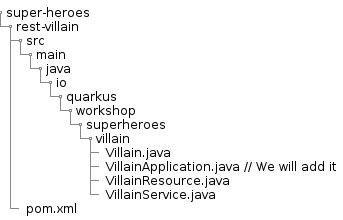
Installing the OpenAPI extension
Quarkus proposes a smallrye-openapi extension compliant with the MicroProfile OpenAPI specification in order to generate your API OpenAPI v3 specification.[14]
To install the OpenAPI dependency, just run the following command:
./mvnw quarkus:add-extension -Dextensions="smallrye-openapi"This will add the following dependency in the pom.xml file:
<dependency>
<groupId>io.quarkus</groupId>
<artifactId>quarkus-smallrye-openapi</artifactId>
</dependency>Open API
Now, curl http://localhost:8084/q/openapi endpoint with the command curl http://localhost:8084/q/openapi and you will see the following OpenAPI contract:
openapi: 3.0.3
info:
title: rest-villains API
version: 1.0.0-SNAPSHOT
paths:
/api/villains:
get:
tags:
- Villain Resource
responses:
"200":
description: OK
content:
application/json:
schema:
type: array
items:
$ref: '#/components/schemas/Villain'
put:
tags:
- Villain Resource
requestBody:
content:
application/json:
schema:
$ref: '#/components/schemas/Villain'
responses:
"200":
description: OK
content:
application/json:
schema:
$ref: '#/components/schemas/Villain'
post:
tags:
- Villain Resource
requestBody:
content:
application/json:
schema:
$ref: '#/components/schemas/Villain'
responses:
"201":
description: Created
/api/villains/hello:
get:
tags:
- Villain Resource
responses:
"200":
description: OK
content:
text/plain:
schema:
type: string
/api/villains/random:
get:
tags:
- Villain Resource
responses:
"200":
description: OK
content:
application/json:
schema:
$ref: '#/components/schemas/Villain'
/api/villains/{id}:
get:
tags:
- Villain Resource
parameters:
- name: id
in: path
required: true
schema:
format: int64
type: integer
responses:
"200":
description: OK
content:
application/json:
schema:
$ref: '#/components/schemas/Villain'
delete:
tags:
- Villain Resource
parameters:
- name: id
in: path
required: true
schema:
format: int64
type: integer
responses:
"204":
description: No Content
components:
schemas:
Villain:
required:
- name
- level
type: object
properties:
id:
format: int64
type: integer
name:
maxLength: 50
minLength: 3
type: string
otherName:
type: string
level:
format: int32
minimum: 1
type: integer
picture:
type: string
powers:
type: string
securitySchemes:
SecurityScheme:
type: http
description: Authentication
scheme: basicThis contract lacks documentation. The Eclipse MicroProfile OpenAPI allows you to customize the methods of your REST endpoint as well as the application.
While having the OpenAPI specification is great, it can’t be consumed easily by humans. In your browser, go to http://localhost:8084/q/dev. This is the dev console. It provides all the tools you need to develop your Quarkus application. We will use it several times in this workshop. Note that the dev console is only available in dev mode.
The Dev Console integrates Swagger, a UI to invoke your endpoints from the comfort of your browser. Click on the "Swagger UI" button located in the "SmallRye OpenAPI" widget (http://localhost:8084/q/swagger-ui).
You will see all your endpoints listed. Click on the "GET" button for the "/api/villains" path, then click on "Try it out" and finally on "Execute". You can see the result immediately.
When developing REST APIs, this UI is very convenient. You can test your endpoint and immediately see the outcome. If something does not please you, edit the code, go back to the browser, re-execute, and voilà!
Customizing Methods
The MicroProfile OpenAPI has a set of annotations to customize each REST endpoint method so the OpenAPI contract is richer and clearer for consumers:
-
@Operation: Describes a single API operation on a path. -
@APIResponse: Corresponds to the OpenAPI Response model object which describes a single response from an API Operation -
@Parameter: The name of the parameter. -
@RequestBody: A brief description of the request body.
This is what the VillainResource endpoint should look like once you have annotated it:
package io.quarkus.workshop.superheroes.villain;
import static jakarta.ws.rs.core.MediaType.APPLICATION_JSON;
import java.net.URI;
import java.util.List;
import jakarta.validation.Valid;
import jakarta.ws.rs.DELETE;
import jakarta.ws.rs.GET;
import jakarta.ws.rs.POST;
import jakarta.ws.rs.PUT;
import jakarta.ws.rs.Path;
import jakarta.ws.rs.Produces;
import jakarta.ws.rs.core.Context;
import jakarta.ws.rs.core.MediaType;
import jakarta.ws.rs.core.Response;
import jakarta.ws.rs.core.UriBuilder;
import jakarta.ws.rs.core.UriInfo;
import org.eclipse.microprofile.openapi.annotations.Operation;
import org.eclipse.microprofile.openapi.annotations.enums.SchemaType;
import org.eclipse.microprofile.openapi.annotations.media.Content;
import org.eclipse.microprofile.openapi.annotations.media.Schema;
import org.eclipse.microprofile.openapi.annotations.responses.APIResponse;
import org.eclipse.microprofile.openapi.annotations.tags.Tag;
import org.jboss.logging.Logger;
import org.jboss.resteasy.reactive.RestPath;
import org.jboss.resteasy.reactive.RestResponse;
@Path("/api/villains")
@Tag(name = "villains")
public class VillainResource {
Logger logger;
VillainService service;
public VillainResource(Logger logger, VillainService service) {
this.service = service;
this.logger = logger;
}
@Operation(summary = "Returns a random villain")
@GET
@Path("/random")
@APIResponse(
responseCode = "200",
content = @Content(mediaType = APPLICATION_JSON, schema = @Schema(implementation = Villain.class, required = true))
)
public RestResponse<Villain> getRandomVillain() {
Villain villain = service.findRandomVillain();
logger.debug("Found random villain " + villain);
return RestResponse.ok(villain);
}
@Operation(summary = "Returns all the villains from the database")
@GET
@APIResponse(
responseCode = "200",
content = @Content(mediaType = APPLICATION_JSON, schema = @Schema(implementation = Villain.class, type = SchemaType.ARRAY))
)
public RestResponse<List<Villain>> getAllVillains() {
List<Villain> villains = service.findAllVillains();
logger.debug("Total number of villains " + villains.size());
return RestResponse.ok(villains);
}
@Operation(summary = "Returns a villain for a given identifier")
@GET
@Path("/{id}")
@APIResponse(responseCode = "200", content = @Content(mediaType = APPLICATION_JSON, schema = @Schema(implementation = Villain.class)))
@APIResponse(responseCode = "204", description = "The villain is not found for a given identifier")
public RestResponse<Villain> getVillain(@RestPath Long id) {
Villain villain = service.findVillainById(id);
if (villain != null) {
logger.debug("Found villain " + villain);
return RestResponse.ok(villain);
} else {
logger.debug("No villain found with id " + id);
return RestResponse.noContent();
}
}
@Operation(summary = "Creates a valid villain")
@POST
@APIResponse(
responseCode = "201",
description = "The URI of the created villain",
content = @Content(mediaType = APPLICATION_JSON, schema = @Schema(implementation = URI.class))
)
public RestResponse<Void> createVillain(@Valid Villain villain, @Context UriInfo uriInfo) {
villain = service.persistVillain(villain);
UriBuilder builder = uriInfo.getAbsolutePathBuilder().path(Long.toString(villain.id));
logger.debug("New villain created with URI " + builder.build().toString());
return RestResponse.created(builder.build());
}
@Operation(summary = "Updates an exiting villain")
@PUT
@APIResponse(
responseCode = "200",
description = "The updated villain",
content = @Content(mediaType = APPLICATION_JSON, schema = @Schema(implementation = Villain.class))
)
public RestResponse<Villain> updateVillain(@Valid Villain villain) {
villain = service.updateVillain(villain);
logger.debug("Villain updated with new valued " + villain);
return RestResponse.ok(villain);
}
@Operation(summary = "Deletes an exiting villain")
@DELETE
@Path("/{id}")
@APIResponse(responseCode = "204")
public RestResponse<Void> deleteVillain(@RestPath Long id) {
service.deleteVillain(id);
logger.debug("Villain deleted with " + id);
return RestResponse.noContent();
}
@GET
@Produces(MediaType.TEXT_PLAIN)
@Path("/hello")
public String hello() {
return "Hello Villain Resource";
}
}With this new code, go back to the Swagger UI at http://localhost:8084/q/swagger-ui and refresh. Your endpoints are organized by tags, and each annotated endpoint is documented.
Documenting REST API is essential when working with different teams. You can see OpenAPI as the JavaDoc for REST.
Customizing the Application
The previous annotations allow you to customize the contract for a given REST Endpoint. But it’s also important to document the entire application.
The Microprofile OpenAPI also has a set of annotation to do so. The difference is that these annotations cannot be used on the endpoint methods, but instead on another Java class configuring the entire application.
For this, you need to create the src/main/java/io/quarkus/workshop/superheroes/villain/VillainApplication class with the following content:
package io.quarkus.workshop.superheroes.villain;
import jakarta.ws.rs.ApplicationPath;
import jakarta.ws.rs.core.Application;
import org.eclipse.microprofile.openapi.annotations.ExternalDocumentation;
import org.eclipse.microprofile.openapi.annotations.OpenAPIDefinition;
import org.eclipse.microprofile.openapi.annotations.info.Contact;
import org.eclipse.microprofile.openapi.annotations.info.Info;
import org.eclipse.microprofile.openapi.annotations.servers.Server;
@ApplicationPath("/")
@OpenAPIDefinition(
info = @Info(
title = "Villain API",
description = "This API allows CRUD operations on a villain",
version = "1.0",
contact = @Contact(name = "Quarkus", url = "https://github.com/quarkusio")
),
servers = { @Server(url = "http://localhost:8084") },
externalDocs = @ExternalDocumentation(url = "https://github.com/quarkusio/quarkus-workshops", description = "All the Quarkus workshops")
)
public class VillainApplication extends Application {
// Empty body
}Go back to the Swagger UI and refresh again. At the top of the document, you can see the version and the global API documentation.
Customized Contract
If you go back to the http://localhost:8084/q/openapi endpoint you will see the following OpenAPI contract:
openapi: 3.0.3
info:
title: Villain API
description: This API allows CRUD operations on a villain
contact:
name: Quarkus
url: https://github.com/quarkusio
version: "1.0"
externalDocs:
description: All the Quarkus workshops
url: https://github.com/quarkusio/quarkus-workshops
servers:
- url: http://localhost:8084
tags:
- name: villains
paths:
/api/villains:
get:
tags:
- villains
summary: Returns all the villains from the database
responses:
"200":
description: OK
content:
application/json:
schema:
type: array
items:
$ref: '#/components/schemas/Villain'
put:
tags:
- villains
summary: Updates an exiting villain
requestBody:
content:
application/json:
schema:
$ref: '#/components/schemas/Villain'
responses:
"200":
description: The updated villain
content:
application/json:
schema:
$ref: '#/components/schemas/Villain'
post:
tags:
- villains
summary: Creates a valid villain
requestBody:
content:
application/json:
schema:
$ref: '#/components/schemas/Villain'
responses:
"201":
description: The URI of the created villain
content:
application/json:
schema:
format: uri
type: string
/api/villains/hello:
get:
tags:
- villains
responses:
"200":
description: OK
content:
text/plain:
schema:
type: string
/api/villains/random:
get:
tags:
- villains
summary: Returns a random villain
responses:
"200":
description: OK
content:
application/json:
schema:
$ref: '#/components/schemas/Villain'
/api/villains/{id}:
get:
tags:
- villains
summary: Returns a villain for a given identifier
parameters:
- name: id
in: path
required: true
schema:
format: int64
type: integer
responses:
"200":
description: OK
content:
application/json:
schema:
$ref: '#/components/schemas/Villain'
"204":
description: The villain is not found for a given identifier
delete:
tags:
- villains
summary: Deletes an exiting villain
parameters:
- name: id
in: path
required: true
schema:
format: int64
type: integer
responses:
"204":
description: No Content
components:
schemas:
Villain:
required:
- name
- level
type: object
properties:
id:
format: int64
type: integer
name:
maxLength: 50
minLength: 3
type: string
otherName:
type: string
level:
format: int32
minimum: 1
type: integer
picture:
type: string
powers:
type: string
securitySchemes:
SecurityScheme:
type: http
description: Authentication
scheme: basicYou can expose or exchange this contract to the API consumers, so they now what to expect when using your API.
OpenAPI Tests in VillainResourceTest
Let’s add an extra test method in VillainResourceTest ensuring that the OpenAPI specification is packaged with the application:
@Test
void shouldPingOpenAPI() {
given().header(ACCEPT, JSON).when().get("/q/openapi").then().statusCode(OK.getStatusCode());
}Run the test:
-
From the dev mode, or
-
By executing the test using
./mvnw test.
|
If you have any problem with the code, don’t understand or feel you are running, remember to ask for some help. Also, you can get the code of this entire workshop from https://github.com/quarkusio/quarkus-workshops/tree/refs/heads/main/quarkus-workshop-super-heroes. You can also download the completed code from https://raw.githubusercontent.com/quarkusio/quarkus-workshops/refs/heads/main/quarkus-workshop-super-heroes/dist/quarkus-super-heroes-workshop-complete.zip. |
Quarkus
In the previous chapter, you had a quick peek at Quarkus and how you can build HTTP / REST-based applications with it. But that was just the beginning; Quarkus can do a lot more, which is the purpose of this chapter. In this chapter, you are going to see:
-
What’s Quarkus? and how does it change the Java landscape
-
What are the main Quarkus idea, and how it helps in the cloud native world
-
The Quarkus build process, in other words, the secret sauce number 1
-
The Quarkus reactive nature, in other words, the secret sauce number 2
-
Some Quarkus features such as the application lifecycle support
-
How you can use Quarkus to generate native executable
What’s Quarkus?
Java was born more than 25 years ago. The world 25 years ago was quite different. The software industry has gone through several revolutions over these two decades. Java has always been able to reinvent itself to stay relevant.
But a new revolution is happening. While for years, most applications were running on huge machines, with lots of CPU and memory, they are now running on the Cloud, in constrained environments, in containers, where the resources are shared. Density is the new optimization: crank as many mini-apps (or microservices) as possible per node. And scale by adding more instances of an app instead of a more powerful single instance.
The Java ergonomics, designed 20 years ago, do not fit well in this new environment. Java applications were designed to run 24/7 for months, even years. The JIT is optimizing the execution over time; the GC manages the memory efficiently… But all these features have a cost, and the memory required to run Java applications and startup times are showstoppers when you deploy 20 or 50 microservices instead of one application. The issue is not the JVM itself; it’s also the Java ecosystem that needs to be reinvented.
That’s where Quarkus, and other projects, enter the game. Quarkus uses a build time principle.[15] During the build of the application, tasks that usually happen at runtime are executed at build time.
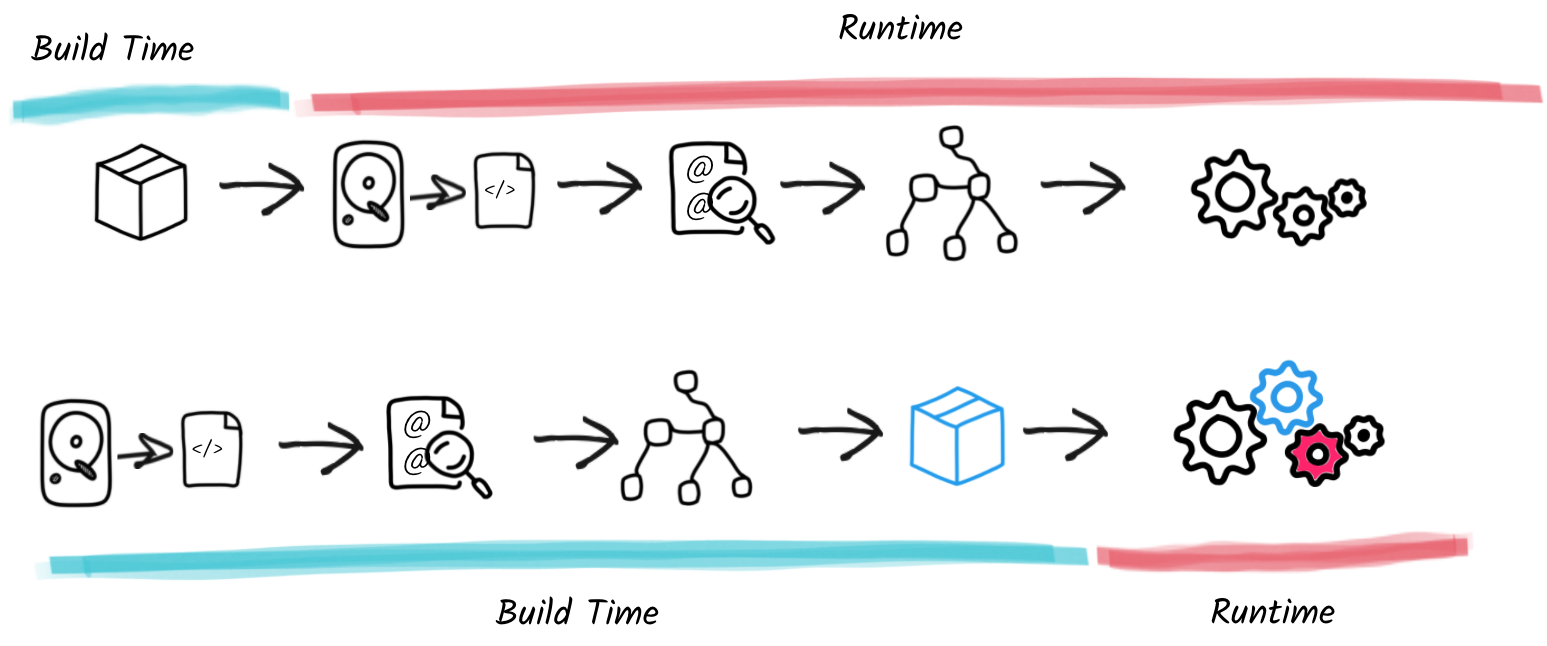
Thus, when the application runs, everything has been pre-computed, and all the annotation scanning, XML parsing, and so on won’t be executed anymore. It has two direct benefits: startup time (a lot faster) and memory consumption (a lot lower).

So, as depicted in the figure above, Quarkus does bring an infrastructure for frameworks to embrace build time metadata discovery (like annotations), replace proxies with generated classes, pre-configure most frameworks, and handle dependency injection at build time.
Also, during the build, Quarkus detects which class needs to be accessed by reflection at runtime, boots framework at build time to record the result, and generally offers a lot of GraalVM optimization for free (or cheap at least). Indeed, thanks to all this metadata, Quarkus can configure native compilers such as the GraalVM compiler to generate a native executable for your Java application. Thanks to an aggressive dead-code elimination, the final executable is smaller, faster to start, and uses a ridiculously small amount of memory.
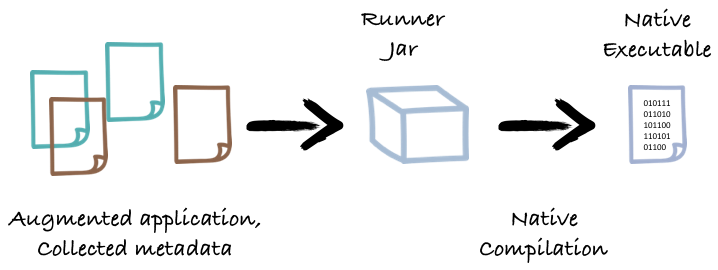
Quarkus does not stop there. As you have seen in the previous chapter, it proposes a stellar developer experience. It also unifies reactive and imperative to let you decide how you want to handle I/O. It allows implementing both REST and event-driven applications using a consistent model. To do this, Quarkus is based on a reactive core allowing high concurrency and reducing memory consumption.
Quarkus detects if your method can be called on the I/O thread and follows the reactive execution model; or if your method must be called on a worker thread and follows the imperative execution model.
Ok, but enough talking, time to see this in action.
Quarkus Augmentation
Let’s demystify all this.
So far, you have developed the super-villains microservice. This microservice is relatively simple. It still has database access, ORM support, transaction, JSON serialization, and deserialization.
Let’s now package this application using:
./mvnw packageIn the log, you can see actions happening during what Quarkus calls the augmentation phase.
[INFO] --- quarkus-maven-plugin:3.27.0:build (default) @ rest-villains ---
[INFO] [org.jboss.threads] JBoss Threads version 3.4.2.Final
[INFO] [org.hibernate.Version] HHH000412: Hibernate ORM core version 5.5.7.Final
[INFO] [io.quarkus.deployment.QuarkusAugmentor] Quarkus augmentation completed in 1932msIn this log, you can observe the build principle. Typically, about Hibernate, it saves from having to:
-
embed an XML parser at runtime,
-
Do the actual parsing,
-
Configure Hibernate based on the content of the file.
With Quarkus, at runtime, almost everything is already configured. Only runtime configuration properties are applied at startup (such as database URLs).
Also, during this augmentation, Java classes are generated or extended.
Remember the Villain Panache entity.
The class is extended during the augmentation.
If you run javap --class-path target/quarkus-app/quarkus/transformed-bytecode.jar io.quarkus.workshop.superheroes.villain.Villain, you can see methods prefixed with $$ added to the class.
Each extension can combine build time and run time.
The following figure presents some of the extensions you already used, but there are a lot more.
We are going to learn more about extensions later in this workshop and even build one.
What’s important to understand for now is that the magic is packaged into extension, and every time you add a quarkus- dependency to your pom.xml file, you enable an extension.

Application Lifecycle
Now that you know how Quarkus is structured let’s continue using various extensions. You often need to execute custom actions when the application starts and clean up everything when the application stops. In this module, we will display a banner in the logs once the Villain microservice has started.
Directory Structure
In this section, we will add an extra class (VillainApplicationLifeCycle) to handle the Villain API lifecycle.
You will end up with the following directory structure:
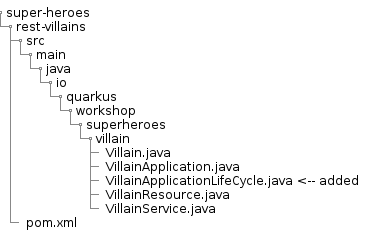
Displaying a Banner
When our application starts, the logs are dull and lack a banner (any decent application must have a banner nowadays).
So the first thing that you need to do is to go to the following website and pick up your favorite "Villain API" text banner.
Create a new class named VillainApplicationLifeCycle (or pick another name, the name does not matter) in the io.quarkus.workshop.superheroes.villain package, and copy your banner, so you end up with something like the following:
package io.quarkus.workshop.superheroes.villain;
import io.quarkus.runtime.ShutdownEvent;
import io.quarkus.runtime.StartupEvent;
import io.quarkus.runtime.configuration.ConfigUtils;
import jakarta.enterprise.context.ApplicationScoped;
import jakarta.enterprise.event.Observes;
import org.jboss.logging.Logger;
@ApplicationScoped
public class VillainApplicationLifeCycle {
private static final Logger LOGGER = Logger.getLogger(VillainApplicationLifeCycle.class);
void onStart(@Observes StartupEvent ev) {
LOGGER.info(" __ ___ _ _ _ _ ____ ___ ");
LOGGER.info(" \\ \\ / (_) | | __ _(_)_ __ / \\ | _ \\_ _|");
LOGGER.info(" \\ \\ / /| | | |/ _` | | '_ \\ / _ \\ | |_) | | ");
LOGGER.info(" \\ V / | | | | (_| | | | | | / ___ \\| __/| | ");
LOGGER.info(" \\_/ |_|_|_|\\__,_|_|_| |_| /_/ \\_\\_| |___|");
}
void onStop(@Observes ShutdownEvent ev) {
LOGGER.info("The application VILLAIN is stopping...");
}
}Thanks to the CDI @Observes, the VillainApplicationLifeCycle is invoked.
On startup with the StartupEvent so it can execute code (here, displaying the banner) when the application is starting
Run the application with: ./mvnw quarkus:dev, the banner is printed to the console.
When the application is stopped, the second log message is printed.
|
If your application is still running, just send an HTTP request, like go to http://localhost:8084. |
The method is called by ArC, the dependency injection framework used by Quarkus. Arc embraces the build-time principle, meaning that injection happens at build time. In addition, Arc can detect and remove unused beans at runtime, saving memory.
With the application running in dev mode, open your browser to http://localhost:8084/q/dev/. In the ArC widget, you can see the number of components that have been removed ("Removed components"), and if you click on the link, see the list of removed beans. If you click on the "Observers" link, you will see the two methods we added. In the "Fired Events" view, you can see which event has been fired and when.
Configuration Profiles
Quarkus supports the notion of configuration profiles. These allow you to have multiple configurations in the same file and select between them via a profile name.
Quarkus has three profiles by default, although it is possible to use as many as you like. The default profiles are:
-
dev- Activated when in development mode (i.e.quarkus:dev) -
test- Activated when running tests -
prod- The default profile when not running in development or test mode
Let’s change the VillainApplicationLifeCycle so it displays the current profile.
For that, just add a log invoking ConfigUtils.getProfiles() in the onStart() method:
LOGGER.info("The application VILLAIN is starting with profile " + ConfigUtils.getProfiles());|
If not already done, you need to add the following import statement: |
In the application.properties file, you can prefix a property with the profile.
For example, we did add the %test.level.multiplier=1 property in the previous chapter.
It indicates that the property level.multiplier is set to 1 in the test profile.
Now, you will get the dev profile enabled if you start your application in dev mode with ./mvnw compile quarkus:dev.
If you start the tests, the test profile is enabled (the multiplier is set to 1).
You can also create your own profiles, and activate them with the quarkus.profile property.
For example, to use a profile called foo, add the datasource for foo profile
%foo.quarkus.datasource.username=superbad
%foo.quarkus.datasource.password=superbad
%foo.quarkus.datasource.jdbc.url=jdbc:postgresql://localhost:5432/villains_database
%foo.quarkus.hibernate-orm.sql-load-script=import.sqlpackage your application with ./mvnw package, and start it with java -Dquarkus.profile=foo -jar target/quarkus-app/quarkus-run.jar.
You will see that the foo profile is enabled.
As not overridden, the level.multiplier property has the value 0.5.
Profiles are handy to customize the configuration per environment. We are going to see an example of such customization in the next section.
Reactive
Quarkus combines the build time principle with a reactive core. The combination of these two characteristics improves the application concurrency and makes use of resources more efficiently. In this chapter, we will see the counterpart of the Villain microservice: the Hero microservice! Instead of the imperative approach used for the villains, we will use reactive programming and Hibernate Reactive. The logic of the microservice is the same.
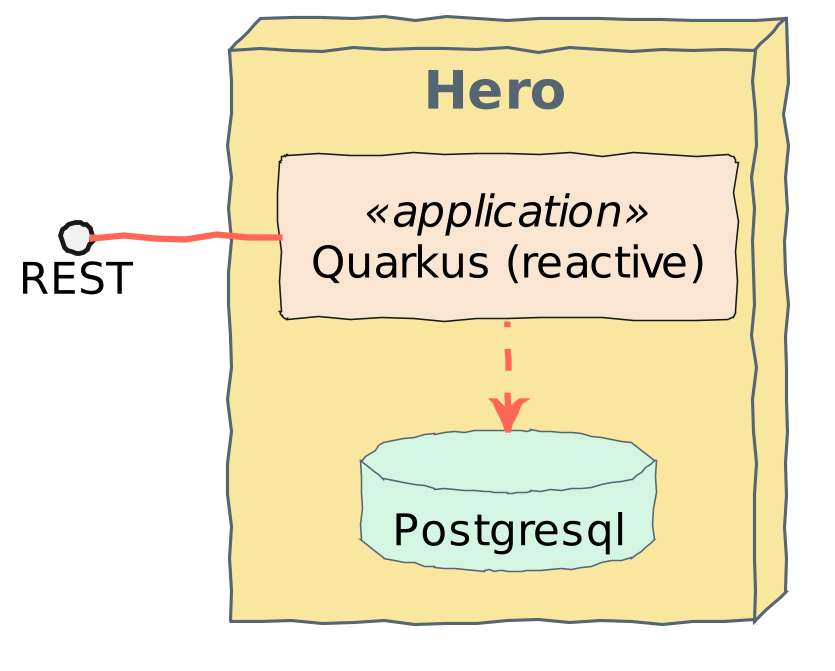
In the following sections, you will learn:
-
How to create a new reactive Quarkus application
-
How to implement REST API using JAX-RS and the Quarkus REST extension using a reactive development model
-
How to access your database using Hibernate Reactive with Panache
-
How to use transactions the reactive way
| This service is exposed on the port 8083. |
Why reactive?
"Reactive" is a set of principles to build better distributed systems. By following these principles, you create more elastic and resilient systems.
One of the central aspects of being reactive is about using non-blocking I/O to handle remote interactions efficiently. With a few threads, your application can handle many concurrent I/Os. A consequence of such usage is the need to implement applications that do not block these threads. There are multiple approaches to do so, such as callbacks, co-routines, and reactive programming.
Quarkus encourages users to use Mutiny, an intuitive and event-driven reactive programming library. In this section, we will cover the basics of Mutiny and implement an entirely reactive microservice.
Hero Microservice
New microservice, new project!
The easiest way to create this new Quarkus project is to use the Quarkus Maven plugin.
Open a terminal and run the following command under the quarkus-workshop-super-heroes/super-heroes directory
./mvnw io.quarkus:quarkus-maven-plugin:3.27.0:create \
-DplatformVersion=3.27.0 \
-DprojectGroupId=io.quarkus.workshop.super-heroes \
-DprojectArtifactId=rest-heroes \
-DclassName="io.quarkus.workshop.superheroes.hero.HeroResource" \
-Dpath="api/heroes" \
-Dextensions="rest-jackson,quarkus-hibernate-validator,quarkus-smallrye-openapi,quarkus-hibernate-reactive-panache,quarkus-reactive-pg-client"As you can see, we can select multiple extensions during the project creation:
-
rest-jacksonprovides Quarkus REST and the ability to map JSON objects, -
quarkus-hibernate-validatorprovides the Hibernate Validator support, -
quarkus-smallrye-openapiprovides the OpenAPI descriptor support and the Swagger UI in the dev console, -
quarkus-hibernate-reactive-panacheprovides Panache entity supports using Hibernate Reactive, an ORM using reactive database drivers, -
quarkus-reactive-pg-clientprovides the reactive database driver used by Hibernate Reactive to interact with PostGreSQL databases.
If you want your IDE to manage this new Maven project, you can declare it in the parent POM by adding this new module in the <modules> section:
<module>super-heroes/rest-heroes</module>Directory Structure
At the end of this chapter, you will end up with the following directory structure:
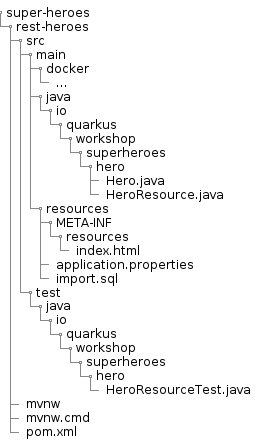
The Hero entity
Let’s start with the Hero entity class.
Create the io.quarkus.workshop.superheroes.hero.Hero class in the created project with the following content:
package io.quarkus.workshop.superheroes.hero;
import io.quarkus.hibernate.reactive.panache.PanacheEntity;
import io.smallrye.mutiny.Uni;
import jakarta.persistence.Column;
import jakarta.persistence.Entity;
import jakarta.validation.constraints.Min;
import jakarta.validation.constraints.NotNull;
import jakarta.validation.constraints.Size;
import java.util.Random;
@Entity
public class Hero extends PanacheEntity {
@NotNull
@Size(min = 3, max = 50)
public String name;
public String otherName;
@NotNull
@Min(1)
public int level;
public String picture;
@Column(columnDefinition = "TEXT")
public String powers;
public static Uni<Hero> findRandom() {
Random random = new Random();
return count()
.map(count -> random.nextInt(count.intValue()))
.chain(randomHero -> findAll().page(randomHero, 1)
.firstResult());
}
@Override
public String toString() {
return "Hero{" +
"id=" + id +
", name='" + name + '\'' +
", otherName='" + otherName + '\'' +
", level=" + level +
", picture='" + picture + '\'' +
", powers='" + powers + '\'' +
'}';
}
}First, note that we are extending io.quarkus.hibernate.reactive.panache.PanacheEntity.
It’s the reactive variant of import io.quarkus.hibernate.orm.panache.PanacheEntity.
As a consequence, methods are asynchronous, and instead of returning an object, they return asynchronous structure that will let you know when the object is ready to be consumed.
The field part is the same as for the Villain.
The toString method is also equivalent.
The major difference is the findRandom method.
Instead of returning a Hero, it returns a Uni<Hero.
A Uni represents an asynchronous action.
Unlike with the imperative development model, we cannot block the thread waiting for the result.
Here, we need to register a continuation invoked when the result is available.
During that time, the thread is released and can be used to handle another request.
Let’s split the findRandom method to better understand what’s going on:
-
count()returns aUni<Long>with the number of heroes stored in the database, -
when this count is retrieved from the database, it transforms the result into a random number,
-
when this is computed, it chains the processing with another asynchronous action which retrieve the hero located at the random index.
As a consequence this method returns a Uni<Hero>.
The consumer will need to register a continuation to receive the Hero.
Uni API in 2 minutes
Uni comes from Mutiny, an intuitive, event-driven reactive programming library.
There are a few method to understand to use Uni:
-
map: transforms (synchronously) an item when this item becomes available. -
chain: transforms an item, when it become available, into anotherUni. The outcome will be the outcome of the producedUni. -
replaceWith: replaces an item with something else. -
invoke: invokes the method when the item becomes available. It does not modify the item.
Uni is lazy. To trigger the computation you need to subscribe to it.
However, most of the time, Quarkus handles the subscription for us.
|
The Hero Resource
Unlike the VillainResource, the HeroResource uses the reactive development model.
It returns asynchronous structures (Uni)[16].
Open the HeroResource and update the content to be:
package io.quarkus.workshop.superheroes.hero;
import io.quarkus.hibernate.reactive.panache.common.WithTransaction;
import io.smallrye.mutiny.Uni;
import org.eclipse.microprofile.openapi.annotations.Operation;
import org.eclipse.microprofile.openapi.annotations.enums.SchemaType;
import org.eclipse.microprofile.openapi.annotations.media.Content;
import org.eclipse.microprofile.openapi.annotations.media.Schema;
import org.eclipse.microprofile.openapi.annotations.responses.APIResponse;
import org.eclipse.microprofile.openapi.annotations.tags.Tag;
import org.jboss.logging.Logger;
import org.jboss.resteasy.reactive.RestPath;
import org.jboss.resteasy.reactive.RestResponse;
import jakarta.validation.Valid;
import jakarta.ws.rs.DELETE;
import jakarta.ws.rs.GET;
import jakarta.ws.rs.POST;
import jakarta.ws.rs.PUT;
import jakarta.ws.rs.Path;
import jakarta.ws.rs.Produces;
import jakarta.ws.rs.core.Context;
import jakarta.ws.rs.core.MediaType;
import jakarta.ws.rs.core.Response;
import jakarta.ws.rs.core.UriBuilder;
import jakarta.ws.rs.core.UriInfo;
import java.net.URI;
import java.util.List;
import static jakarta.ws.rs.core.MediaType.APPLICATION_JSON;
@Path("/api/heroes")
@Tag(name = "heroes")
public class HeroResource {
Logger logger;
public HeroResource(Logger logger) {
this.logger = logger;
}
@Operation(summary = "Returns a random hero")
@GET
@Path("/random")
@APIResponse(responseCode = "200", content = @Content(mediaType = APPLICATION_JSON, schema = @Schema(implementation = Hero.class, required = true)))
public Uni<RestResponse<Hero>> getRandomHero() {
return Hero.findRandom()
.onItem().ifNotNull().transform(h -> {
this.logger.debugf("Found random hero: %s", h);
return RestResponse.ok(h);
})
.onItem().ifNull().continueWith(() -> {
this.logger.debug("No random villain found");
return RestResponse.notFound();
});
}
@Operation(summary = "Returns all the heroes from the database")
@GET
@APIResponse(responseCode = "200", content = @Content(mediaType = APPLICATION_JSON, schema = @Schema(implementation = Hero.class, type = SchemaType.ARRAY)))
public Uni<List<Hero>> getAllHeroes() {
return Hero.listAll();
}
@Operation(summary = "Returns a hero for a given identifier")
@GET
@Path("/{id}")
@APIResponse(responseCode = "200", content = @Content(mediaType = APPLICATION_JSON, schema = @Schema(implementation = Hero.class)))
@APIResponse(responseCode = "204", description = "The hero is not found for a given identifier")
public Uni<RestResponse<Hero>> getHero(@RestPath Long id) {
return Hero.<Hero>findById(id)
.map(hero -> {
if (hero != null) {
return RestResponse.ok(hero);
}
logger.debugf("No Hero found with id %d", id);
return RestResponse.noContent();
});
}
@Operation(summary = "Creates a valid hero")
@POST
@APIResponse(responseCode = "201", description = "The URI of the created hero", content = @Content(mediaType = APPLICATION_JSON, schema = @Schema(implementation = URI.class)))
@WithTransaction
public Uni<RestResponse<URI>> createHero(@Valid Hero hero, @Context UriInfo uriInfo) {
return hero.<Hero>persist()
.map(h -> {
UriBuilder builder = uriInfo.getAbsolutePathBuilder().path(Long.toString(h.id));
logger.debug("New Hero created with URI " + builder.build().toString());
return RestResponse.created(builder.build());
});
}
@Operation(summary = "Updates an exiting hero")
@PUT
@APIResponse(responseCode = "200", description = "The updated hero", content = @Content(mediaType = APPLICATION_JSON, schema = @Schema(implementation = Hero.class)))
@WithTransaction
public Uni<Hero> updateHero(@Valid Hero hero) {
return Hero.<Hero>findById(hero.id)
.map(retrieved -> {
retrieved.name = hero.name;
retrieved.otherName = hero.otherName;
retrieved.level = hero.level;
retrieved.picture = hero.picture;
retrieved.powers = hero.powers;
return retrieved;
})
.map(h -> {
logger.debugf("Hero updated with new valued %s", h);
return h;
});
}
@Operation(summary = "Deletes an exiting hero")
@DELETE
@Path("/{id}")
@APIResponse(responseCode = "204")
@WithTransaction
public Uni<RestResponse<Void>> deleteHero(@RestPath Long id) {
return Hero.deleteById(id)
.invoke(() -> logger.debugf("Hero deleted with %d", id))
.replaceWith(RestResponse.noContent());
}
@GET
@Produces(MediaType.TEXT_PLAIN)
@Path("/hello")
public String hello() {
return "Hello Hero Resource";
}
}The resource implements the same HTTP API as the villain counterpart. It does not use a transactional service, but uses Panache method directly.
As you can see, instead of returning the result directly, it returns Uni<T>.
Quarkus retrieves the Uni and waits for the outcome to be available before writing the response.
During that time, it can handle other requests.
Notice also the @WithTransaction, which is the reactive variant of @Transactional.
Configuring the reactive access to the database
Configuring the reactive access to the database is relatively similar to configuring the JDBC url.
Open the application.properties file and add:
## HTTP configuration
quarkus.http.port=8083
## Custom banner file path
quarkus.banner.path=banner.txt
# drop and create the database at startup (use `update` to only update the schema)
quarkus.hibernate-orm.database.generation=drop-and-create
%prod.quarkus.datasource.username=superman
%prod.quarkus.datasource.password=superman
%prod.quarkus.datasource.reactive.url=postgresql://localhost:5432/heroes_database
%prod.quarkus.hibernate-orm.sql-load-script=import.sqlThe prod profile contains the %prod.quarkus.datasource.reactive.url which configure the access to the database.
We also set the port to be 8083.
Importing heroes
Create the src/main/resources/import.sql and copy the content from import.sql.
ALTER SEQUENCE hero_seq RESTART WITH 50;
INSERT INTO hero(id, name, otherName, picture, powers, level)
VALUES (nextval('hero_seq'), 'Chewbacca', '', 'https://www.superherodb.com/pictures2/portraits/10/050/10466.jpg',
'Agility, Longevity, Marksmanship, Natural Weapons, Stealth, Super Strength, Weapons Master', 5);
INSERT INTO hero(id, name, otherName, picture, powers, level)
VALUES (nextval('hero_seq'), 'Angel Salvadore', 'Angel Salvadore Bohusk',
'https://www.superherodb.com/pictures2/portraits/10/050/1406.jpg',
'Animal Attributes, Animal Oriented Powers, Flight, Regeneration, Toxin and Disease Control', 4);
INSERT INTO hero(id, name, otherName, picture, powers, level)
VALUES (nextval('hero_seq'), 'Bill Harken', '', 'https://www.superherodb.com/pictures2/portraits/10/050/1527.jpg',
'Super Speed, Super Strength, Toxin and Disease Resistance', 6);
...Testing the heroes
Time for some tests!
Open the io.quarkus.workshop.superheroes.hero.HeroResourceTest class and copy the following content:
package io.quarkus.workshop.superheroes.hero;
import io.quarkus.test.junit.QuarkusTest;
import io.restassured.common.mapper.TypeRef;
import org.hamcrest.core.Is;
import org.junit.jupiter.api.MethodOrderer;
import org.junit.jupiter.api.Order;
import org.junit.jupiter.api.Test;
import org.junit.jupiter.api.TestMethodOrder;
import java.util.List;
import java.util.Random;
import static io.restassured.RestAssured.get;
import static io.restassured.RestAssured.given;
import static jakarta.ws.rs.core.HttpHeaders.ACCEPT;
import static jakarta.ws.rs.core.HttpHeaders.CONTENT_TYPE;
import static jakarta.ws.rs.core.MediaType.APPLICATION_JSON;
import static jakarta.ws.rs.core.MediaType.TEXT_PLAIN;
import static jakarta.ws.rs.core.Response.Status.BAD_REQUEST;
import static jakarta.ws.rs.core.Response.Status.CREATED;
import static jakarta.ws.rs.core.Response.Status.NO_CONTENT;
import static jakarta.ws.rs.core.Response.Status.OK;
import static org.hamcrest.CoreMatchers.is;
import static org.junit.jupiter.api.Assertions.assertEquals;
import static org.junit.jupiter.api.Assertions.assertNotNull;
import static org.junit.jupiter.api.Assertions.assertTrue;
@QuarkusTest
@TestMethodOrder(MethodOrderer.OrderAnnotation.class)
public class HeroResourceTest {
private static final String JSON = "application/json;charset=UTF-8";
private static final String DEFAULT_NAME = "Super Baguette";
private static final String UPDATED_NAME = "Super Baguette (updated)";
private static final String DEFAULT_OTHER_NAME = "Super Baguette Tradition";
private static final String UPDATED_OTHER_NAME = "Super Baguette Tradition (updated)";
private static final String DEFAULT_PICTURE = "super_baguette.png";
private static final String UPDATED_PICTURE = "super_baguette_updated.png";
private static final String DEFAULT_POWERS = "eats baguette really quickly";
private static final String UPDATED_POWERS = "eats baguette really quickly (updated)";
private static final int DEFAULT_LEVEL = 42;
private static final int UPDATED_LEVEL = 43;
private static final int NB_HEROES = 941;
private static String heroId;
@Test
void shouldPingOpenAPI() {
given()
.header(ACCEPT, APPLICATION_JSON)
.when()
.get("/q/openapi")
.then()
.statusCode(OK.getStatusCode());
}
@Test
public void testHelloEndpoint() {
given()
.header(ACCEPT, TEXT_PLAIN)
.when()
.get("/api/heroes/hello")
.then()
.statusCode(200)
.body(is("Hello Hero Resource"));
}
@Test
void shouldNotGetUnknownHero() {
Long randomId = new Random().nextLong();
given()
.pathParam("id", randomId)
.when()
.get("/api/heroes/{id}")
.then()
.statusCode(NO_CONTENT.getStatusCode());
}
@Test
void shouldGetRandomHero() {
given()
.when()
.get("/api/heroes/random")
.then()
.statusCode(OK.getStatusCode())
.contentType(APPLICATION_JSON);
}
@Test
void shouldNotAddInvalidItem() {
Hero hero = new Hero();
hero.name = null;
hero.otherName = DEFAULT_OTHER_NAME;
hero.picture = DEFAULT_PICTURE;
hero.powers = DEFAULT_POWERS;
hero.level = 0;
given()
.body(hero)
.header(CONTENT_TYPE, APPLICATION_JSON)
.header(ACCEPT, APPLICATION_JSON)
.when()
.post("/api/heroes")
.then()
.statusCode(BAD_REQUEST.getStatusCode());
}
@Test
@Order(1)
void shouldGetInitialItems() {
List<Hero> heroes = get("/api/heroes").then()
.statusCode(OK.getStatusCode())
.contentType(APPLICATION_JSON)
.extract()
.body()
.as(getHeroTypeRef());
assertEquals(NB_HEROES, heroes.size());
}
@Test
@Order(2)
void shouldAddAnItem() {
Hero hero = new Hero();
hero.name = DEFAULT_NAME;
hero.otherName = DEFAULT_OTHER_NAME;
hero.picture = DEFAULT_PICTURE;
hero.powers = DEFAULT_POWERS;
hero.level = DEFAULT_LEVEL;
String location = given()
.body(hero)
.header(CONTENT_TYPE, APPLICATION_JSON)
.header(ACCEPT, APPLICATION_JSON)
.when()
.post("/api/heroes")
.then()
.statusCode(CREATED.getStatusCode())
.extract()
.header("Location");
assertTrue(location.contains("/api/heroes"));
// Stores the id
String[] segments = location.split("/");
heroId = segments[segments.length - 1];
assertNotNull(heroId);
given()
.pathParam("id", heroId)
.when()
.get("/api/heroes/{id}")
.then()
.statusCode(OK.getStatusCode())
.body("name", Is.is(DEFAULT_NAME))
.body("otherName", Is.is(DEFAULT_OTHER_NAME))
.body("level", Is.is(DEFAULT_LEVEL))
.body("picture", Is.is(DEFAULT_PICTURE))
.body("powers", Is.is(DEFAULT_POWERS));
List<Hero> heroes = get("/api/heroes").then()
.statusCode(OK.getStatusCode())
.extract()
.body()
.as(getHeroTypeRef());
assertEquals(NB_HEROES + 1, heroes.size());
}
@Test
@Order(3)
void shouldUpdateAnItem() {
Hero hero = new Hero();
hero.id = Long.valueOf(heroId);
hero.name = UPDATED_NAME;
hero.otherName = UPDATED_OTHER_NAME;
hero.picture = UPDATED_PICTURE;
hero.powers = UPDATED_POWERS;
hero.level = UPDATED_LEVEL;
given()
.body(hero)
.header(CONTENT_TYPE, APPLICATION_JSON)
.header(ACCEPT, APPLICATION_JSON)
.when()
.put("/api/heroes")
.then()
.statusCode(OK.getStatusCode())
.contentType(APPLICATION_JSON)
.body("name", Is.is(UPDATED_NAME))
.body("otherName", Is.is(UPDATED_OTHER_NAME))
.body("level", Is.is(UPDATED_LEVEL))
.body("picture", Is.is(UPDATED_PICTURE))
.body("powers", Is.is(UPDATED_POWERS));
List<Hero> heroes = get("/api/heroes").then()
.statusCode(OK.getStatusCode())
.contentType(APPLICATION_JSON)
.extract()
.body()
.as(getHeroTypeRef());
assertEquals(NB_HEROES + 1, heroes.size());
}
@Test
@Order(4)
void shouldRemoveAnItem() {
given()
.pathParam("id", heroId)
.when()
.delete("/api/heroes/{id}")
.then()
.statusCode(NO_CONTENT.getStatusCode());
List<Hero> heroes = get("/api/heroes").then()
.statusCode(OK.getStatusCode())
.contentType(APPLICATION_JSON)
.extract()
.body()
.as(getHeroTypeRef());
assertEquals(NB_HEROES, heroes.size());
}
private TypeRef<List<Hero>> getHeroTypeRef() {
return new TypeRef<List<Hero>>() {
// Kept empty on purpose
};
}
}The tests are very similar to the ones from the villain service.
Running, Testing and Packaging the Application
First, make sure the tests pass by executing the command ./mvnw test (or from your IDE).
Now that the tests are green, we are ready to run our application.
Use ./mvnw quarkus:dev to start it.
Once the application is started, create a new hero with the following cUrl command:
curl -X POST -d '{"level":2, "name":"Super level", "powers":"leaping"}' -H "Content-Type: application/json" http://localhost:8083/api/heroes -vThanks to the verbose mode (-v) you should see a similar output:
< HTTP/1.1 201 Created
< Location: http://localhost:8083/api/heroes/952The cUrl command returns the location of the newly created hero. Take this URL and do an HTTP GET on it.
|
The example shows a newly created Hero with id |
curl http://localhost:8083/api/heroes/952 | jq{
"id": 952,
"name": "Super level",
"otherName": null,
"level": 2,
"picture": null,
"powers": "leaping"
}Remember that you can also check Swagger UI by going to the dev console: http://localhost:8083/q/dev.
Then, build the application using: ./mvnw package, and run the application using java -jar target/quarkus-app/quarkus-run.jar.
Open your browser and go to http://localhost:8083/api/heroes.
From Microservice to Microservices
So far we’ve built two microservices: the villains and heroes microservices. In the following sections you will develop an extra microservice: a fight microservice where heroes and villains fight. We will also add a React front-end, so we can fight graphically. But as you can notice in the diagram below, these microservices still not communicate with each other. You will have to wait the next chapter for that ;o)
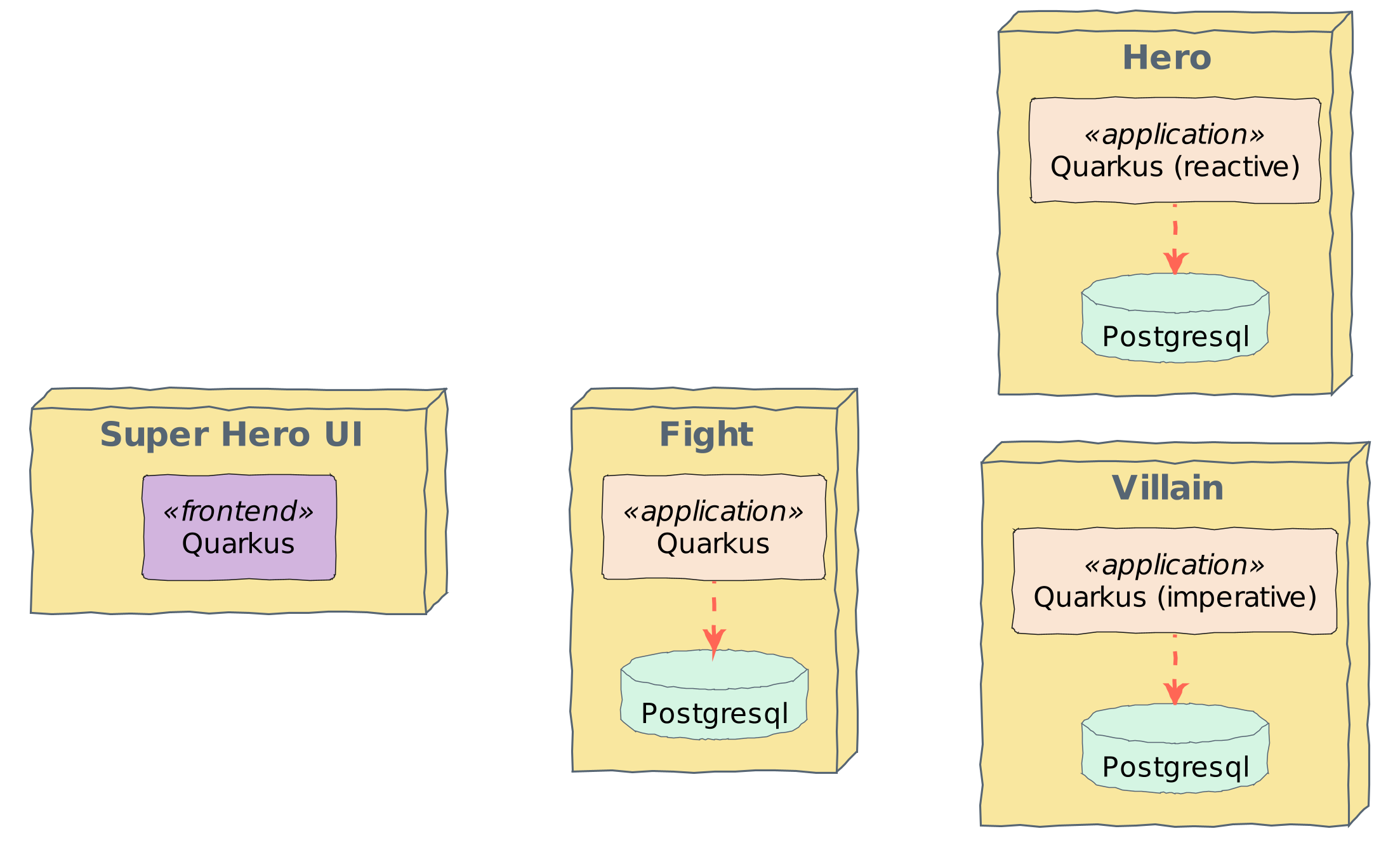
Each microservice is developed in its own directory.
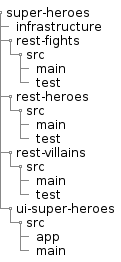
In the following sections, you will:
-
Create a new Quarkus application
-
Implement REST API using JAX-RS
-
Access your database using Hibernate ORM with Panache
-
Use transactions
| This service is exposed on the port 8082. |
Fight Microservice
Ok, let’s develop another microservice. We have a REST API that returns a random Hero. Another REST API that returns a random Villain… we need a new REST API that invokes those two, gets one random hero and one random villain and makes them fight. Let’s call it the Fight API.
| This microservice uses the imperative development model but use reactive extensions. |
Bootstrapping the Fight REST Endpoint
Like for the Hero and Villain API, the easiest way to create this new Quarkus project is to use a Maven archetype.
Under the quarkus-workshop-super-heroes/super-heroes root directory where you have all your code.
Open a terminal and run the following command:
./mvnw io.quarkus:quarkus-maven-plugin:3.27.0:create \
-DplatformVersion=3.27.0 \
-DprojectGroupId=io.quarkus.workshop.super-heroes \
-DprojectArtifactId=rest-fights \
-DclassName="io.quarkus.workshop.superheroes.fight.FightResource" \
-Dpath="api/fights" \
-Dextensions="jdbc-postgresql,hibernate-orm-panache,hibernate-validator,rest-jackson,smallrye-openapi,kafka"If you open the pom.xml file, you will see that the following extensions have been imported:
-
io.quarkus:quarkus-hibernate-orm-panache -
io.quarkus:quarkus-hibernate-validator -
io.quarkus:quarkus-smallrye-openapi -
io.quarkus:quarkus-messaging-kafka -
io.quarkus:quarkus-rest-jackson -
io.quarkus:quarkus-jdbc-postgresql
You can see that beyond the extensions we have used so far, we added the Kafka support which uses Eclipse MicroProfile Reactive Messaging. Stay tuned.
The Quarkus Maven plugin has generated some code that we won’t be using.
You can delete the Java classes MyReactiveMessagingApplication and MyReactiveMessagingApplicationTest.
If you want your IDE to manage this new Maven project, you can declare it in the parent POM by adding this new module in the <modules> section:
<module>super-heroes/rest-fights</module>Directory Structure
At the end you should have the following directory structure:
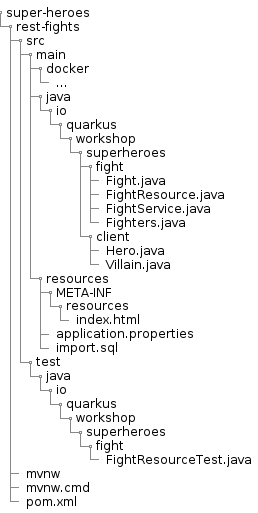
Fight Entity
A fight is between a hero and a villain.
Each time there is a fight, there is a winner and a loser.
So the Fight entity is there to store all these fights.
Create the io.quarkus.workshop.superheroes.fight.Fight class with the following content:
package io.quarkus.workshop.superheroes.fight;
import io.quarkus.hibernate.orm.panache.PanacheEntity;
import org.eclipse.microprofile.openapi.annotations.media.Schema;
import jakarta.persistence.Column;
import jakarta.persistence.Entity;
import jakarta.validation.constraints.NotNull;
import java.time.Instant;
@Entity
@Schema(description = "Each fight has a winner and a loser")
public class Fight extends PanacheEntity {
@NotNull
public Instant fightDate;
@NotNull
public String winnerName;
@NotNull
public int winnerLevel;
@NotNull
@Column(columnDefinition = "TEXT")
public String winnerPowers;
@NotNull
public String winnerPicture;
@NotNull
public String loserName;
@NotNull
public int loserLevel;
@NotNull
@Column(columnDefinition = "TEXT")
public String loserPowers;
@NotNull
public String loserPicture;
@NotNull
public String winnerTeam;
@NotNull
public String loserTeam;
}Fighters Bean
Now comes a trick.
The Fight REST API will ultimately invoke the Hero and Villain APIs (next sections) to get two random fighters.
The Fighters class has one Hero and one Villain.
Notice that Fighters is not an entity, it is not persisted in the database, just marshalled and unmarshalled to JSon.
Create the io.quarkus.workshop.superheroes.fight.Fighters class, with the following content:
package io.quarkus.workshop.superheroes.fight;
import io.quarkus.workshop.superheroes.fight.client.Hero;
import io.quarkus.workshop.superheroes.fight.client.Villain;
import org.eclipse.microprofile.openapi.annotations.media.Schema;
import jakarta.validation.constraints.NotNull;
@Schema(description = "A fight between one hero and one villain")
public class Fighters {
@NotNull
public Hero hero;
@NotNull
public Villain villain;
}It does not compile because it needs a Hero class and a Villain class.
The Fight REST API is just interested in the hero’s name, level, picture and powers (not the other name as described in the Hero API).
So create the Hero bean looks like this (notice the client subpackage):
package io.quarkus.workshop.superheroes.fight.client;
import org.eclipse.microprofile.openapi.annotations.media.Schema;
import jakarta.validation.constraints.NotNull;
@Schema(description = "The hero fighting against the villain")
public class Hero {
@NotNull
public String name;
@NotNull
public int level;
@NotNull
public String picture;
public String powers;
}Also create the Villain counterpart (also in the client subpackage):
package io.quarkus.workshop.superheroes.fight.client;
import org.eclipse.microprofile.openapi.annotations.media.Schema;
import jakarta.validation.constraints.NotNull;
@Schema(description = "The villain fighting against the hero")
public class Villain {
@NotNull
public String name;
@NotNull
public int level;
@NotNull
public String picture;
public String powers;
}So, these classes are just used to map the results from the Hero and Villain microservices.
FightService Transactional Service
Now, let’s create a FightService class that orchestrate the fights.
Create the io.quarkus.workshop.superheroes.fight.FightService class with the following content:
package io.quarkus.workshop.superheroes.fight;
import org.jboss.logging.Logger;
import jakarta.enterprise.context.ApplicationScoped;
import jakarta.inject.Inject;
import jakarta.transaction.Transactional;
import java.time.Instant;
import java.util.List;
import java.util.Random;
import static jakarta.transaction.Transactional.TxType.REQUIRED;
import static jakarta.transaction.Transactional.TxType.SUPPORTS;
@ApplicationScoped
@Transactional(SUPPORTS)
public class FightService {
@Inject Logger logger;
private final Random random = new Random();
public List<Fight> findAllFights() {
return Fight.listAll();
}
public Fight findFightById(Long id) {
return Fight.findById(id);
}
public Fighters findRandomFighters() {
// Will be implemented later
return null;
}
@Transactional(REQUIRED)
public Fight persistFight(Fighters fighters) {
// Amazingly fancy logic to determine the winner...
Fight fight;
int heroAdjust = random.nextInt(20);
int villainAdjust = random.nextInt(20);
if ((fighters.hero.level + heroAdjust)
> (fighters.villain.level + villainAdjust)) {
fight = heroWon(fighters);
} else if (fighters.hero.level < fighters.villain.level) {
fight = villainWon(fighters);
} else {
fight = random.nextBoolean() ? heroWon(fighters) : villainWon(fighters);
}
fight.fightDate = Instant.now();
fight.persist();
return fight;
}
private Fight heroWon(Fighters fighters) {
logger.info("Yes, Hero won :o)");
Fight fight = new Fight();
fight.winnerName = fighters.hero.name;
fight.winnerPicture = fighters.hero.picture;
fight.winnerLevel = fighters.hero.level;
fight.winnerPowers = fighters.hero.powers;
fight.loserName = fighters.villain.name;
fight.loserPicture = fighters.villain.picture;
fight.loserLevel = fighters.villain.level;
fight.loserPowers = fighters.villain.powers;
fight.winnerTeam = "heroes";
fight.loserTeam = "villains";
return fight;
}
private Fight villainWon(Fighters fighters) {
logger.info("Gee, Villain won :o(");
Fight fight = new Fight();
fight.winnerName = fighters.villain.name;
fight.winnerPicture = fighters.villain.picture;
fight.winnerLevel = fighters.villain.level;
fight.winnerPowers = fighters.villain.powers;
fight.loserName = fighters.hero.name;
fight.loserPicture = fighters.hero.picture;
fight.loserLevel = fighters.hero.level;
fight.loserPowers = fighters.hero.powers;
fight.winnerTeam = "villains";
fight.loserTeam = "heroes";
return fight;
}
}Notice the persistFight method.
This method is the one creating a fight between a hero and a villain.
As you can see the algorithm to determine the winner is a bit random (even though it uses the levels).
If you are not happy about the way the fight operates, choose your own winning algorithm ;o)
|
For now, the |
FightResource Endpoint
To expose a REST API we also need a FightResource (with OpenAPI annotations of course).
package io.quarkus.workshop.superheroes.fight;
import jakarta.ws.rs.*;
import org.eclipse.microprofile.config.inject.ConfigProperty;
import org.jboss.logging.Logger;
import jakarta.enterprise.context.ApplicationScoped;
import jakarta.inject.Inject;
import jakarta.validation.Valid;
import jakarta.ws.rs.core.MediaType;
import jakarta.ws.rs.core.Response;
import jakarta.ws.rs.core.UriInfo;
import java.util.List;
import static jakarta.ws.rs.core.MediaType.APPLICATION_JSON;
import static jakarta.ws.rs.core.MediaType.TEXT_PLAIN;
@Path("/api/fights")
@Produces(APPLICATION_JSON)
@ApplicationScoped
public class FightResource {
@Inject
Logger logger;
@Inject
FightService service;
@GET
@Path("/randomfighters")
public Response getRandomFighters() {
Fighters fighters = service.findRandomFighters();
logger.debug("Get random fighters " + fighters);
return Response.ok(fighters).build();
}
@GET
public Response getAllFights() {
List<Fight> fights = service.findAllFights();
logger.debug("Total number of fights " + fights);
return Response.ok(fights).build();
}
@GET
@Path("/{id}")
public Response getFight(Long id) {
Fight fight = service.findFightById(id);
if (fight != null) {
logger.debug("Found fight " + fight);
return Response.ok(fight).build();
} else {
logger.debug("No fight found with id " + id);
return Response.noContent().build();
}
}
@POST
public Fight fight(@Valid Fighters fighters, UriInfo uriInfo) {
return service.persistFight(fighters);
}
@GET
@Produces(MediaType.TEXT_PLAIN)
@Path("/hello")
public String hello() {
return "Hello Fight Resource";
}
}|
The OpenAPI annotations have been omitted to keep the service focused on the task. Feel free to add them if you want complete OpenAPI descriptors. Notice that most of the REST endpoints that you’ve seen so far produce or consume JSON.
JSON being the default media type in Quarkus, we could have omitted the |
Adding Data
To load some SQL statements when Hibernate ORM starts, create the src/main/resources/import.sql file with the following content:
ALTER SEQUENCE fight_seq RESTART WITH 50;
INSERT INTO fight(id, fightDate, winnerName, winnerLevel, winnerPicture, winnerPowers, loserName, loserLevel, loserPicture, loserPowers, winnerTeam, loserTeam)
VALUES (nextval('fight_seq'), current_timestamp,
'Chewbacca', 5, 'https://www.superherodb.com/pictures2/portraits/10/050/10466.jpg', 'Agility, Longevity, Marksmanship, Natural Weapons, Stealth, Super Strength, Weapons Master',
'Buuccolo', 3, 'https://www.superherodb.com/pictures2/portraits/10/050/15355.jpg', 'Accelerated Healing, Adaptation, Agility, Flight, Immortality, Intelligence, Invulnerability, Reflexes, Self-Sustenance, Size Changing, Spatial Awareness, Stamina, Stealth, Super Breath, Super Speed, Super Strength, Teleportation',
'heroes', 'villains');
INSERT INTO fight(id, fightDate, winnerName, winnerLevel, winnerPicture, winnerPowers, loserName, loserLevel, loserPicture, loserPowers, winnerTeam, loserTeam)
VALUES (nextval('fight_seq'), current_timestamp,
'Galadriel', 10, 'https://www.superherodb.com/pictures2/portraits/10/050/11796.jpg', 'Danger Sense, Immortality, Intelligence, Invisibility, Magic, Precognition, Telekinesis, Telepathy',
'Darth Vader', 8, 'https://www.superherodb.com/pictures2/portraits/10/050/10444.jpg', 'Accelerated Healing, Agility, Astral Projection, Cloaking, Danger Sense, Durability, Electrokinesis, Energy Blasts, Enhanced Hearing, Enhanced Senses, Force Fields, Hypnokinesis, Illusions, Intelligence, Jump, Light Control, Marksmanship, Precognition, Psionic Powers, Reflexes, Stealth, Super Speed, Telekinesis, Telepathy, The Force, Weapons Master',
'heroes', 'villains');
INSERT INTO fight(id, fightDate, winnerName, winnerLevel, winnerPicture, winnerPowers, loserName, loserLevel, loserPicture, loserPowers, winnerTeam, loserTeam)
VALUES (nextval('fight_seq'), current_timestamp,
'Annihilus', 23, 'https://www.superherodb.com/pictures2/portraits/10/050/1307.jpg', 'Agility, Durability, Flight, Reflexes, Stamina, Super Speed, Super Strength',
'Shikamaru', 1, 'https://www.superherodb.com/pictures2/portraits/10/050/11742.jpg', 'Adaptation, Agility, Element Control, Fire Control, Intelligence, Jump, Marksmanship, Possession, Reflexes, Shapeshifting, Stamina, Stealth, Telekinesis, Wallcrawling, Weapon-based Powers, Weapons Master',
'villains', 'heroes');Configuration
As usual, we need to configure the application.
In the application.properties file add:
## HTTP configuration
quarkus.http.port=8082
## Custom banner file path
quarkus.banner.path=banner.txt
## drop and create the database at startup (use `update` to only update the schema)
quarkus.hibernate-orm.database.generation=drop-and-create
## Logging configuration
quarkus.log.console.enable=true
quarkus.log.console.format=%d{HH:mm:ss} %-5p [%c{2.}] (%t) %s%e%n
quarkus.log.console.level=DEBUG
## Production configuration
%prod.quarkus.datasource.jdbc.url=jdbc:postgresql://localhost:5432/fights_database
%prod.quarkus.datasource.db-kind=postgresql
%prod.quarkus.datasource.username=superfight
%prod.quarkus.datasource.password=superfight
%prod.quarkus.hibernate-orm.sql-load-script=import.sql
%prod.quarkus.log.console.level=INFO
%prod.quarkus.hibernate-orm.database.generation=update
## Kafka configurationNote that the fight service uses the port 8082.
FightResourceTest Test Class
We need to test our REST API.
For that, copy the following FightResourceTest class under the src/test/java/io/quarkus/workshop/superheroes/fight directory.
package io.quarkus.workshop.superheroes.fight;
import io.quarkus.test.junit.QuarkusTest;
import io.quarkus.workshop.superheroes.fight.client.Hero;
import io.quarkus.workshop.superheroes.fight.client.Villain;
import io.restassured.common.mapper.TypeRef;
import org.hamcrest.core.Is;
import org.junit.jupiter.api.MethodOrderer;
import org.junit.jupiter.api.Order;
import org.junit.jupiter.api.Test;
import org.junit.jupiter.api.TestMethodOrder;
import java.util.List;
import java.util.Random;
import static io.restassured.RestAssured.get;
import static io.restassured.RestAssured.given;
import static jakarta.ws.rs.core.HttpHeaders.ACCEPT;
import static jakarta.ws.rs.core.HttpHeaders.CONTENT_TYPE;
import static jakarta.ws.rs.core.MediaType.APPLICATION_JSON;
import static jakarta.ws.rs.core.Response.Status.*;
import static org.hamcrest.CoreMatchers.*;
import static org.junit.jupiter.api.Assertions.assertEquals;
import static org.junit.jupiter.api.Assertions.assertNotNull;
@QuarkusTest
@TestMethodOrder(MethodOrderer.OrderAnnotation.class)
public class FightResourceTest {
private static final String DEFAULT_WINNER_NAME = "Super Baguette";
private static final String DEFAULT_WINNER_PICTURE = "super_baguette.png";
private static final int DEFAULT_WINNER_LEVEL = 42;
private static final String DEFAULT_WINNER_POWERS = "Eats baguette in less than a second";
private static final String DEFAULT_LOSER_NAME = "Super Chocolatine";
private static final String DEFAULT_LOSER_PICTURE = "super_chocolatine.png";
private static final int DEFAULT_LOSER_LEVEL = 6;
private static final String DEFAULT_LOSER_POWERS = "Transforms chocolatine into pain au chocolat";
private static final int NB_FIGHTS = 3;
private static String fightId;
@Test
void shouldPingOpenAPI() {
given()
.header(ACCEPT, APPLICATION_JSON)
.when().get("/q/openapi")
.then()
.statusCode(OK.getStatusCode());
}
@Test
public void testHelloEndpoint() {
given()
.when().get("/api/fights/hello")
.then()
.statusCode(200)
.body(is("Hello Fight Resource"));
}
@Test
void shouldNotGetUnknownFight() {
Long randomId = new Random().nextLong();
given()
.pathParam("id", randomId)
.when().get("/api/fights/{id}")
.then()
.statusCode(NO_CONTENT.getStatusCode());
}
@Test
void shouldNotAddInvalidItem() {
Fighters fighters = new Fighters();
fighters.hero = null;
fighters.villain = null;
given()
.body(fighters)
.header(CONTENT_TYPE, APPLICATION_JSON)
.header(ACCEPT, APPLICATION_JSON)
.when()
.post("/api/fights")
.then()
.statusCode(BAD_REQUEST.getStatusCode());
}
@Test
@Order(1)
void shouldGetInitialItems() {
List<Fight> fights = get("/api/fights").then()
.statusCode(OK.getStatusCode())
.extract().body().as(getFightTypeRef());
assertEquals(NB_FIGHTS, fights.size());
}
@Test
@Order(2)
void shouldAddAnItem() {
Hero hero = new Hero();
hero.name = DEFAULT_WINNER_NAME;
hero.picture = DEFAULT_WINNER_PICTURE;
hero.level = DEFAULT_WINNER_LEVEL;
hero.powers = DEFAULT_WINNER_POWERS;
Villain villain = new Villain();
villain.name = DEFAULT_LOSER_NAME;
villain.picture = DEFAULT_LOSER_PICTURE;
villain.level = DEFAULT_LOSER_LEVEL;
villain.powers = DEFAULT_LOSER_POWERS;
Fighters fighters = new Fighters();
fighters.hero = hero;
fighters.villain = villain;
fightId = given()
.body(fighters)
.header(CONTENT_TYPE, APPLICATION_JSON)
.header(ACCEPT, APPLICATION_JSON)
.when()
.post("/api/fights")
.then()
.statusCode(OK.getStatusCode())
.body(containsString("winner"), containsString("loser"))
.extract().body().jsonPath().getString("id");
assertNotNull(fightId);
given()
.pathParam("id", fightId)
.when().get("/api/fights/{id}")
.then()
.statusCode(OK.getStatusCode())
.contentType(APPLICATION_JSON)
.body("winnerName", Is.is(DEFAULT_WINNER_NAME))
.body("winnerPicture", Is.is(DEFAULT_WINNER_PICTURE))
.body("winnerLevel", Is.is(DEFAULT_WINNER_LEVEL))
.body("winnerPowers", Is.is(DEFAULT_WINNER_POWERS))
.body("loserName", Is.is(DEFAULT_LOSER_NAME))
.body("loserPicture", Is.is(DEFAULT_LOSER_PICTURE))
.body("loserLevel", Is.is(DEFAULT_LOSER_LEVEL))
.body("loserPowers", Is.is(DEFAULT_LOSER_POWERS))
.body("fightDate", Is.is(notNullValue()));
List<Fight> fights = get("/api/fights").then()
.statusCode(OK.getStatusCode())
.extract().body().as(getFightTypeRef());
assertEquals(NB_FIGHTS + 1, fights.size());
}
private TypeRef<List<Fight>> getFightTypeRef() {
return new TypeRef<List<Fight>>() {
// Kept empty on purpose
};
}
}Running, Testing and Packaging the Application
First, delete the generated FightResourceIT native test class, as we won’t run native tests.
Then, make sure the tests pass by executing the command ./mvnw test (or from your IDE).
Quarkus automatically starts the PostGreSQL database.
Now that the tests are green, we are ready to run our application.
Use ./mvnw quarkus:dev to start it (notice that there is no banner yet, it will come later).
Once the application is started, just check that it returns the fights from the database with the following cURL command:
curl http://localhost:8082/api/fightsRemember that you can also check Swagger UI by going to http://localhost:8082/q/swagger-ui.
User Interface
Now that we have the three main microservices, time to have a decent user interface to start fighting. The purpose of this workshop is not to develop a web interface and learn yet another web framework. This time you will just execute another Quarkus instance with an already React application. We will be using Quinoa to handle building and serving the React application.
Quinoa?
Quinoa is a Quarkus extension which eases the development of single page apps or web components.
It lets you live code the backend and frontend together with close to no configuration.
It also helps with both packaging and serving, and if you want it to, abstracts away npm.
When enabled in development mode, Quinoa will start the UI live coding server provided by the target framework and forward relevant requests to it. In production mode, Quinoa will run the build and process the generated files to serve them at runtime.
Quinoa is framework-agnostic, and works with React, Angular, Vue, Lit, and others, alongside other Quarkus services (REST, GraphQL, Security, Events, etc).
The Web Application
Navigate to the super-heroes/ui-super-heroes directory.
It contains the code of the application.
The React application is in src/main/webui.
Being a React application, you will find a package.json file which defines all the needed dependencies.
All the React code (graphical components, model, services) is located under src/main/webui/src/app.
Running the Web Application
We don’t need to worry too much about the React code.
From the ui-super-heroes
directory, use ./mvnw quarkus:dev to start the web application.
Be sure you have the hero, villain and fights microservices running (dev mode is enough).
If you don’t have Node installed, Quinoa will install it during the start process (under the .quinoa directory).
INFO [com.git.eir.mav.plu.fro.lib.NodeInstaller] (build-40) Installing node version v16.16.0
INFO [com.git.eir.mav.plu.fro.lib.NodeInstaller] (build-40) Extracting NPM
INFO [com.git.eir.mav.plu.fro.lib.NodeInstaller] (build-40) Installed node locally.You should see console output like the following
2023-05-18 14:22:02,745 INFO [io.qua.qui.dep.ForwardedDevProcessor] (build-5) Quinoa package manager live coding is up and running on port: 3000 (in 18118ms)
2023-05-18 14:22:02,749 INFO [io.qua.qui.dep.ForwardedDevProcessor] (build-40) Quinoa is forwarding unhandled requests to port: 3000
__ ____ __ _____ ___ __ ____ ______
--/ __ \/ / / / _ | / _ \/ //_/ / / / __/
-/ /_/ / /_/ / __ |/ , _/ ,< / /_/ /\ \
--\___\_\____/_/ |_/_/|_/_/|_|\____/___/
2023-05-18 14:22:03,237 INFO [io.quarkus] (Quarkus Main Thread) ui-super-heroes 1.0.0-SNAPSHOT on JVM (powered by Quarkus 3.27.0) started in 24.765s. Listening on: http://localhost:8080Once the application is started, go to http://localhost:8080 (8080 is the default Quarkus port as we didn’t change it in the application.properties this time).
It should display a main web page. There won’t be much content yet,
because we need to fix a few things and add some more implementation.

If you want, you can visit http://localhost:3000 (the usual React port) to confirm that Quinoa is forwarding what’s on port 3000 to port 8080. The version of the application on http://localhost:3000 will always stay disappointingly blank, because it’s looking for its config on the wrong port. So don’t use that one!
You might want to create a fuller Quarkus BFF for the UI, and use something like Stork for service discovery. However, that’s beyond the scope of this workshop!
Live coding the UI
Live coding works for the javascript parts of the application, just as it does for the Java ones.
Open src/main/webui/src/app/app.component.html and edit the text, perhaps by adding 'Hello there' into the welcome message.
Check localhost:8080, and your new content should appear.
(It may take a moment or two for the refresh to trigger.)
You can also change the javascript code.
For example, try updating the text in src/main/webui/src/app/app.component.ts.
CORS
Cross-origin resource sharing (CORS) is a mechanism that allows restricted resources on a web page to be requested from another domain outside the domain from which the first resource was served.[17] So when we want our heroes and villains to fight, we actually cross several origins: we go from localhost:8080 (the UI) to localhost:8082 (Fight API) which invokes localhost:8083 (Hero) and localhost:8084 (Villain). If you look at the console of your Browser you should see something similar to this:
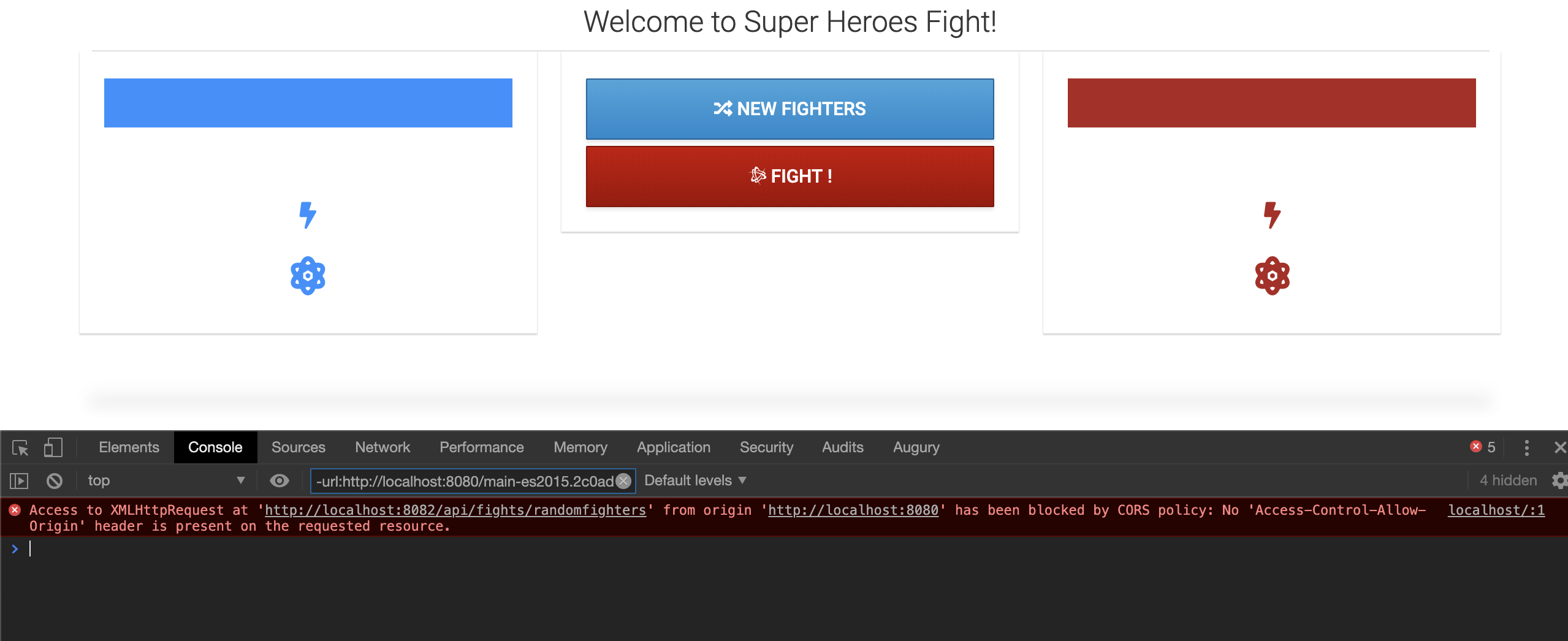
Quarkus comes with a CORS filter which intercepts all incoming HTTP requests. It can be enabled in the Quarkus configuration file:
quarkus.http.cors.enabled=trueIf the filter is enabled and an HTTP request is identified as cross-origin, the CORS policy and headers defined using the following properties will be applied before passing the request on to its actual target (servlet, JAX-RS resource, etc.):
| Property | Description |
|---|---|
|
The comma-separated list of origins allowed for CORS. The filter allows any origin if this is not set. |
|
The comma-separated list of HTTP methods allowed for CORS. The filter allows any method if this is not set. |
|
The comma-separated list of HTTP headers allowed for CORS. The filter allows any header if this is not set. |
|
The comma-separated list of HTTP headers exposed in CORS. |
|
The duration indicating how long the results of a pre-flight request can be cached. This value will be returned in a Access-Control-Max-Age response header. |
So make sure you set the following properties on the:
-
Fight microservice,
-
Hero microservice,
-
Villain microservice
quarkus.http.cors.enabled=true
quarkus.http.cors.origins=/.*/But, even with this, the UI is still not working. The CORS errors are gone, so that’s a good step, but we forgot something else:
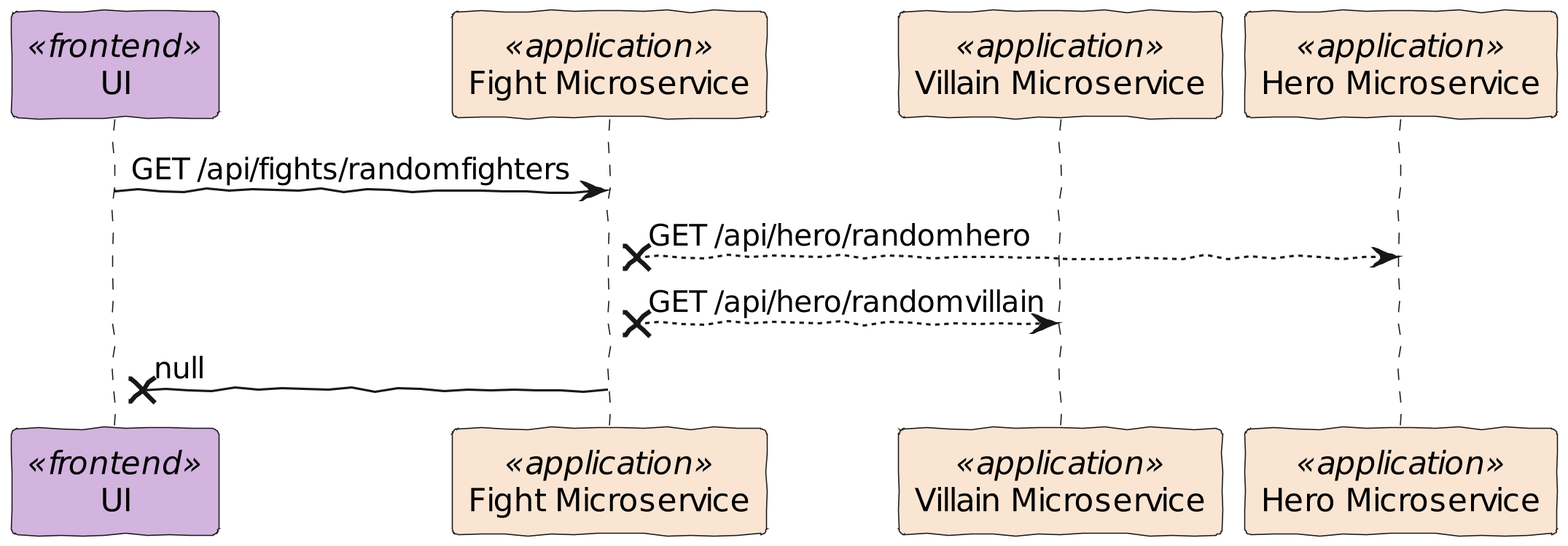
Remember the function to retrieve random fighters.
We are currently returning null.
Let’s move to the next session to see how we can implement this method.
HTTP communication & Fault Tolerance
So far we’ve built one Fight microservice which need to invoke the Hero and Villain microservices. In the following sections you will develop this invocation thanks to the MicroProfile REST Client. We will also deal with fault tolerance thanks to timeouts and circuit breaker.
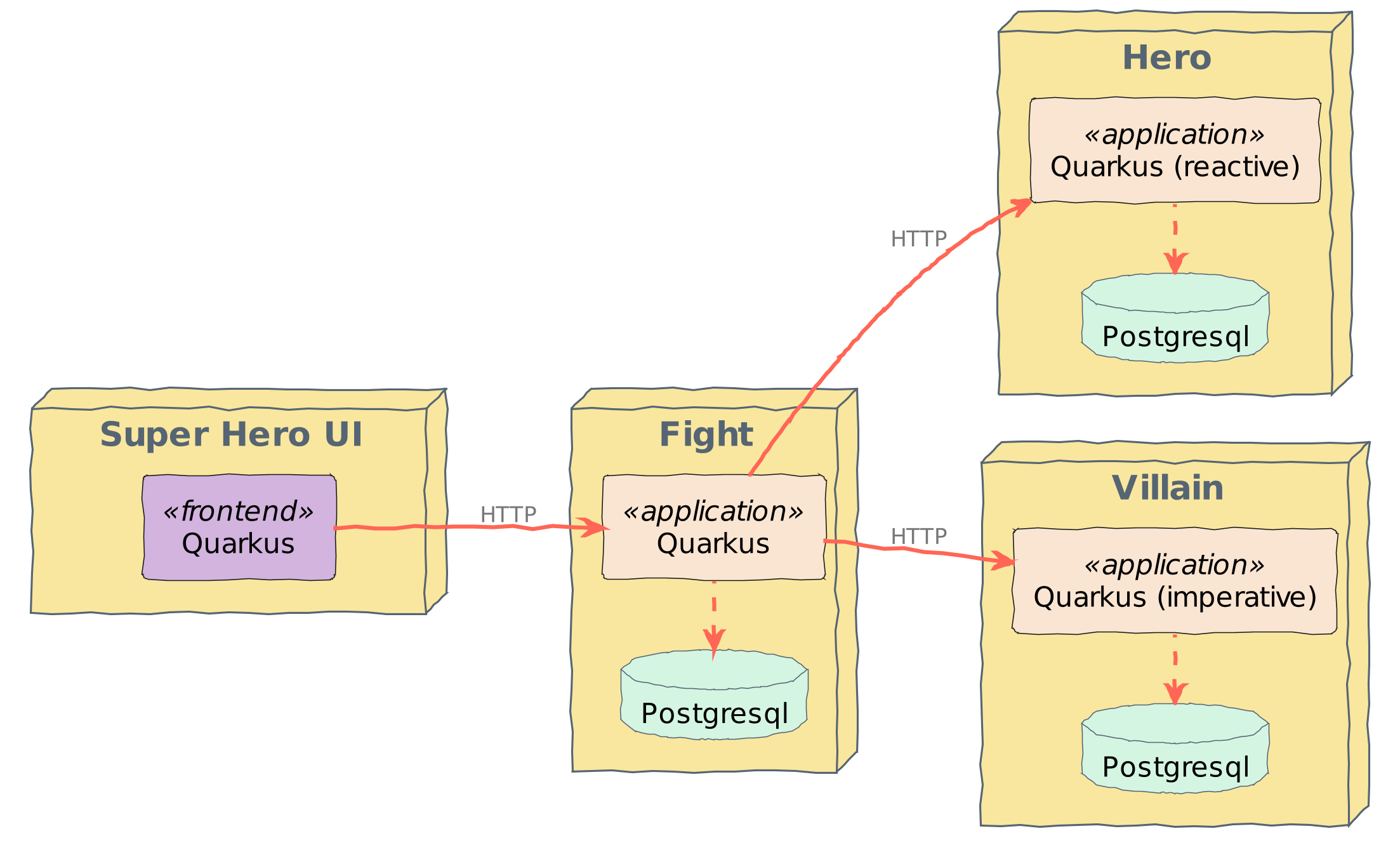
REST Client
This chapter explains how to use the MicroProfile REST Client in order to interact with REST APIs with very little effort.[18]
Directory Structure
Remember the structure of the Fight microservice:
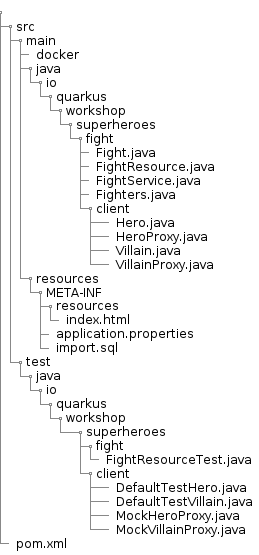
We are going to rework the:
-
FightServiceclass -
FightResourceTestclass -
application.properties
Installing the REST Client Dependency
To install the REST Client dependency, just run the following command in the Fight microservice:
./mvnw quarkus:add-extension -Dextensions="io.quarkus:quarkus-rest-client-jackson"This will add the following dependency in the pom.xml file:
<dependency>
<groupId>io.quarkus</groupId>
<artifactId>quarkus-rest-client-jackson</artifactId>
</dependency>This dependency imports both the REST client implementation and the JSON mapping support (which uses Jackson).
FightService Invoking External Microservices
Remember that in the previous sections we left the FightService.findRandomFighters() method returns null.
We have to fix this.
What we actually want is to invoke both the Hero and Villain APIs, asking for a random hero and a random villain.
For that, replace the findRandomFighters method with the following code to the FightService class:
@RestClient HeroProxy heroProxy;
@RestClient VillainProxy villainProxy;
// ...
Fighters findRandomFighters() {
Hero hero = findRandomHero();
Villain villain = findRandomVillain();
Fighters fighters = new Fighters();
fighters.hero = hero;
fighters.villain = villain;
return fighters;
}
Villain findRandomVillain() {
return villainProxy.findRandomVillain();
}
Hero findRandomHero() {
return heroProxy.findRandomHero();
}Note the Rest client injection.
They use the @RestClient qualifier, i.e. a bean selector.
With Quarkus, when you use a qualifier, you can omit @Inject.
|
If not done automatically by your IDE, add the following import statement: |
Creating the Interfaces
Using the MicroProfile REST Client is as simple as creating an interface using the proper JAX-RS and MicroProfile annotations.
In our case both interfaces should be created under the client subpackage and have the following content:
package io.quarkus.workshop.superheroes.fight.client;
import org.eclipse.microprofile.rest.client.inject.RegisterRestClient;
import jakarta.ws.rs.GET;
import jakarta.ws.rs.Path;
import jakarta.ws.rs.Produces;
import jakarta.ws.rs.core.MediaType;
@Path("/api/heroes")
@Produces(MediaType.APPLICATION_JSON)
@RegisterRestClient(configKey = "hero")
public interface HeroProxy {
@GET
@Path("/random")
Hero findRandomHero();
}The findRandomHero method gives our code the ability to query a random hero from the Hero REST API.
The client will handle all the networking and marshalling leaving our code clean of such technical details.
The purpose of the annotations in the code above is the following:
-
@RegisterRestClientallows Quarkus to know that this interface is meant to be available for CDI injection as a REST Client -
@Pathand@GETare the standard JAX-RS annotations used to define how to access the service -
@Producesdefines the expected content-type
The VillainProxy is very similar and looks like this:
package io.quarkus.workshop.superheroes.fight.client;
import org.eclipse.microprofile.rest.client.inject.RegisterRestClient;
import jakarta.ws.rs.GET;
import jakarta.ws.rs.Path;
import jakarta.ws.rs.Produces;
import jakarta.ws.rs.core.MediaType;
@Path("/api/villains")
@Produces(MediaType.APPLICATION_JSON)
@RegisterRestClient(configKey = "villain")
public interface VillainProxy {
@GET
@Path("/random")
Villain findRandomVillain();
}Once created, go back to the FightService class and add the following import statements:
import io.quarkus.workshop.superheroes.fight.client.HeroProxy;
import io.quarkus.workshop.superheroes.fight.client.VillainProxy;Configuring REST Client Invocation
In order to determine the base URL to which REST calls will be made, the REST Client uses configuration from application.properties.
The name of the property needs to follow a certain convention which is best displayed in the following code:
quarkus.rest-client.hero.url=http://localhost:8083
quarkus.rest-client.villain.url=http://localhost:8084Having this configuration means that all requests performed using HeroProxy will use http://localhost:8083 as the base URL.
Using this configuration, calling the findRandomHero method of HeroProxy would result in an HTTP GET request being made to http://localhost:8083/api/heroes/random.
Now, go back in the UI and refresh, you should see some pictures!
Updating the Test with Mock Support
But, now we have another problem.
To run the tests of the Fight API we need the Hero and Villain REST APIs to be up and running.
To avoid this, we need to Mock the HeroProxy and VillainProxy interfaces.
Quarkus supports the use of mock objects using the CDI @Alternative mechanism.[19]
To use this simply override the bean you wish to mock with a class in the src/test/java directory, and put the @Alternative and @Priority(1) annotations on the bean.
Alternatively, a convenient io.quarkus.test.Mock stereotype annotation could be used.
This built-in stereotype declares @Alternative, @Priority(1) and @Dependent.
Mocking a Villain service
So, to mock the VillainProxy interface we just need to implement the following MockVillainProxy class (under the client subpackage under src/test/java/io/quarkus/workshop/superheroes/fight):
package io.quarkus.workshop.superheroes.fight.client;
import io.quarkus.test.Mock;
import org.eclipse.microprofile.rest.client.inject.RestClient;
import jakarta.enterprise.context.ApplicationScoped;
@Mock
@ApplicationScoped
@RestClient
public class MockVillainProxy implements VillainProxy {
@Override
public Villain findRandomVillain() {
return DefaultTestVillain.INSTANCE;
}
}We are using some common classes for the test data.
They don’t exist yet, so the IDE will complain!
Let your IDE’s quick fix create the classes for you, or create them manually (under the client subpackage under src/test/java/io/quarkus/workshop/superheroes/fight), and then fill in the following contents:
package io.quarkus.workshop.superheroes.fight.client;
public class DefaultTestVillain extends Villain {
public static final String DEFAULT_VILLAIN_NAME = "Super Chocolatine";
public static final String DEFAULT_VILLAIN_PICTURE = "super_chocolatine.png";
public static final String DEFAULT_VILLAIN_POWERS = "does not eat pain au chocolat";
public static final int DEFAULT_VILLAIN_LEVEL = 42;
public static final DefaultTestVillain INSTANCE = new DefaultTestVillain();
private DefaultTestVillain() {
this.name = DEFAULT_VILLAIN_NAME;
this.picture = DEFAULT_VILLAIN_PICTURE;
this.powers = DEFAULT_VILLAIN_POWERS;
this.level = DEFAULT_VILLAIN_LEVEL;
}
}Mocking a Hero service
We could create a @Mock for the HeroProxy, as we did for the Villain, but there are some drawbacks to using @Mock:
-
Any class defined by
@Mockis global in scope, and can’t be isolated to individual tests. That can result in unwanted cross-talk between tests. -
Because of how the mock is defined, it’s also harder to use Mockito to generate the mock instance.
Let’s try a different approach.
We’ll still want a class which holds test data for the hero. Create the following under the client subpackage:
package io.quarkus.workshop.superheroes.fight.client;
public class DefaultTestHero extends Hero {
public static final String DEFAULT_HERO_NAME = "Super Baguette";
public static final String DEFAULT_HERO_PICTURE = "super_baguette.png";
public static final String DEFAULT_HERO_POWERS = "eats baguette really quickly";
public static final int DEFAULT_HERO_LEVEL = 42;
public static final DefaultTestHero INSTANCE = new DefaultTestHero();
private DefaultTestHero() {
this.name = DEFAULT_HERO_NAME;
this.picture = DEFAULT_HERO_PICTURE;
this.powers = DEFAULT_HERO_POWERS;
this.level = DEFAULT_HERO_LEVEL;
}
}Add the extended Quarkus Mockito support to the fight service’s pom.xml:
<dependency>
<groupId>io.quarkus</groupId>
<artifactId>quarkus-junit5-mockito</artifactId>
<scope>test</scope>
</dependency>Now we can add the following to the top of the FightResourceTest:
@InjectMock
@RestClient
HeroProxy heroProxy;
@BeforeEach
public void setup() {
when(heroProxy.findRandomHero()).thenReturn(DefaultTestHero.INSTANCE);
}The when call is a static import of Mockito.when.
The @InjectMock annotation results in a mock being created and made available in test methods of the test class.
Importantly, other test classes are not affected by this.
import io.quarkus.test.InjectMock;
import static org.mockito.Mockito.when;
import org.eclipse.microprofile.rest.client.inject.RestClient;Finally, edit the FightResourceTest and add the following method:
@Test
void shouldGetRandomFighters() {
Fighters fighters = given()
.when()
.get("/api/fights/randomfighters")
.then()
.statusCode(OK.getStatusCode())
.contentType(APPLICATION_JSON)
.extract()
.as(Fighters.class);
Hero hero = fighters.hero;
assertEquals(hero.name, DefaultTestHero.DEFAULT_HERO_NAME);
assertEquals(hero.picture, DefaultTestHero.DEFAULT_HERO_PICTURE);
assertEquals(hero.level, DefaultTestHero.DEFAULT_HERO_LEVEL);
assertEquals(hero.powers, DefaultTestHero.DEFAULT_HERO_POWERS);
Villain villain = fighters.villain;
assertEquals(villain.name, DefaultTestVillain.DEFAULT_VILLAIN_NAME);
assertEquals(villain.picture, DefaultTestVillain.DEFAULT_VILLAIN_PICTURE);
assertEquals(villain.level, DefaultTestVillain.DEFAULT_VILLAIN_LEVEL);
assertEquals(villain.powers, DefaultTestVillain.DEFAULT_VILLAIN_POWERS);
}Now, run the test from the dev mode, or from your IDE. You can shutdown the hero and villain services to verify that the tests still pass.
Time to play.
Start the Hero, Villain and Fight microservices as well as the user interface (using ./mvnw quarkus:dev on each project) and select random fighters.
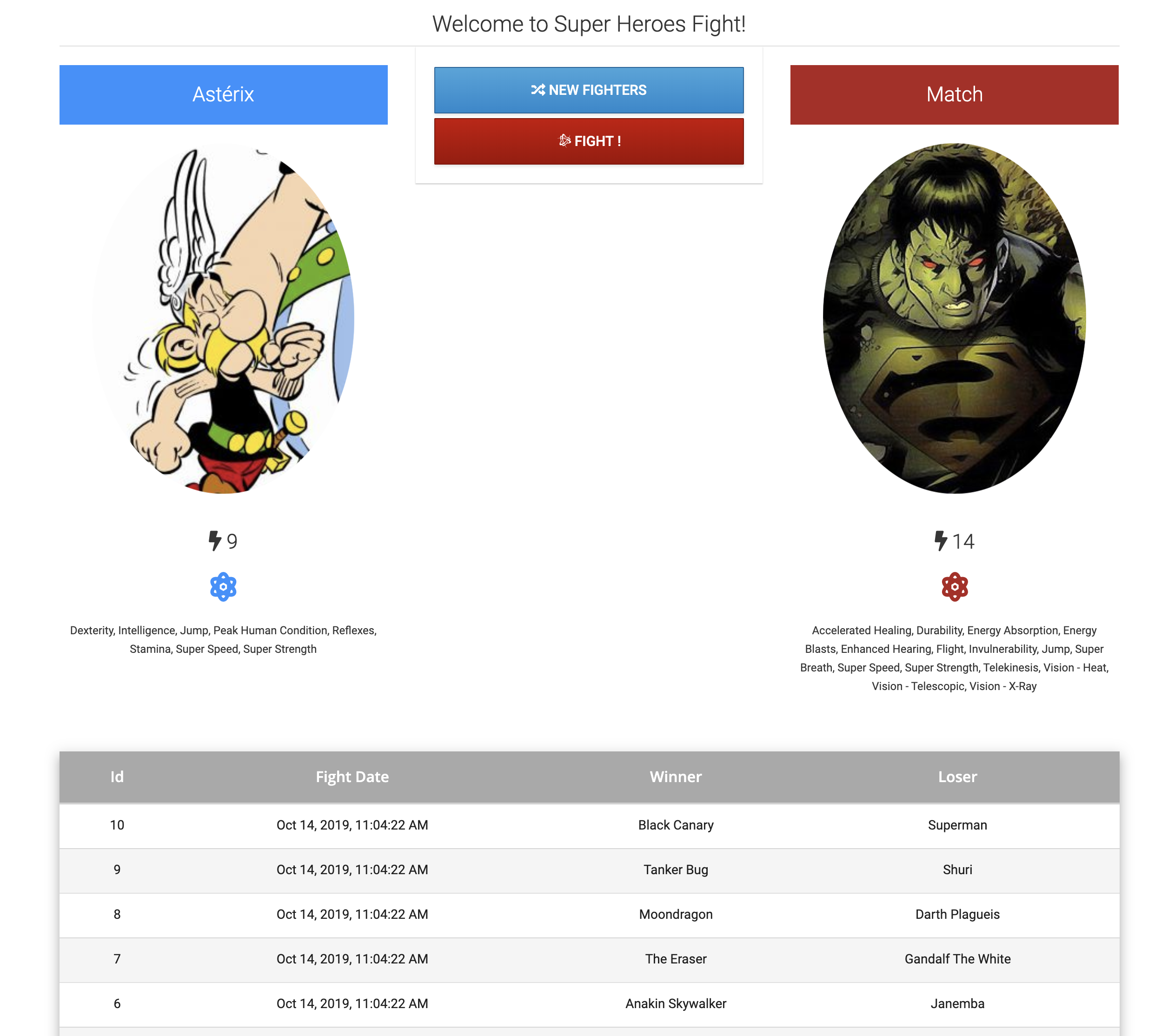
Fallbacks
So now you’ve been playing this great Super Heroes Fight for a few hours… and you kill the Hero REST API. What happens? Well, the Fight REST API cannot invoke the Hero API anymore and breaks with the following exception:
Caused by: io.netty.channel.AbstractChannel$AnnotatedConnectException: Connection refused: localhost/127.0.0.1:8083
Caused by: java.net.ConnectException: Connection refused
at java.base/sun.nio.ch.SocketChannelImpl.checkConnect(Native Method)
at java.base/sun.nio.ch.SocketChannelImpl.finishConnect(SocketChannelImpl.java:777)
at io.netty.channel.socket.nio.NioSocketChannel.doFinishConnect(NioSocketChannel.java:330)
at io.netty.channel.nio.AbstractNioChannel$AbstractNioUnsafe.finishConnect(AbstractNioChannel.java:334)
at io.netty.channel.nio.NioEventLoop.processSelectedKey(NioEventLoop.java:707)
at io.netty.channel.nio.NioEventLoop.processSelectedKeysOptimized(NioEventLoop.java:655)
at io.netty.channel.nio.NioEventLoop.processSelectedKeys(NioEventLoop.java:581)
at io.netty.channel.nio.NioEventLoop.run(NioEventLoop.java:493)
at io.netty.util.concurrent.SingleThreadEventExecutor$4.run(SingleThreadEventExecutor.java:986)
at io.netty.util.internal.ThreadExecutorMap$2.run(ThreadExecutorMap.java:74)
at io.netty.util.concurrent.FastThreadLocalRunnable.run(FastThreadLocalRunnable.java:30)
at java.base/java.lang.Thread.run(Thread.java:829)One of the challenges brought by the distributed nature of microservices is that communication with external systems is inherently unreliable. This increases demand on resiliency of applications. To simplify making more resilient applications, Quarkus contains an implementation of the MicroProfile Fault Tolerance specification.[20]
Installing the Fault Tolerance Dependency
To install the MicroProfile Fault Tolerance dependency, just run the following command in the Fight microservice:
./mvnw quarkus:add-extension -Dextensions="smallrye-fault-tolerance"This will add the following dependency in the pom.xml file:
<dependency>
<groupId>io.quarkus</groupId>
<artifactId>quarkus-smallrye-fault-tolerance</artifactId>
</dependency>Adding Fallbacks
Let’s make our find random fighters feature better by providing a fallback way of getting a dummy hero or villain in case of failure.
For that, add two fallback methods to the FightService and a @Fallback annotation to both findRandomHero and findRandomVillain methods as follows:
@Fallback(fallbackMethod = "fallbackRandomHero")
Hero findRandomHero() {
return heroProxy.findRandomHero();
}
@Fallback(fallbackMethod = "fallbackRandomVillain")
Villain findRandomVillain() {
return villainProxy.findRandomVillain();
}
public Hero fallbackRandomHero() {
logger.warn("Falling back on Hero");
Hero hero = new Hero();
hero.name = "Fallback hero";
hero.picture = "https://dummyimage.com/240x320/1e8fff/ffffff&text=Fallback+Hero";
hero.powers = "Fallback hero powers";
hero.level = 1;
return hero;
}
public Villain fallbackRandomVillain() {
logger.warn("Falling back on Villain");
Villain villain = new Villain();
villain.name = "Fallback villain";
villain.picture = "https://dummyimage.com/240x320/b22222/ffffff&text=Fallback+Villain";
villain.powers = "Fallback villain powers";
villain.level = 42;
return villain;
}|
Also add the |
Running the Application
Now we are ready to run our application and test the fallbacks.
For that, kill the Hero (and/or the Villain API) and start playing again. You should see the following:
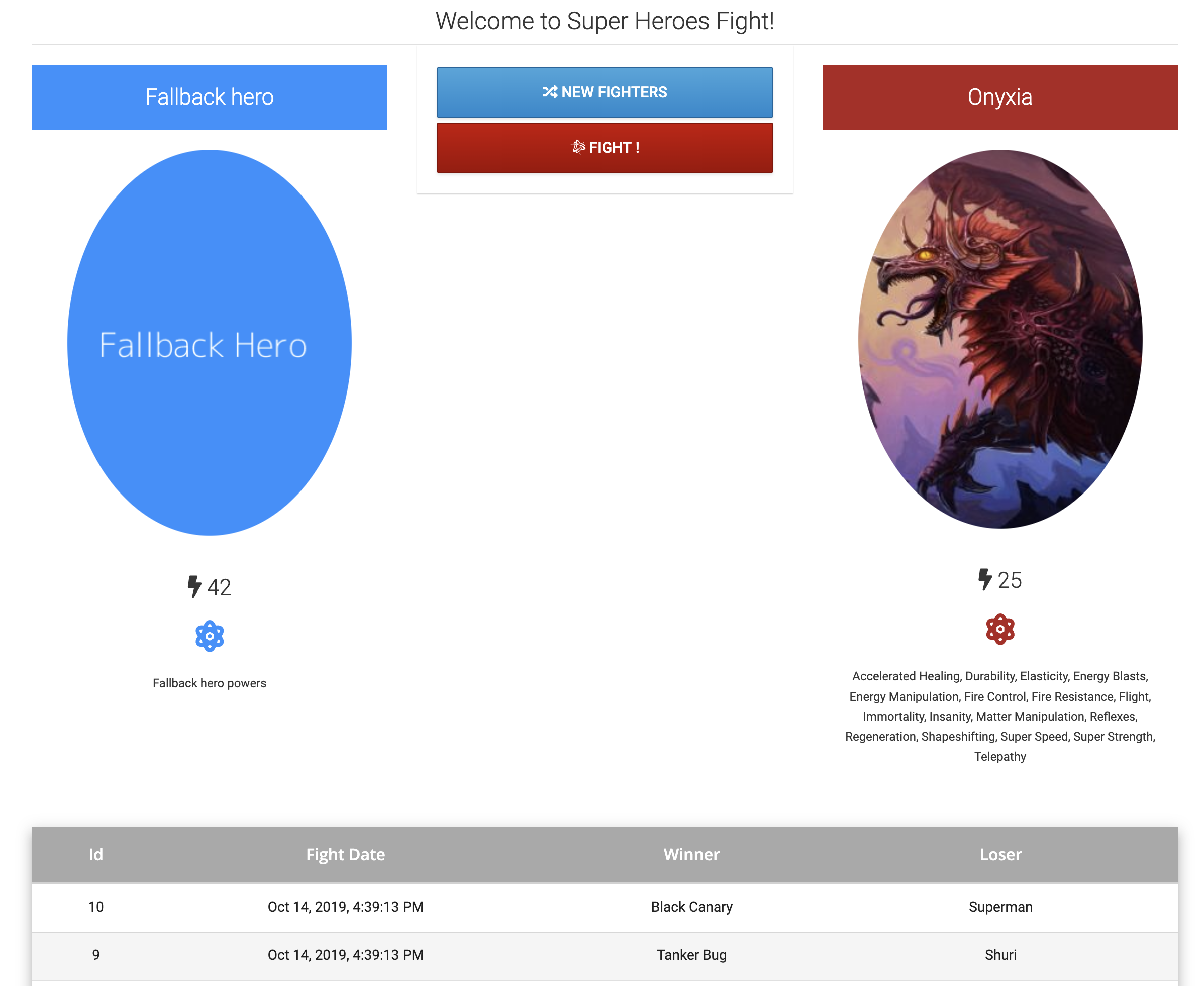
Restart the Hero REST API… and keep on playing. Super-heroes are back to the fight!
Timeout
Sometimes invoking a REST API can take a long time. In fact, the more microservices invoke other microservices, the more network latency you can have. And what happens when a HTTP request takes long? Well, it hangs. On your browser you can see the request pending if you turn on the dev tools and look at what’s the network is doing.

Adding Timeouts
Getting random fighters can take longer than expected.
To simulate a long-running process, add the following code to the FightResource:
@ConfigProperty(name = "process.milliseconds", defaultValue = "0")
long tooManyMilliseconds;
private void veryLongProcess() {
try {
Thread.sleep(tooManyMilliseconds);
} catch (InterruptedException e) {
Thread.currentThread().interrupt();
}
}
@GET
@Path("/randomfighters")
@Timeout(500) // <-- Added
public Response getRandomFighters() {
veryLongProcess(); // <-- Added
Fighters fighters = service.findRandomFighters();
logger.debug("Get random fighters " + fighters);
return Response.ok(fighters).build();
}|
Don’t forget to add the following import: |
Let’s say we’ve added some new functionality in the veryLongProcess method.
When the process is really too long and the system is overloaded, we would rather time out.
Note that the timeout was configured to 500 ms, and a Thread.sleep was introduced and can be configured in the application.properties.
If we set the property to a higher value than the timeout, let’s say 10.000, then the request should be interrupted.
process.milliseconds=10000Running the Application
Now that you have set the number of waiting milliseconds to 10.000, run the application and start fighting again. You should see the following:
18:40:48 ERROR [or.jb.re.re.co.co.AbstractResteasyReactiveContext] (executor-thread-0) Request failed: org.eclipse.microprofile.faulttolerance.exceptions.TimeoutException: Timeout[io.quarkus.workshop.superheroes.fight.FightResource#getRandomFighters] timed out
at io.smallrye.faulttolerance.core.timeout.Timeout.timeoutException(Timeout.java:91)
at io.smallrye.faulttolerance.core.timeout.Timeout.doApply(Timeout.java:78)
at io.smallrye.faulttolerance.core.timeout.Timeout.apply(Timeout.java:30)
...Before going further, set the process.milliseconds to 0.
|
If you have any problem with the code, don’t understand or feel you are running, remember to ask for some help. Also, you can get the code of this entire workshop from https://github.com/quarkusio/quarkus-workshops/tree/refs/heads/main/quarkus-workshop-super-heroes. You can also download the completed code from https://raw.githubusercontent.com/quarkusio/quarkus-workshops/refs/heads/main/quarkus-workshop-super-heroes/dist/quarkus-super-heroes-workshop-complete.zip. |
Contract testing
Let’s look at what we’ve done so far. We have been doing some (some) test-driven development, we have several microservices, and they’re even talking to each other. We have fault tolerance for when services go down.
Clearly, we have an invincible application. Right? Right?
In your IDE, have a look to see how many instances of a class called Hero you have.
There should be two.
This is by design; one for the consumer of the service, and one for the provider.
The two classes are different, with the provider class having a lot more code in it. However, the fields in the two classes should be roughly the same.
What happens if we do some refactoring?
In the rest-heroes project, let’s do some searching and replacing.
(We do search and replace so we catch both Java and SQL in our refactoring.)
Change "level" to "maturity".
Make sure to only do search within the rest-heroes directory.
(Normally this project would be in its own repository, but we’ve grouped everything together into one repository for convenience.)
Check all of your tests. The heroes, villains, and fights tests should all be running clean. A successful refactoring!
Now visit the UI at http://localhost:8080/. What’s going on? The hero’s level is always 0. Why didn’t the tests catch this?
Although we changed the provider of an API, no one told the consumer that the API had changed. The unit tests were (correctly) isolated in scope, so they didn’t catch the cross-service misunderstanding.
Feel free to reverse the change now, rather than patching up the service consumer.
This was a slightly contrived example, but uncaught API changes are a common cause of breaks, especially early in project development, before APIs have been locked down. Tools like OpenAPI validation can catch syntax changes, but they will not catch semantic changes. (What if we’d changed the level to be normalised against the best fighter, or count down from 100?)
This is where contract testing comes in. Contract testing is a lightweight way of validating that a service’s consumer and provider have the same understanding about what the service does.
There are several contract testing tools available. The Red Hat App Development Consulting team have an excellent tutorial describing contract first development and a polyglot OpenAPI-based stack for contract testing.
We will be using an all-in-one tool called Pact, which is also polyglot, and enables consumer-driven contract testing. The Pact team have a good overview of the advantages and disadvantages of schema-based testing (such as validation based on an OpenAPI spec) and consumer-driven contract testing.
Consumer tests
Pact is a consumer-driven contract testing framework, which means that we begin by writing tests for the API consumer.
Writing the first contract test
Add the Pact Quarkus extension to the pom.xml of the Fights service:
<dependency>
<groupId>io.quarkiverse.pact</groupId>
<artifactId>quarkus-pact-consumer</artifactId>
<version>1.3.0</version>
<scope>test</scope>
</dependency>The Pact framework will stand up a server which listens on a port.
To avoid port conflicts between the real services and the Pact stubs, let’s use a different port for the contract instances.
Open the fight service’s application.properties and add the following
%test.quarkus.rest-client.hero.url=http://localhost:8093The %test scopes the updated property to only apply in the test mode.
We will be using the junit 5 pact libraries.
Create a class called FightResourceConsumerTest.java.
package io.quarkus.workshop.superheroes.fight;
import au.com.dius.pact.consumer.dsl.PactDslWithProvider;
import au.com.dius.pact.consumer.junit5.PactConsumerTestExt;
import au.com.dius.pact.consumer.junit5.PactTestFor;
import au.com.dius.pact.core.model.PactSpecVersion;
import au.com.dius.pact.core.model.V4Pact;
import au.com.dius.pact.core.model.annotations.Pact;
import io.quarkus.test.junit.QuarkusTest;
import io.quarkus.workshop.superheroes.fight.client.DefaultTestHero;
import io.quarkus.workshop.superheroes.fight.client.DefaultTestVillain;
import io.quarkus.workshop.superheroes.fight.client.Hero;
import io.quarkus.workshop.superheroes.fight.client.Villain;
import org.junit.jupiter.api.Test;
import org.junit.jupiter.api.extension.ExtendWith;
import jakarta.ws.rs.HttpMethod;
import jakarta.ws.rs.core.HttpHeaders;
import jakarta.ws.rs.core.MediaType;
import jakarta.ws.rs.core.Response;
import jakarta.ws.rs.core.Response.Status;
import java.util.Map;
import static au.com.dius.pact.consumer.dsl.LambdaDsl.newJsonBody;
import static io.restassured.RestAssured.given;
import static jakarta.ws.rs.core.MediaType.APPLICATION_JSON;
import static jakarta.ws.rs.core.Response.Status.OK;
import static org.junit.jupiter.api.Assertions.assertEquals;
@QuarkusTest
@ExtendWith(PactConsumerTestExt.class)
@PactTestFor(
providerName = "rest-heroes",
pactVersion = PactSpecVersion.V4,
hostInterface = "localhost",
// Hard-code the Pact MockServer to what we defined in application.properties
// I don't like it but couldn't figure out any other way without using dynamic config
port = "8093"
)
public class FightResourceConsumerTest {
private static final String HERO_API_BASE_URI = "/api/heroes";
private static final String HERO_RANDOM_URI = HERO_API_BASE_URI + "/random";
@Pact(consumer = "rest-fights")
public V4Pact randomHeroFoundPact(PactDslWithProvider builder) {
return builder
.uponReceiving("A request for a random hero")
.path(HERO_RANDOM_URI)
.method(HttpMethod.GET)
.headers(HttpHeaders.ACCEPT, MediaType.APPLICATION_JSON)
.willRespondWith()
.status(Response.Status.OK.getStatusCode())
.headers(Map.of(HttpHeaders.CONTENT_TYPE, MediaType.APPLICATION_JSON))
.body(newJsonBody(body ->
body
.stringType("name", DefaultTestHero.DEFAULT_HERO_NAME)
.integerType("level", DefaultTestHero.DEFAULT_HERO_LEVEL)
.stringType("picture", DefaultTestHero.DEFAULT_HERO_PICTURE)
).build()
)
.toPact(V4Pact.class);
}
@Test
void randomHeroFound() {
}
}Here we are setting up a test to run with Pact and telling Pact what ports it should stand up the mock server on. We also define how the mock should behave.
Run the build, using ./mvnw verify or ./mvnw quarkus:dev.
You should see a failure. What’s happened? The randomHeroFound test didn’t have any assertions, so how could there be a failure? Pact is doing some validation for us. We have defined a mock, but nothing is exercising it. That might mean our code
doesn’t do what we think it does, so Pact flags it as an error.
Let’s fill in the dummy test method with something more substantial. Replace the randomHeroFound test with the following.
You’ll notice this is very similar to the one in FightResourceTest; you could even copy and paste from that class.
@Test
@PactTestFor(pactMethod = "randomHeroFoundPact")
void randomHeroFound() {
Fighters fighters = given()
.when()
.get("/api/fights/randomfighters")
.then()
.statusCode(OK.getStatusCode())
.contentType(APPLICATION_JSON)
.extract()
.as(Fighters.class);
Hero hero = fighters.hero;
assertEquals(hero.name, DefaultTestHero.DEFAULT_HERO_NAME);
assertEquals(hero.picture, DefaultTestHero.DEFAULT_HERO_PICTURE);
assertEquals(hero.level, DefaultTestHero.DEFAULT_HERO_LEVEL);
// We're really trying to test the fighter, so we want to make sure it still passes back
// a villain
Villain villain = fighters.villain;
assertEquals(villain.name, DefaultTestVillain.DEFAULT_VILLAIN_NAME);
assertEquals(villain.picture, DefaultTestVillain.DEFAULT_VILLAIN_PICTURE);
assertEquals(villain.level, DefaultTestVillain.DEFAULT_VILLAIN_LEVEL);
}Run the tests. They should all pass.
Note that we’re only setting up contracts for heroes here. If we were to make contracts for getting villains, the test would fail. Can you think why that might be?
|
When we use Pact, the Pact framework stands up a server which acts as a mock.
Remember that we defined a global |
The contract
Look in target/pacts.
You should find a json contract, rest-fights-rest-heroes.json.
Inspect it to see how the contents of the @Pact method have been turned into json.
What we want to be testing when we use Pact in our tests is the behaviour of our own code. Here, although we check the value of the hero fields, we’re trying to make sure that the fights service is doing the right thing. Our expectation for the fights service is pretty low: it just has to pass through what it gets from the heroes service.
|
This test is just on the edge of falling into a common Pact anti-pattern, testing the mock. We do not need to do detailed validation of what comes back from the pact server, because it’s a mock that we define. |
A more interesting contract test would exercise some of the more complex fights functionality, while using the mock we’ve defined. Can you write one? (You might also need to define a villain pact.)
If you get stuck, you can look at the consumer contract tests in the source repo for inspiration.
Provider tests
So far, we’ve done good work and set up tests for the fight service, to extend our testing of the fight service, and also encode its expectations for the hero service into a json contract.
The next step is to make sure the Hero service actually produces what the contract says it should!
Sharing the contract
There are a few possibilities for sharing the contract. A self-hosted or managed pact broker can host all of the contracts, as well as providing extra services such as metrics about when tests were run and compatibility dashboards.
Alternatively, some teams check the json contract into the provider’s source control after a successful run. Note that Pact is consumer-driven contract system; the consumer has responsibility for defining the contract, and therefore also has responsibility for sharing it.
The simplest sharing mechanism is copying on a filesystem, so that’s what we’ll do. From the fights service, copy the contract to the heroes service.
mkdir -p ../rest-heroes/src/test/resources
cp -r target/pacts ../rest-heroes/src/test/resourcesWriting the test
The great thing about the provider Pact tests is that the provider doesn’t have to do much. The Pact framework will generate a test for each expectation in the contract and run them, based on just a small amount of boilerplate code:
@TestTemplate
@ExtendWith(PactVerificationInvocationContextProvider.class)
void pactVerificationTestTemplate(PactVerificationContext context) {
context.verifyInteraction();
}(No need to put that snippet anywhere yet, we will see how it fits into a test class in a moment.)
Add the Pact dependency to the heroes service pom.xml:
<dependency>
<groupId>io.quarkiverse.pact</groupId>
<artifactId>quarkus-pact-provider</artifactId>
<version>1.3.0</version>
<scope>test</scope>
</dependency>
<dependency>
<groupId>io.quarkus</groupId>
<artifactId>quarkus-panache-mock</artifactId>
<scope>test</scope>
</dependency>We also add the Panache Mock dependency, which allows us to use Mockito to mock all provided static methods. That will come in handy at various points in the provider testing.
Create a io/quarkus/workshop/superheroes/hero/HeroContractVerificationTest.java class in the rest-heroes project.
It doesn’t need to do much except tell Pact what port the Hero provider is listening on,
and create a JUnit test template, which will be expanded into the full set of tests
needed to verify the contract.
@QuarkusTest
@Provider("rest-heroes")
@PactFolder("pacts")
public class HeroContractVerificationTest {
@ConfigProperty(name = "quarkus.http.test-port")
int quarkusPort;
@BeforeEach
void beforeEach(PactVerificationContext context) {
context.setTarget(new HttpTestTarget("localhost", this.quarkusPort));
}
@TestTemplate
@ExtendWith(PactVerificationInvocationContextProvider.class)
void pactVerificationTestTemplate(PactVerificationContext context) {
context.verifyInteraction();
}
}When you run the tests they should pass.
States
One of the advantages of Pact over simpler contract verification methods, such as OpenAPI syntax-checking, is that a pact can include a range of expected responses, depending on what was passed in, and external state.
This allows for a richer set of checks. For example, it can exercise more interesting logic on the consumer side, and it can act as a proper functional test for the provider.
Let’s exercise some error-handling. What happens if no heroes can be found? In that case, we expect that the heroes server will return a 404. Let’s get that into the contract, and exercise the fight service’s error handling.
Add a new pact.
We use the given() to identify the state.
@Pact(consumer = "rest-fights")
public V4Pact randomHeroNotFoundPact(PactDslWithProvider builder) {
return builder
.given("No random hero found")
.uponReceiving("A request for a random hero")
.path(HERO_RANDOM_URI)
.method(HttpMethod.GET)
.headers(HttpHeaders.ACCEPT, MediaType.APPLICATION_JSON)
.willRespondWith()
.status(Status.NOT_FOUND.getStatusCode())
.toPact(V4Pact.class);
}Then, we can define another test method, which exercises our service, given this unhappy state. If the hero service returns 404, we want to check that the fallback instances we defined earlier are used. We also want to check that things work as normal for the villain part of the response.
@Test
@PactTestFor(pactMethod = "randomHeroNotFoundPact")
void shouldGetRandomFighters() {
Fighters fighters = given()
.when()
.get("/api/fights/randomfighters")
.then()
.statusCode(OK.getStatusCode())
.contentType(APPLICATION_JSON)
.extract()
.as(Fighters.class);
Hero hero = fighters.hero;
assertEquals(hero.name, "Fallback hero");
assertEquals(hero.picture,
"https://dummyimage.com/240x320/1e8fff/ffffff&text=Fallback+Hero");
assertEquals(hero.level, 1);
}Run the tests. They should pass. Then copy them to the hero service, using cp -r target/pacts ../rest-heroes/src/test/resources.
In the hero service, the tests will fail, because we haven’t told Pact how to handle the new state.
We would normally do that with a @State annotation.
However, for boring JUnit classloading reasons, we don’t have access to the CDI context in the @State method,
so we’ll work around it by handling the state in the @BeforeEach.
private static final String NO_HERO_FOUND_STATE = "No random hero found";
@BeforeEach
void beforeEach(PactVerificationContext context) {
context.setTarget(new HttpTestTarget("localhost", this.quarkusPort));
// We have to do this here because the CDI context isn't available
// in the @State method below
var noHeroState = Optional.ofNullable(context.getInteraction()
.getProviderStates())
.orElseGet(List::of)
.stream()
.filter(
state -> NO_HERO_FOUND_STATE.equals(state.getName()))
.count() > 0;
if (noHeroState) {
PanacheMock.mock(Hero.class);
Mockito.when(Hero.findRandom()).thenReturn(Uni.createFrom()
.nullItem());
}
}
@State(NO_HERO_FOUND_STATE)
public void clearData() throws NoSuchMethodException, InvocationTargetException,
IllegalAccessException {
// Already handled in beforeEach
// See https://github.com/quarkusio/quarkus/issues/22611
}What’s going on?
The consumer expects a 404 if there are no heroes, but the provider is returning a 204.
The reasoning from the consumer is that if a caller asks for a resource the server doesn’t have, it should be a 404, the same way if a user types in an invalid URL into the browser.
This is a more pure interpretation of REST than what was implemented by the HeroResource.
There are arguments for both 404 (not found) and 204 (no content).
Feel free to debate with your neighbour about which you prefer – but it doesn’t really matter which is correct.
What matters is that the provider and consumer had different preferences.
If the provider returns 204 rather than 404, the fallback logic on the provider (as implemented) is not triggered.
(You can try this out for yourself by changing the contract in the FightResourceConsumerTest.)
At this point, the consumer and provider need to have a conversation to decide whether the expectations or implementation should be updated.
To make the fallback logic simplest, we will update the provider.
Edit the HeroResource and update the getRandomHero method to explicitly handle the null case.
@Operation(summary = "Returns a random hero")
@GET
@Path("/random")
@APIResponse(responseCode = "200", content = @Content(mediaType = APPLICATION_JSON, schema = @Schema(implementation = Hero.class, required = true)))
public Uni<RestResponse<Hero>> getRandomHero() {
return Hero.findRandom()
.onItem().ifNotNull().transform(h -> {
this.logger.debugf("Found random hero: %s", h);
return RestResponse.ok(h);
})
.onItem().ifNull().continueWith(() -> {
this.logger.debug("No random villain found");
return RestResponse.notFound();
});
}The tests should now pass.
Artificial Intelligence
On one side we have superheroes, and on the other side we have super villains. What happens when they fight? Let’s ask an AI to narrate the fight!
In this section we will introduce a new microservice that will use AI to narrate the fight between a superhero and a super villain. It will use the Semantic Kernel API to generate the text invoking OpenAI or Azure OpenAI (you choose).
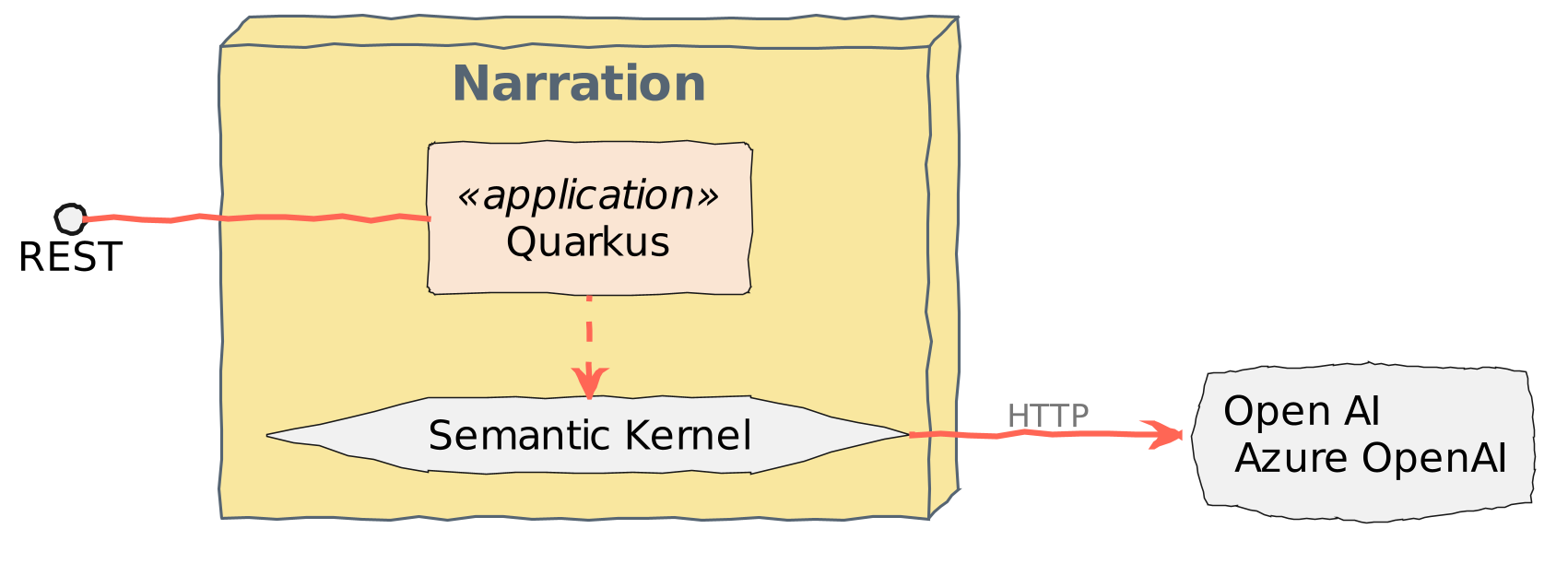
In the following sections, you will learn:
-
What is Semantic Kernel?
-
How to invoke OpenAI or Azure OpenAI GPT model using Semantic Kernel
-
How to create an OpenAI Plugin (a.k.a Skill) to narrate a fight
| This service is exposed on the port 8086. |
What’s Semantic Kernel?
Semantic Kernel is an open-source SDK that lets you easily combine AI services like OpenAI, Azure OpenAI, and Hugging Face with conventional programming languages like C#, Python or Java. By doing so, you can create AI apps that combine the best of both worlds: the deterministic nature of conventional programming and the semantic aspect of AI.
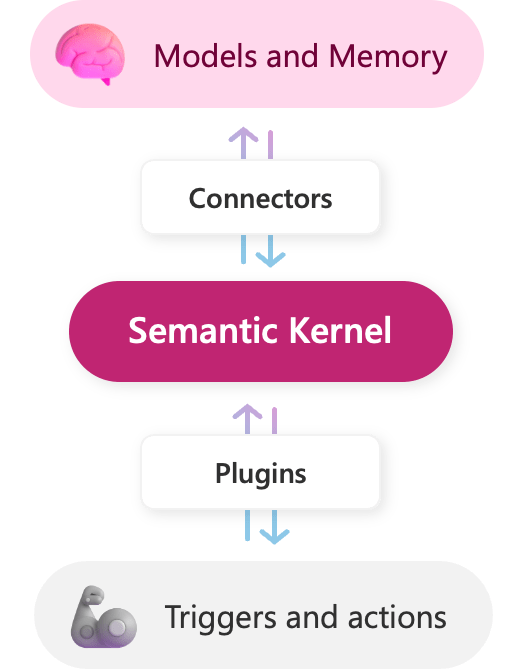
Semantic Kernel has been engineered to allow developers to flexibly integrate AI services into their existing apps. To do so, Semantic Kernel provides a set of connectors that make it easy to add memories and models. In this way, Semantic Kernel is able to add a simulated "brain" to your app.
Additionally, Semantic Kernel makes it easy to add skills to your applications with AI plugins that allow you to interact with the real world. These plugins are composed of prompts and native functions that can respond to triggers and perform actions. In this way, plugins are like the "body" of your AI app.
Narration Microservice
Let’s create a new microservice that will use Semantic Kernel to narrate the fight between a superhero and a super villain. New microservice, new project!
As before, the easiest way to create this new Quarkus project is to use the Quarkus Maven plugin (you can also go to https://code.quarkus.io if you prefer).
Open a terminal and run the following command under the quarkus-workshop-super-heroes/super-heroes directory:
./mvnw io.quarkus:quarkus-maven-plugin:3.27.0:create \
-DplatformVersion=3.27.0 \
-DprojectGroupId=io.quarkus.workshop.super-heroes \
-DprojectArtifactId=rest-narration \
-DclassName="io.quarkus.workshop.superheroes.narration.NarrationResource" \
-Dpath="api/narration" \
-Dextensions="rest-jackson,quarkus-smallrye-openapi,quarkus-smallrye-fault-tolerance"This microservice needs less dependencies than the previous ones:
-
rest-jacksonprovides Quarkus REST and the ability to map JSON objects, -
quarkus-smallrye-openapiprovides the OpenAPI descriptor support and the Swagger UI in the dev console, -
quarkus-smallrye-fault-toleranceprovides the MicroProfile Fault Tolerance dependency so we can fallback in case OpenAI/Azure OpenAI does not respond.
If you want your IDE to manage this new Maven project, you can declare it in the parent POM by adding this new module in the <modules> section:
<module>super-heroes/rest-narration</module>Directory Structure
At the end of this chapter, you will end up with the following directory structure (notice the NarrationSkill directory under src/main/resources):
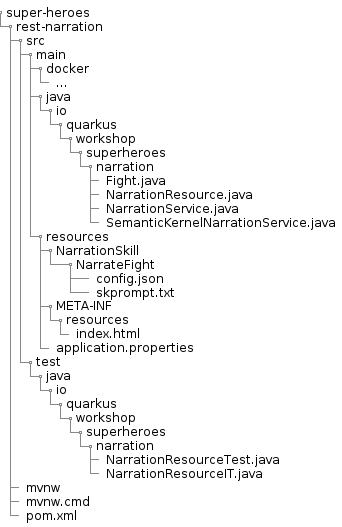
Add the Semantic Kernel dependencies
Once the project is created, you need to add the Semantic Kernel dependencies.
Semantic Kernel is available on Maven Central.
It has a BOM (Bill of Materials) that you can import in your project and then add the dependencies you need.
Add the following XML in the rest-narration/pom.xml file:
<properties>
<!-- ... -->
<semantic-kernel.version>0.2.11-alpha</semantic-kernel.version>
</properties>
<dependencyManagement>
<dependencies>
<!-- ... -->
<dependency>
<groupId>com.microsoft.semantic-kernel</groupId>
<artifactId>semantickernel-bom</artifactId>
<version>${semantic-kernel.version}</version>
<type>pom</type>
<scope>import</scope>
</dependency>
</dependencies>
</dependencyManagement>
<dependencies>
<!-- ... -->
<dependency>
<groupId>com.microsoft.semantic-kernel</groupId>
<artifactId>semantickernel-core</artifactId>
</dependency>
<dependency>
<groupId>com.microsoft.semantic-kernel</groupId>
<artifactId>semantickernel-settings-loader</artifactId>
</dependency>
<dependency>
<groupId>com.microsoft.semantic-kernel</groupId>
<artifactId>semantickernel-connectors-ai-openai</artifactId>
</dependency>
</dependencies>The Fight bean
Let’s start with the Fight class.
The fight is what is going to be narrated by the microservice and ultimately sent by the Fight microservice.
Create the io.quarkus.workshop.superheroes.narration.Fight class in the created project with the following content:
package io.quarkus.workshop.superheroes.narration;
import org.eclipse.microprofile.openapi.annotations.media.Schema;
@Schema(description = "The fight that is narrated")
public class Fight {
public String winnerName;
public int winnerLevel;
public String winnerPowers;
public String loserName;
public int loserLevel;
public String loserPowers;
public String winnerTeam;
public String loserTeam;
}The Narration REST Resource
The NarrationResource only has one HTTP POST method to create a new narration.
Given a fight, it will invoke the NarrationService to return a fight narration.
Open the generated io.quarkus.workshop.superheroes.narration.NarrationResource and update the content to be:
package io.quarkus.workshop.superheroes.narration;
import jakarta.inject.Inject;
import jakarta.ws.rs.*;
import jakarta.ws.rs.core.MediaType;
import jakarta.ws.rs.core.Response;
import org.eclipse.microprofile.openapi.annotations.tags.Tag;
/**
* JAX-RS API endpoints with <code>/api/narration</code> as the base URI for all endpoints
*/
@Path("/api/narration")
@Produces(MediaType.TEXT_PLAIN)
@Consumes(MediaType.APPLICATION_JSON)
@Tag(name = "narration")
public class NarrationResource {
@Inject
NarrationService service;
@POST
public Response narrate(Fight fight) throws Exception {
String narration = service.narrate(fight);
return Response.status(Response.Status.CREATED).entity(narration).build();
}
@GET
@Path("/hello")
public String hello() {
return "Hello Narration Resource";
}
}The Semantic Kernel Narration service
Now it’s time to implement the NarrationService that will use the Semantic Kernel to generate the narration.
First of all, let’s create an interface that will be implemented by the SemanticKernelNarrationService but could also be implemented by other AI frameworks:
Create the io.quarkus.workshop.superheroes.narration.NarrationService interface in the created project with the following content:
Open the NarrationResource and update the content to be:
package io.quarkus.workshop.superheroes.narration;
public interface NarrationService {
String narrate(Fight fight) throws Exception;
}Then, create the io.quarkus.workshop.superheroes.narration.SemanticKernelNarrationService that implements the NarrationService interface.
This class has the following methods:
-
narrate: the main method that will use the Semantic Kernel to generate the narration -
fallbackNarrate: the fallback method that will be invoked if thenarratemethod fails (due to a timeout for example) -
getClient: a method that returns the Semantic Kernel client configured by theconf.propertiesfile
package io.quarkus.workshop.superheroes.narration;
import com.azure.ai.openai.OpenAIAsyncClient;
import com.microsoft.semantickernel.Kernel;
import com.microsoft.semantickernel.SKBuilders;
import com.microsoft.semantickernel.connectors.ai.openai.util.OpenAIClientProvider;
import com.microsoft.semantickernel.exceptions.ConfigurationException;
import com.microsoft.semantickernel.orchestration.SKContext;
import com.microsoft.semantickernel.skilldefinition.ReadOnlyFunctionCollection;
import com.microsoft.semantickernel.textcompletion.CompletionSKFunction;
import com.microsoft.semantickernel.textcompletion.TextCompletion;
import jakarta.enterprise.context.ApplicationScoped;
import jakarta.inject.Inject;
import org.eclipse.microprofile.faulttolerance.Fallback;
import org.eclipse.microprofile.faulttolerance.Timeout;
import org.jboss.logging.Logger;
import reactor.core.publisher.Mono;
import java.io.IOException;
import java.io.InputStream;
import java.util.Map;
import java.util.Properties;
@ApplicationScoped
public class SemanticKernelNarrationService implements NarrationService {
@Inject
Logger logger;
@Override
@Fallback(fallbackMethod = "fallbackNarrate")
@Timeout(30_000)
public String narrate(Fight fight) throws Exception {
// Creates an Azure OpenAI client
OpenAIAsyncClient client = getClient();
// Creates an instance of the TextCompletion service
TextCompletion textCompletion = SKBuilders.chatCompletion().withOpenAIClient(client).withModelId("gpt35turbo").build();
// Instantiates the Kernel
Kernel kernel = SKBuilders.kernel().withDefaultAIService(textCompletion).build();
// Registers skills
ReadOnlyFunctionCollection skill = kernel.importSkillFromResources("", "NarrationSkill", "NarrateFight");
CompletionSKFunction fightFunction = skill.getFunction("NarrateFight", CompletionSKFunction.class);
// Ask to narrate a fight
SKContext fightContext = SKBuilders.context().build();
fightContext.setVariable("winner_team", fight.winnerTeam);
fightContext.setVariable("winner_name", fight.winnerName);
fightContext.setVariable("winner_powers", fight.winnerPowers);
fightContext.setVariable("winner_level", String.valueOf(fight.winnerLevel));
fightContext.setVariable("loser_team", fight.loserTeam);
fightContext.setVariable("loser_name", fight.loserName);
fightContext.setVariable("loser_powers", fight.loserPowers);
fightContext.setVariable("loser_level", String.valueOf(fight.loserLevel));
Mono<SKContext> result = fightFunction.invokeAsync(fightContext);
String narration = result.block().getResult();
logger.info("The narration for the fight is: " + narration);
return narration;
}
public String fallbackNarrate(Fight fight) {
logger.warn("Falling back on Narration");
return """
High above a bustling city, a symbol of hope and justice soared through the sky, while chaos reigned below, with malevolent laughter echoing through the streets.
With unwavering determination, the figure swiftly descended, effortlessly evading explosive attacks, closing the gap, and delivering a decisive blow that silenced the wicked laughter.
In the end, the battle concluded with a clear victory for the forces of good, as their commitment to peace triumphed over the chaos and villainy that had threatened the city.
The people knew that their protector had once again ensured their safety.
""";
}
private OpenAIAsyncClient getClient() throws ConfigurationException {
String propertiesFile = "conf.properties";
try (InputStream is = this.getClass().getClassLoader().getResourceAsStream(propertiesFile)) {
Properties properties = new Properties();
properties.load(is);
OpenAIClientProvider provider = new OpenAIClientProvider((Map) properties, null);
return provider.getAsyncClient();
} catch (IOException e) {
throw new RuntimeException(e);
}
}
}The Narration skill
With skills, you can encapsulate AI capabilities into a single unit of functionality.
Semantic Kernel skills implement the OpenAI Plugin specification also known as "skills".
To narrate a fight, we need to create a NarrateFight function.
For that, you need to create a set of directories unders rest-narration/src/main/resources/NarrationSkill/NarrateFight.
Under the NarrationSkill/NarrateFight directory, create the following files:
-
skprompt.txt: the prompt that will be sent to OpenAI/Azure OpenAI -
config.json: the configuration of the skill
Under src/main/resources/NarrationSkill/NarrateFight/, create the skprompt.txt file with the following content.
Notice that the prompt uses expression language to get the fight data (e.g., {{$winner_name}}).
ACT LIKE YOU WERE A MARVEL COMICS WRITTER, EXPERT IN ALL SORTS OF SUPER HEROES AND SUPER VILLAINS.
NARRATE THE FIGHT BETWEEN A SUPER HERO AND A SUPER VILLAIN.
DURING THE NARRATION DON'T REPEAT "super hero" OR "super villain" WE KNOW WHO IS WHO.
WRITE 4 PARAGRAPHS MAXIMUM.
THE NARRATION MUST BE:
- G RATED
- WORKPLACE/FAMILY SAFE
NO SEXISM, RACISM OR OTHER BIAS/BIGOTRY
BE CREATIVE.
HERE IS THE DATA YOU WILL USE FOR THE WINNER:
+++++
name: {{$winner_name}}
powers: {{$winner_powers}}
level: {{$winner_level}}
+++++
HERE IS THE DATA YOU WILL USE FOR THE LOSER:
+++++
name: {{$loser_name}}
powers: {{$loser_powers}}
level: {{$loser_level}}
+++++
HERE IS THE DATA YOU WILL USE FOR THE FIGHT:
+++++
{{$winner_name}} WHO IS A {{$winner_team}} HAS WON THE FIGHT AGAINST {{$loser_name}} WHO IS A {{$loser_team}}.
+++++Under src/main/resources/NarrationSkill/NarrateFight/, create the config.json file with the following content:
{
"schema": 1,
"description": "Narrates the fight between a Super Hero and a Super Villain using a single prompt",
"type": "completion",
"completion": {
"max_tokens": 1000,
"temperature": 0.9,
"top_p": 0.0,
"presence_penalty": 0.0,
"frequency_penalty": 0.0
},
"input": {
"parameters": [
{
"name": "winner_name",
"description": "The name of the winner",
"defaultValue": "Darth Vader"
},
{
"name": "winner_powers",
"description": "The comma separated list of powers of the winner",
"defaultValue": "Accelerated Healing, Agility, Astral Projection, Cloaking, Danger Sense, Durability, Electrokinesis, Energy Blasts, Enhanced Hearing, Enhanced Senses, Force Fields, Hypnokinesis, Illusions, Intelligence, Jump, Light Control, Marksmanship, Precognition, Psionic Powers, Reflexes, Stealth, Super Speed, Telekinesis, Telepathy, The Force, Weapons Master"
},
{
"name": "winner_level",
"description": "A number representing the level of the winner",
"defaultValue": "13"
},
{
"name": "loser_name",
"description": "The name of the loser",
"defaultValue": "Chewbacca"
},
{
"name": "loser_powers",
"description": "The comma separated list of powers of the loser",
"defaultValue": "Agility, Longevity, Marksmanship, Natural Weapons, Stealth, Super Strength, Weapons Master"
},
{
"name": "loser_level",
"description": "A number representing the level of the loser",
"defaultValue": "5"
},
{
"name": "winner_team",
"description": "The team winning. Can be either 'heroes' or 'villains'",
"defaultValue": "villains"
},
{
"name": "loser_team",
"description": "The team winning. Can be either 'heroes' or 'villains'",
"defaultValue": "heroes"
}
]
}
}Configuring OpenAI/Azure OpenAI access
Configuring the OpenAI/Azure OpenAI access is made thanks to the conf.properties.
Depending if you have previously chosen OpenAI or Azure OpenAI, you either need to use the client.openai or client.azureopenai configuration keys.
|
Make sure that you have previously either created an Azure AI or OpenAI subscription. If not, go back to OpenAI or Azure OpenAI Subscriptions. |
If you use OpenAI, create the rest-narration/src/main/resources/conf.properties file and add the following configuration:
client.openai.key=
client.openai.organizationid=For Azure OpenAI, use the following configuration in the rest-narration/src/main/resources/conf.properties file:
client.azureopenai.key=
client.azureopenai.endpoint=
client.azureopenai.deploymentname=We also set the port of the Narration microservice to be 8086.
And to have a better view of what’s happening behind the scene with Semantic Kernel, we can increase the log level.
Just add the following configuration to the Quarkus application.properties file:
## HTTP configuration
quarkus.http.port=8086
## Custom banner file path
quarkus.banner.path=banner.txt
## CORS
quarkus.http.cors.enabled=true
quarkus.http.cors.origins=*
## Logging configuration
quarkus.log.category."com.microsoft.semantickernel".level=DEBUGTesting the Narration Microservice
Time for some tests! But before creating the test class, we need to add the Mockito dependency to the project. That’s because we want to mock the Semantic Kernel client.
<dependency>
<groupId>io.quarkus</groupId>
<artifactId>quarkus-junit5-mockito</artifactId>
<scope>test</scope>
</dependency>Open the io.quarkus.workshop.superheroes.narration.NarrationResourceTest class and copy the following content:
package io.quarkus.workshop.superheroes.narration;
import io.quarkus.test.InjectMock;
import io.quarkus.test.junit.QuarkusTest;
import org.junit.jupiter.api.BeforeEach;
import org.junit.jupiter.api.Test;
import org.mockito.Mockito;
import static io.restassured.RestAssured.given;
import static jakarta.ws.rs.core.HttpHeaders.ACCEPT;
import static jakarta.ws.rs.core.HttpHeaders.CONTENT_TYPE;
import static jakarta.ws.rs.core.MediaType.APPLICATION_JSON;
import static jakarta.ws.rs.core.MediaType.TEXT_PLAIN;
import static jakarta.ws.rs.core.Response.Status.CREATED;
import static jakarta.ws.rs.core.Response.Status.OK;
import static org.hamcrest.CoreMatchers.is;
@QuarkusTest
public class NarrationResourceTest {
private static final String HERO_NAME = "Super Baguette";
private static final int HERO_LEVEL = 42;
private static final String HERO_POWERS = "Eats baguette in less than a second";
private static final String VILLAIN_NAME = "Super Chocolatine";
private static final int VILLAIN_LEVEL = 43;
private static final String VILLAIN_POWERS = "Transforms chocolatine into pain au chocolat";
@InjectMock
NarrationService narrationService;
private static Fight getFight() {
Fight fight = new Fight();
fight.winnerName = VILLAIN_NAME;
fight.winnerLevel = VILLAIN_LEVEL;
fight.winnerPowers = VILLAIN_POWERS;
fight.loserName = HERO_NAME;
fight.loserLevel = HERO_LEVEL;
fight.loserPowers = HERO_POWERS;
fight.winnerTeam = "villains";
fight.loserTeam = "heroes";
return fight;
}
@BeforeEach
public void setup() throws Exception {
Mockito.when(narrationService.narrate(getFight())).thenReturn("Lorem ipsum dolor sit amet");
}
@Test
void shouldPingOpenAPI() {
given()
.header(ACCEPT, APPLICATION_JSON)
.when().get("/q/openapi")
.then()
.statusCode(OK.getStatusCode());
}
@Test
public void testHelloEndpoint() {
given()
.when().get("/api/narration/hello")
.then()
.statusCode(200)
.body(is("Hello Narration Resource"));
}
@Test
void shouldNarrateAFight() {
given().log().all()
.body(getFight())
.header(CONTENT_TYPE, APPLICATION_JSON)
.header(ACCEPT, TEXT_PLAIN)
.when()
.post("/api/narration")
.then()
.statusCode(CREATED.getStatusCode());
// .body(startsWith("Lorem ipsum dolor sit amet"));
}
}Make sure the tests pass by executing the command ./mvnw test (or from your IDE).
Running the Narration Microservice
Now that the tests are green, we are ready to run our Narration microservice.
Use ./mvnw quarkus:dev to start it.
Once the Narration microservice is started, create a new narration with the following cUrl command:
curl -X POST -d '{"winnerName":"Super winner", "winnerLevel":42, "winnerPowers":"jumping", "loserName":"Super loser", "loserLevel":2, "loserPowers":"leaping", "winnerTeam":"heroes", "loserTeam":"villains" }' -H "Content-Type: application/json" http://localhost:8086/api/narration -vYou should get something similar to the following response:
< HTTP/1.1 201 Created
< Content-Type: text/plain;charset=UTF-8
The battle between the towering Chewbacca and the dark and menacing Darth Vader was one for the ages. Chewbacca's incredible strength and agility were no match for Vader's mastery of the Force and his arsenal of weapons. The two clashed in a flurry of blows and energy blasts, each trying to gain the upper hand.
Despite Chewbacca's valiant efforts, it was clear that Vader was the superior fighter. His precognition and danger sense allowed him to anticipate every move Chewbacca made, and his energy blasts and electrokinesis were devastating. In the end, Vader emerged victorious, leaving Chewbacca battered and defeated.The cUrl command returns the narration of the fight as text/plain.
Remember that you can also check Swagger UI by going to the dev console: http://localhost:8086/q/dev.
Invoking the Narration Microservice from the Fight Microservice
Now that we have a narration microservice up and running, we can invoke it from the fight microservice.
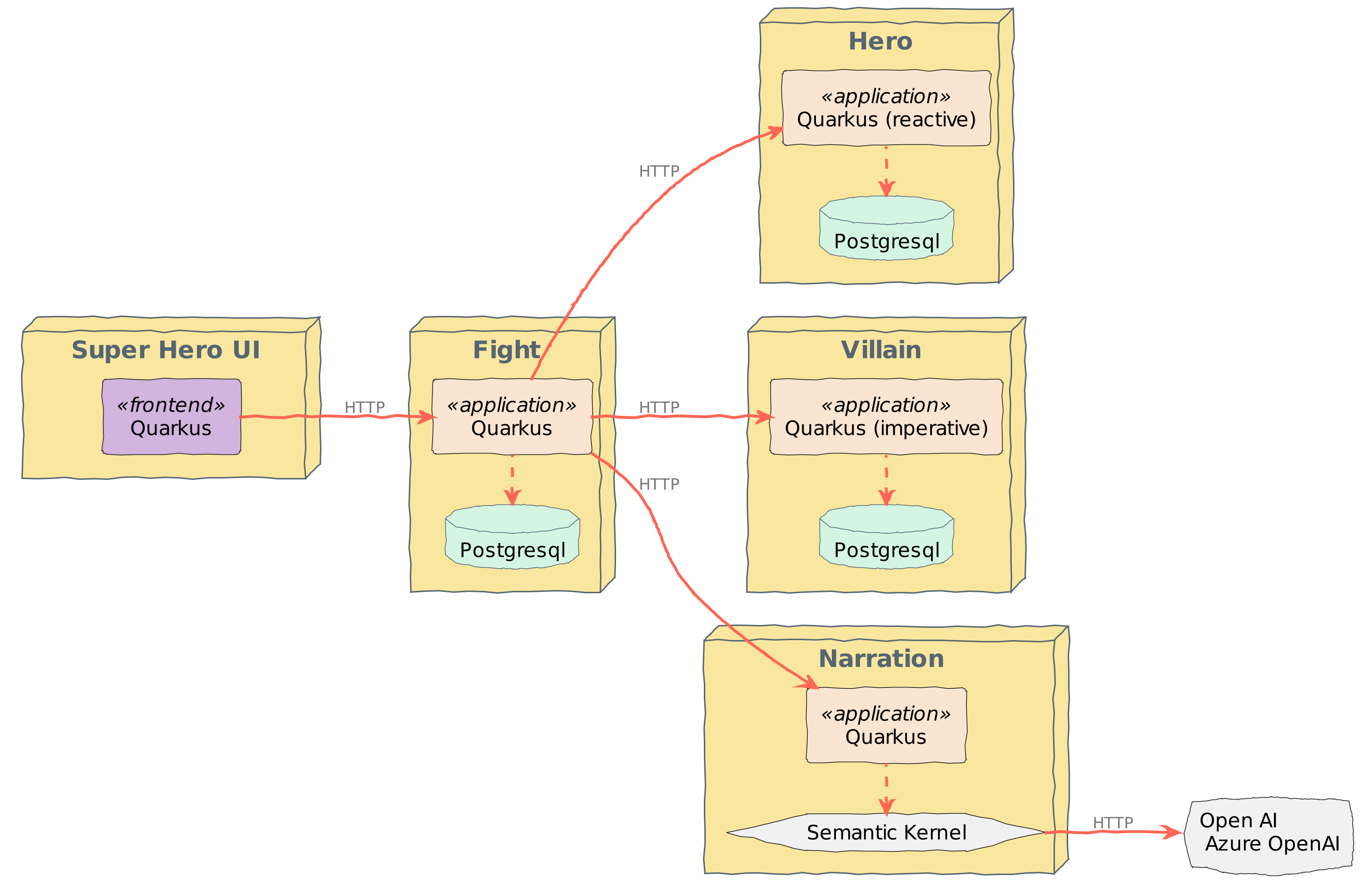
Adding narration to the Fight Microservice
We now need to add a new endpoint to the Fight microservice to invoke the Narration microservice.
Because it uses a remote call, we need to use the @RegisterRestClient annotation to register the NarrationProxy as a REST client.
Go back to the io.quarkus.workshop.superheroes.fight.FightResource class and add the new narrateFight method:
@POST
@Path("/narrate")
@Consumes(APPLICATION_JSON)
@Produces(TEXT_PLAIN)
public Response narrateFight(@Valid Fight fight) {
logger.debug("Narrate the fight " + fight);
String narration = service.narrateFight(fight);
return Response.status(Response.Status.CREATED).entity(narration).build();
}The FightResource invokes a new method of the FightService.
Add the following method to the io.quarkus.workshop.superheroes.fight.FightService class and make sure to inject the NarrationProxy:
@RestClient
NarrationProxy narrationProxy;
public String narrateFight(Fight fight) {
return narrationProxy.narrate(fight);
}Under the client package, where all the other proxies are already located, create a new NarrationProxy class:
package io.quarkus.workshop.superheroes.fight.client;
import io.quarkus.workshop.superheroes.fight.Fight;
import jakarta.ws.rs.Consumes;
import jakarta.ws.rs.POST;
import jakarta.ws.rs.Path;
import jakarta.ws.rs.Produces;
import jakarta.ws.rs.core.MediaType;
import org.eclipse.microprofile.rest.client.inject.RegisterRestClient;
@Path("/api/narration")
@Produces(MediaType.TEXT_PLAIN)
@Consumes(MediaType.APPLICATION_JSON)
@RegisterRestClient(configKey = "narration")
public interface NarrationProxy {
@POST
String narrate(Fight fight);
}To link both microservices, we need to add the following configuration to the rest-fights/src/main/resources/application.properties file of the fight microservice:
quarkus.rest-client.narration.url=http://localhost:8086Test and mock the Narration microservice invocation
Like the other dependencies, the Narration microservice needs to be mocked so we can test the Fight microservice in isolation.
Add the following shouldNarrate test to the io.quarkus.workshop.superheroes.fight.FightResourceTest class.
And make sure you use the right imports:
import java.time.Instant;
import static jakarta.ws.rs.core.MediaType.TEXT_PLAIN;@Test
void shouldNarrate() {
Fight fight = new Fight();
fight.fightDate = Instant.now();
fight.winnerName = DEFAULT_WINNER_NAME;
fight.winnerLevel = DEFAULT_WINNER_LEVEL;
fight.winnerPowers = DEFAULT_WINNER_POWERS;
fight.winnerPicture = DEFAULT_WINNER_PICTURE;
fight.loserName = DEFAULT_LOSER_NAME;
fight.loserLevel = DEFAULT_LOSER_LEVEL;
fight.loserPowers = DEFAULT_LOSER_POWERS;
fight.loserPicture = DEFAULT_LOSER_PICTURE;
fight.winnerTeam = "villains";
fight.loserTeam = "heroes";
given().body(fight)
.header(CONTENT_TYPE, APPLICATION_JSON)
.header(ACCEPT, TEXT_PLAIN)
.when()
.post("/api/fights/narrate")
.then()
.statusCode(CREATED.getStatusCode())
.body(startsWith("Lorem ipsum dolor sit amet"));
}Create the io.quarkus.workshop.superheroes.fight.client.MockNarrationProxy class and add the new narrateFight method:
package io.quarkus.workshop.superheroes.fight.client;
import io.quarkus.test.Mock;
import io.quarkus.workshop.superheroes.fight.Fight;
import jakarta.enterprise.context.ApplicationScoped;
import org.eclipse.microprofile.rest.client.inject.RestClient;
@Mock
@ApplicationScoped
@RestClient
public class MockNarrationProxy implements NarrationProxy {
@Override
public String narrate(Fight fight) {
return """
Lorem ipsum dolor sit amet, consectetur adipiscing elit, sed do eiusmod tempor incididunt ut labore et dolore magna aliqua.
Ut enim ad minim veniam, quis nostrud exercitation ullamco laboris nisi ut aliquip ex ea commodo consequat.
Duis aute irure dolor in reprehenderit in voluptate velit esse cillum dolore eu fugiat nulla pariatur.
Excepteur sint occaecat cupidatat non proident, sunt in culpa qui officia deserunt mollit anim id est laborum.
""";
}
}Now execute ./mvnw test and make sure that all the tests pass.
Running, Testing and Packaging the Application
Time to run the entire application!
For that, start all the microservices (Heroes, Villains, Fight and Narration) as well as the frontend.
When all the microservices are started, access the frontend at http://localhost:8080 and click on the Fight button.
The result of the fight is displayed, and below, you have a "Narrate the fight" button.
Click on it, wait a few seconds (remember that the Narration microservice access a remote AI service that takes time) and the narration of the fight is displayed.
Being Generative AI, you can click several times on the button and you will get different narrations.

Event-driven and Reactive microservices
So far, we have build microservices that all use HTTP to interact. However, HTTP has significant flaws, such as temporal coupling between the different microservices. If the service is not there or is slow, the caller is directly impacted. Also, it’s hard to guess the capacity of the service you call; maybe you should not call it right now because this service is under heavy load.
Fortunately, event-driven microservices are rising and avoid most of these issues. By using events (wrapped in messages), the different microservices enforce a looser coupling. Depending on the messaging protocol you use, it may handle durability (avoiding the temporal coupling) and back-pressure (avoiding the overload).
In this section, we are going to see how Quarkus let you build event-driven microservices. More specially, you are going to see how to:
-
Send messages and process them
-
Connect a Quarkus application to Apache Kafka
-
Write Kafka records and read them
-
Use reactive programming to compute statistics on the fly
-
Send messages to the browser using web sockets
Quarkus uses MicroProfile Reactive Messaging to interact with Apache Kafka, and other messaging middleware (such as AMQP).[21]
In this chapter, we are going to use events as a way for microservices to interact.
You are going to extend the current system with the stats group depicted on the next figure:
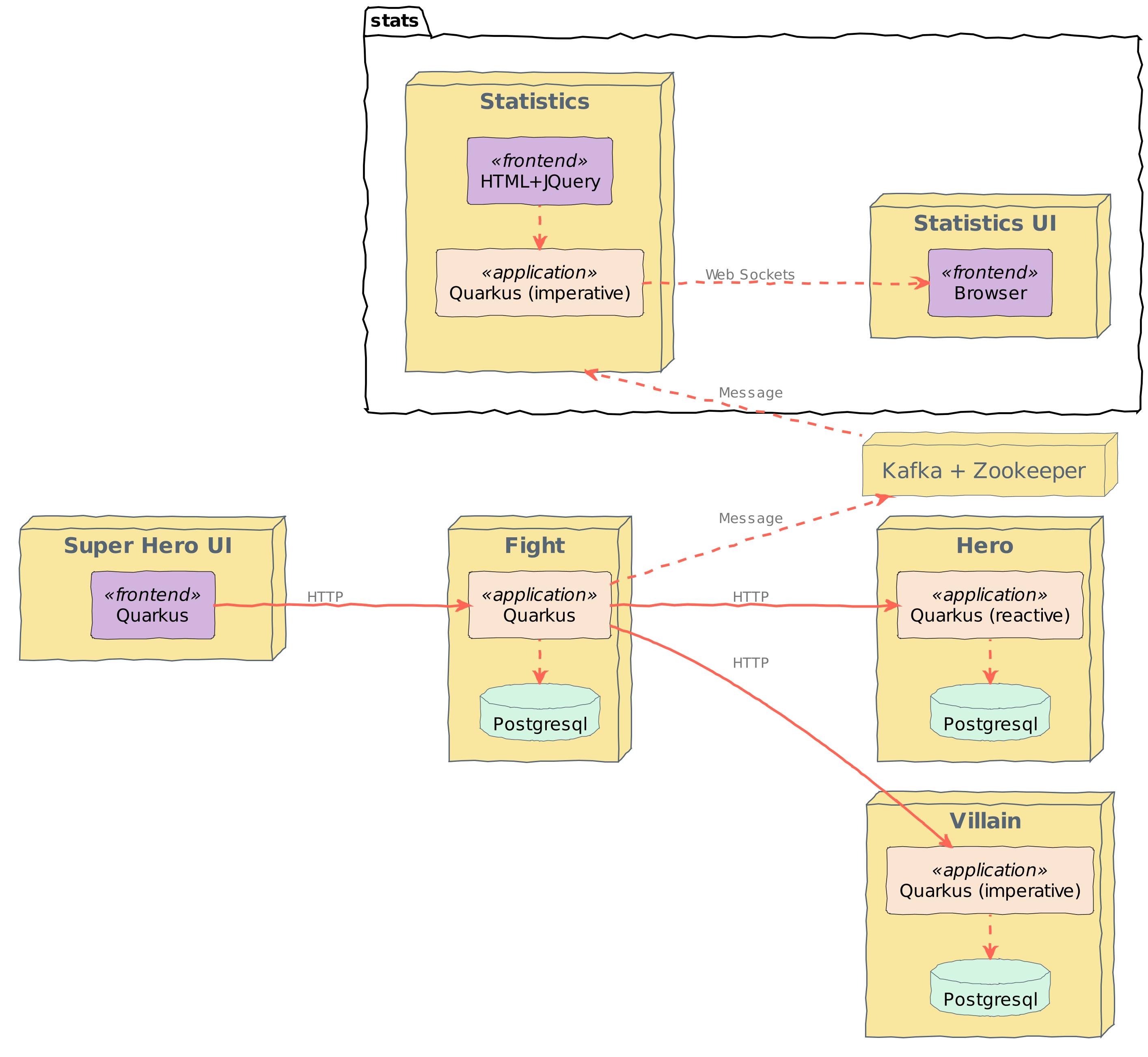
When the application persists a new fight, in the fight microservice, you are going to send it to a Kafka topic. These messages are read in the statistics microservice, processed, and the result is sent to a UI using web sockets.
| This service is exposed on the port 8085. |
Sending Messages to Kafka
In this section, you are going to see how you can send messages to a Kafka topic.[22]
Directory Structure
In this section we are going to extend the Fight microservice. In the following tree, we are going to edit the marked classes
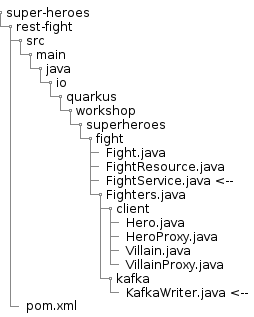
Adding the Reactive Messaging Dependency
The Kafka extension was already imported during the project creation. In doubt, you can run in the Fight microservice:
./mvnw quarkus:add-extension -Dextensions=" io.quarkus:quarkus-smallrye-reactive-messaging-kafka"The previous command adds the following dependency:
<dependency>
<groupId>io.quarkus</groupId>
<artifactId>quarkus-messaging-kafka</artifactId>
</dependency>If not yet started, start the microservice using ./mvnw quarkus:dev.
|
Quarkus starts a Kafka broker automatically.
You can check that by executing the |
Connecting Imperative and Reactive Using an Emitter
Now edit the FightService class.
First, add the following field:
@Channel("fights") Emitter<Fight> emitter;|
You will also need to add the following imports: |
This field is an emitter, and lets you send events or messages (here, we are sending fights) to the channel specified with the @Channel annotation.
A channel is a virtual destination.
In the persistFight method, add the following line just before the return statement:
emitter.send(fight).toCompletableFuture().join();With this in place, every time the application persists a fight, it also sends the fight to the fights channel.
You may wonder why we need .toCompletableFuture().join().
Sending a message to Kafka is an asynchronous operation, and we need to be sure that the fight is not accessed outside the transaction.
Thus, we wait until Kafka confirms the reception before returning.
Connecting to Kafka
At this point, the serialized fights are sent to the fights channel.
You need to connect this channel to a Kafka topic.
For this, edit the application.properties file and add the following properties:
mp.messaging.outgoing.fights.connector=smallrye-kafka
mp.messaging.outgoing.fights.value.serializer=io.quarkus.kafka.client.serialization.ObjectMapperSerializerThese properties are structured as follows:
mp.messaging.[incoming|outgoing].channel.attribute=valueFor example, mp.messaging.outgoing.fights.connector configures the connector used for the outgoing channel fights.
The mp.messaging.outgoing.fights.value.serializer configures the serializer used to write the message in Kafka.
When omitted, the Kafka topic reuses the channel name (fights).
Now, you have connected the fight microservice to Kafka, and you are sending new fights to the Kafka topic.
Let’s see how you can read these messages in the stats microservice.
Receiving Messages from Kafka
In this section, you are going to see how you can receive messages from a Kafka topic.
For this, you are going to create a new microservice, named stats.
This microservice computes statistics based on the results of the fights.
For example, it determines if villains win more battle than heroes, and who is the superhero or super-villain having won the most fights.
Directory Structure
In this section, we are going to develop the following structure:
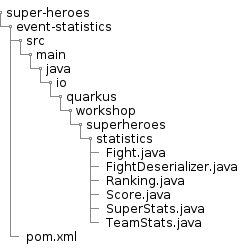
Bootstrapping the Statistics REST Endpoint
Like for the other microservice, the easiest way to create this new Quarkus project is to use a Maven command.
Under the quarkus-workshop-super-heroes/super-heroes root directory where you have all your code.
Open a terminal and run the following command:
./mvnw io.quarkus:quarkus-maven-plugin:3.27.0:create \
-DplatformVersion=3.27.0 \
-DprojectGroupId=io.quarkus.workshop.super-heroes \
-DprojectArtifactId=event-statistics \
-DclassName="io.quarkus.workshop.superheroes.statistics.StatisticResource" \
-Dpath="api/stats" \
-Dextensions="kafka, rest-jackson, websockets"If you want your IDE to manage this new Maven project, you can declare it in the parent POM by adding this new module in the <modules> section:
<module>super-heroes/event-statistics</module>Delete all the classes under the io.quarkus.workshop.superheroes.statistics package as well as the associated test classes.
There are just examples.
Consuming Fight
This service receives the Fight from the fight microservice.
So, naturally, we need a fight class.
Create the io.quarkus.workshop.superheroes.statistics.Fight class with the following content:
package io.quarkus.workshop.superheroes.statistics;
import java.time.Instant;
import io.quarkus.runtime.annotations.RegisterForReflection;
@RegisterForReflection
public class Fight {
public Instant fightDate;
public String winnerName;
public int winnerLevel;
public String winnerPicture;
public String loserName;
public int loserLevel;
public String loserPicture;
public String winnerTeam;
public String loserTeam;
}We also need to create a deserializer that will receive the Kafka record and create the Fight instances.
Create the io.quarkus.workshop.superheroes.statistics.FightDeserializer class with the following content:
package io.quarkus.workshop.superheroes.statistics;
import io.quarkus.kafka.client.serialization.ObjectMapperDeserializer;
public class FightDeserializer extends ObjectMapperDeserializer<Fight> {
public FightDeserializer() {
super(Fight.class);
}
}Computing Statistics
Now, create the io.quarkus.workshop.superheroes.statistics.SuperStats class with the following content.
This class contains two methods annotated with @Incoming and @Outgoing, both consuming the Fight coming from Kafka.
The computeTeamStats method transforms the fight stream into a stream of ratio indicating the amount of victories for heroes and villains.
It calls onItem().transform method for each received fight.
It sends the computed ratios on the channel team-stats.
The computeTopWinners method uses more advanced reactive programming constructs such as group and scan:
package io.quarkus.workshop.superheroes.statistics;
import io.smallrye.mutiny.Multi;
import org.eclipse.microprofile.reactive.messaging.Incoming;
import org.eclipse.microprofile.reactive.messaging.Outgoing;
import org.jboss.logging.Logger;
import jakarta.enterprise.context.ApplicationScoped;
import jakarta.inject.Inject;
@ApplicationScoped
public class SuperStats {
@Inject
Logger logger;
private final Ranking topWinners = new Ranking(10);
private final TeamStats stats = new TeamStats();
@Incoming("fights")
@Outgoing("team-stats")
public Multi<Double> computeTeamStats(Multi<Fight> results) {
return results
.onItem().transform(stats::add)
.invoke(() -> logger.info("Fight received. Computed the team statistics"));
}
@Incoming("fights")
@Outgoing("winner-stats")
public Multi<Iterable<Score>> computeTopWinners(Multi<Fight> results) {
return results
.group().by(fight -> fight.winnerName)
.onItem().transformToMultiAndMerge(group ->
group
.onItem().scan(Score::new, this::incrementScore))
.onItem().transform(topWinners::onNewScore)
.invoke(() -> logger.info("Fight received. Computed the top winners"));
}
private Score incrementScore(Score score, Fight fight) {
score.name = fight.winnerName;
score.score = score.score + 1;
return score;
}
}In addition, create the io.quarkus.workshop.superheroes.statistics.Ranking, io.quarkus.workshop.superheroes.statistics.Score and io.quarkus.workshop.superheroes.statistics.TeamStats classes with the following contents:
Then, create the Ranking class, used to compute a floating top 10, with the following content:
package io.quarkus.workshop.superheroes.statistics;
import java.util.Collections;
import java.util.Comparator;
import java.util.LinkedList;
public class Ranking {
private final int max;
private final Comparator<Score> comparator = Comparator.comparingInt(s -> -1 * s.score);
private final LinkedList<Score> top = new LinkedList<>();
public Ranking(int size) {
max = size;
}
public Iterable<Score> onNewScore(Score score) {
// Remove score if already present,
top.removeIf(s -> s.name.equalsIgnoreCase(score.name));
// Add the score
top.add(score);
// Sort
top.sort(comparator);
// Drop on overflow
if (top.size() > max) {
top.remove(top.getLast());
}
return Collections.unmodifiableList(top);
}
}The Score class is a simple structure storing the name of a hero or villain and its actual score, i.e. the number of won battles.
package io.quarkus.workshop.superheroes.statistics;
import io.quarkus.runtime.annotations.RegisterForReflection;
@RegisterForReflection
public class Score {
public String name;
public int score;
public Score() {
this.score = 0;
}
}The TeamStats class is an object keeping track of the number of battles won by heroes and villains.
package io.quarkus.workshop.superheroes.statistics;
class TeamStats {
private int villains = 0;
private int heroes = 0;
double add(Fight result) {
if (result.winnerTeam.equalsIgnoreCase("heroes")) {
heroes = heroes + 1;
} else {
villains = villains + 1;
}
return ((double) heroes / (heroes + villains));
}
}|
The |
Reading Messages from Kafka
It’s now time to connect the fights channel with the Kafka topic.
Edit the application.properties file and add the following content:
quarkus.http.port=8085
## Custom banner file path
quarkus.banner.path=banner.txt
## Kafka configuration
mp.messaging.incoming.fights.connector=smallrye-kafka
mp.messaging.incoming.fights.auto.offset.reset=earliest
mp.messaging.incoming.fights.broadcast=trueAs for the writing side, it configures the Kafka connector.
The mp.messaging.incoming.fights.auto.offset.reset=earliest property indicates that the topic is read from the earliest available record.
Check the Kafka configuration to see all the available settings.
Sending Events on WebSockets
At this point, you read the fights from Kafka and computes statistics. Actually, even if you start the application, nothing will happen as nobody consumes these statistics.
In this section, we are going to consume these statistics and send them to two WebSockets. For this, we are going to add two classes and a simple presentation page:
-
TeamStatsWebSocket -
TopWinnerWebSocket -
index.html
Quarkus uses the JSR 356 providing an annotation-driven approach to implement WebSockets.
The TeamStats WebSocket
Create the io.quarkus.workshop.superheroes.statistics.TeamStatsWebSocket class with the following content:
package io.quarkus.workshop.superheroes.statistics;
import io.smallrye.mutiny.Multi;
import io.smallrye.mutiny.subscription.Cancellable;
import jakarta.annotation.PostConstruct;
import jakarta.annotation.PreDestroy;
import org.eclipse.microprofile.reactive.messaging.Channel;
import org.jboss.logging.Logger;
import jakarta.enterprise.context.ApplicationScoped;
import jakarta.inject.Inject;
import jakarta.websocket.OnClose;
import jakarta.websocket.OnOpen;
import jakarta.websocket.Session;
import jakarta.websocket.server.ServerEndpoint;
import java.util.List;
import java.util.concurrent.CopyOnWriteArrayList;
@ServerEndpoint("/stats/team")
@ApplicationScoped
public class TeamStatsWebSocket {
@Channel("team-stats")
Multi<Double> stream;
@Inject Logger logger;
private final List<Session> sessions = new CopyOnWriteArrayList<>();
private Cancellable cancellable;
@OnOpen
public void onOpen(Session session) {
sessions.add(session);
}
@OnClose
public void onClose(Session session) {
sessions.remove(session);
}
@PostConstruct
public void subscribe() {
cancellable = stream.subscribe()
.with(ratio -> sessions.forEach(session -> write(session, ratio)));
}
@PreDestroy
public void cleanup() {
cancellable.cancel();
}
private void write(Session session, double ratio) {
session.getAsyncRemote().sendText(Double.toString(ratio), result -> {
if (result.getException() != null) {
logger.error("Unable to write message to web socket", result.getException());
}
});
}
}This component is a WebSocket as specified by the @ServerEndpoint("/stats/team") annotation.
It handles the /stats/team WebSocket.
When a client (like a browser) connects to the WebSocket, it keeps track of the session. This session is released when the client disconnects.
The TeamStatsWebSocket also injects a Multi attached to the team-stats channel.
After creation, the component subscribes to this stream and broadcasts the fights to the different clients connected to the web socket.
The subscription is an essential part of the stream lifecycle. It indicates that someone is interested in the items transiting on the stream, and it triggers the emission. In this case, it triggers the connection to Kafka and starts receiving the messages from Kafka. Without it, items would not be emitted.
The TopWinner WebSocket
The io.quarkus.workshop.superheroes.statistics.TopWinnerWebSocket follows the same pattern but subscribes to the winner-stats channel.
Create the io.quarkus.workshop.superheroes.statistics.TopWinnerWebSocket with the following content:
package io.quarkus.workshop.superheroes.statistics;
import com.fasterxml.jackson.databind.ObjectMapper;
import io.smallrye.mutiny.Multi;
import io.smallrye.mutiny.subscription.Cancellable;
import io.smallrye.mutiny.unchecked.Unchecked;
import jakarta.annotation.PostConstruct;
import jakarta.annotation.PreDestroy;
import org.eclipse.microprofile.reactive.messaging.Channel;
import org.jboss.logging.Logger;
import jakarta.enterprise.context.ApplicationScoped;
import jakarta.inject.Inject;
import jakarta.websocket.OnClose;
import jakarta.websocket.OnOpen;
import jakarta.websocket.Session;
import jakarta.websocket.server.ServerEndpoint;
import java.util.List;
import java.util.concurrent.CopyOnWriteArrayList;
@ServerEndpoint("/stats/winners")
@ApplicationScoped
public class TopWinnerWebSocket {
@Inject ObjectMapper mapper;
@Inject Logger logger;
@Channel("winner-stats")
Multi<Iterable<Score>> winners;
private final List<Session> sessions = new CopyOnWriteArrayList<>();
private Cancellable cancellable;
@OnOpen
public void onOpen(Session session) {
sessions.add(session);
}
@OnClose
public void onClose(Session session) {
sessions.remove(session);
}
@PostConstruct
public void subscribe() {
cancellable = winners
.map(Unchecked.function(scores -> mapper.writeValueAsString(scores)))
.subscribe().with(serialized -> sessions.forEach(session -> write(session, serialized)));
}
@PreDestroy
public void cleanup() {
cancellable.cancel();
}
private void write(Session session, String serialized) {
session.getAsyncRemote().sendText(serialized, result -> {
if (result.getException() != null) {
logger.error("Unable to write message to web socket", result.getException());
}
});
}
}Because the items (top 10) need to be serialized, the TopWinnerWebSocket also use Jackson to transform the object into a serialized form.
The UI
Finally, you need a UI to watch these live statistics.
Create the src/main/resources/META-INF/resources/index.html file with the following content:
<!DOCTYPE html>
<html lang="en">
<head>
<meta charset="UTF-8">
<title>Super Battle Stats</title>
<link rel="stylesheet" type="text/css" href="https://cdnjs.cloudflare.com/ajax/libs/patternfly/3.24.0/css/patternfly.min.css">
<link rel="stylesheet" type="text/css" href="https://cdnjs.cloudflare.com/ajax/libs/patternfly/3.24.0/css/patternfly-additions.min.css">
<style>
.page-title {
font-size: xx-large;
}
.progress {
background-color: firebrick;
}
.progress-bar {
background: dodgerblue;
}
</style>
</head>
<body>
<div class="container">
<div class="row">
<div class="col"><h1 class="page-title">Super Stats</h1></div>
</div>
</div>
<div class="container container-cards-pf">
<div class="row row-cards-pf">
<div class="col-xs-12 col-sm-6 col-md-4 col-lg-3">
<!-- Top winners -->
<div class="card-pf card-pf-view card-pf-view-select">
<h2 class="card-pf-title">
<i class="fa fa-trophy"></i> Top Winner
</h2>
<div class="card-pf-body">
<div id="top-winner">
</div>
</div>
</div>
</div>
<div class="col-xs-12 col-sm-8 col-md-6 col-lg-6">
<!-- Top losers -->
<div class="card-pf card-pf-view card-pf-view-select">
<h2 class="card-pf-title">
<i class="fa pficon-rebalance"></i> Heroes vs. Villains
</h2>
<div class="card-pf-body">
<div class="progress-container progress-description-left progress-label-right">
<div class="progress-description">
Heroes
</div>
<div class="progress">
<div id="balance" class="progress-bar" role="progressbar" aria-valuenow="50" aria-valuemin="0" aria-valuemax="100" style="width: 50%;">
<span>Villains</span>
</div>
</div>
</div>
</div>
</div>
</div>
</div>
</div>
<script src="https://cdnjs.cloudflare.com/ajax/libs/jquery/3.2.1/jquery.min.js"></script>
<script src="https://cdnjs.cloudflare.com/ajax/libs/twitter-bootstrap/3.3.7/js/bootstrap.min.js"></script>
<script src="https://cdnjs.cloudflare.com/ajax/libs/patternfly/3.24.0/js/patternfly.min.js"></script>
<script src="https://cdnjs.cloudflare.com/ajax/libs/c3/0.7.11/c3.js"></script>
<script src="https://cdnjs.cloudflare.com/ajax/libs/d3/5.12.0/d3.min.js"></script>
<script>
$(document).ready(function() {
var host = window.location.host;
var protocol = (window.location.protocol == "https:") ? "wss" : "ws";
var top = new WebSocket(protocol + "://" + host + "/stats/winners");
top.onmessage = function (event) {
updateTop(event.data);
};
var team = new WebSocket(protocol + "://" + host + "/stats/team");
team.onmessage = function(event) {
console.log(event.data);
updateRatio(event.data);
};
});
function updateTop(scores) {
$("#top-winner").children("p").remove();
JSON.parse(scores).forEach(function(score) {
$("#top-winner").append($("<p>" + score.name + " [" + score.score + "]</p>"))
});
}
function updateRatio(ratio) {
var percent = ratio * 100;
$("#balance").attr("aria-valuenow", ratio * 100).attr("style", "width: " + percent + "%;");
}
</script>
</body>
</html>Running the Application
You are all set!
Time to start the application using:
./mvnw quarkus:devThen, open http://localhost:8085 in a new browser window.
Trigger some fights, and you should see the live statistics moving.

Quarkus automatically reuse the Kafka broker from the fight service. So, make sure the fight service is started.
|
If you have any problem with the code, don’t understand or feel you are running, remember to ask for some help. Also, you can get the code of this entire workshop from https://github.com/quarkusio/quarkus-workshops/tree/refs/heads/main/quarkus-workshop-super-heroes. You can also download the completed code from https://raw.githubusercontent.com/quarkusio/quarkus-workshops/refs/heads/main/quarkus-workshop-super-heroes/dist/quarkus-super-heroes-workshop-complete.zip. |
Unifying Imperative and Reactive Programming
So, as seen in this chapter, Quarkus is not limited to HTTP microservices, but fits perfectly in an event-driven architecture. The secret behind this is to use a single reactive engine for both imperative and reactive code:

This unique architecture allows mixing imperative and reactive, but also use the right model for the job. To go further on this, we recommend:
-
https://quarkus.io/guides/reactive-routes-guide to use reactive routes
-
https://quarkus.io/guides/reactive-sql-clients to access SQL database in a non-blocking fashion
-
https://quarkus.io/guides/kafka-guide to integrate with Kafka
-
https://quarkus.io/guides/amqp-guide to integrate with AMQP 1.0
-
https://quarkus.io/guides/using-vertx to understand how you can use Vert.x directly
Loading the Microservices
Now that we have the three main microservices exposing health checks and metrics, time to have a decent user interface to monitor how the system behaves. The purpose of this workshop is to add some load to our application. You will download the load application, install it and run it.
Give me some load!
In the super-heroes/load-super-heroes directory, there is a command line Quarkus application .
This application simulates users interacting with the system so it generates some load.
Looking at Some Code
The CLIMain class is just a Picocli extension command line application that executes the FightScenario, HeroScenario and VillainScenario,
on the same thread but randomly executing 3 different random calls to the 3 REST APIs.
For example, if you look at the HeroScenario, you will see that it’s just a suit of HTTP calls on the Hero API:
protected List<Supplier<Response>> callSupplier () {
Supplier<Response> helloCall = () -> heroProxy.hello();
Supplier<Response> allCall = () -> heroProxy.all();
Supplier<Response> randomCall = () -> heroProxy.random();
Supplier<Response> getCall = () -> heroProxy.get(idParam());
Supplier<Response> createCall = () -> heroProxy.create(create());
Supplier<Response> deleteCall = () -> heroProxy.delete(idParam());
return Stream.of(allCall, helloCall, randomCall, getCall, createCall, deleteCall).collect(Collectors.toList());
}Running the Load Application
You are all set! Time to compile and start the load application using:
./mvnw package
java -jar ./target/quarkus-app/quarkus-run.jar -sYou will see the following logs. To stop the load, write something and press Enter key.
INFO: GET - http://localhost:8082/api/fights/1 - 200
INFO: DELETE - http://localhost:8084/api/villains/440 - 204
INFO: GET - http://localhost:8083/api/heroes - 200
INFO: GET - http://localhost:8084/api/villains/hello - 200
INFO: GET - http://localhost:8082/api/fights - 200
INFO: GET - http://localhost:8083/api/heroes/581 - 200
INFO: GET - http://localhost:8084/api/villains/126 - 200
INFO: GET - http://localhost:8082/api/fights/hello - 200
INFO: DELETE - http://localhost:8083/api/heroes/491 - 204|
Stop the load application before going further. |
Building Native Executables
Let’s now produce native executables for our application.
Thanks to its GraalVM integration, Quarkus can easily generate native executables.
Just like Go, native executables don’t need a VM to run; they contain the whole application, like an .exe file on Windows.
Building Native Executables with Quarkus
Having native executables for our microservices improves their startup time and produces a minimal disk footprint. This can be a big plus if your microservices run in a serverless environment where scaling from zero is important. The produced binary has everything to run the application, including the needed parts of the "JVM" (shrunk to be just enough to run the application), and the application itself.
|
Choosing JVM execution vs. native executable execution depends on your application needs and environment. |
To be able to build native executables, you need GraalVM to be installed.
And make sure you have the GRAALVM_HOME environment variable defined and pointing to where you installed GraalVM.
Then, if you look at all the pom.xml files, you will find the following profile.
This allows you to build a native executable just by invoking ./mvnw package -Pnative.
<profile>
<id>native</id>
<activation>
<property>
<name>native</name>
</property>
</activation>
<properties>
<skipITs>false</skipITs>
<quarkus.package.type>native</quarkus.package.type>
</properties>
</profile>Building Native Executables for our Microservices
Let’s create native executables for all our microservices. Well, maybe not all of them. Let’s see.
From the root super-heroes directory, run the following commands (to speed up the compilation you can also skip the tests by adding -Dmaven.test.skip=true):
./mvnw --file rest-fights/pom.xml package -Pnative
./mvnw --file rest-heroes/pom.xml package -Pnative
./mvnw --file rest-villains/pom.xml package -Pnative
./mvnw --file ui-super-heroes/pom.xml package -Pnative
./mvnw --file event-statistics/pom.xml package -Pnative|
Creating a native executable requires a lot of memory and CPU. It also takes a few minutes, even for a simple application like the Villain microservice. Most of the time is spent during the dead code elimination, as it traverses the whole (closed) world. |
During the compilation of each microservice, you see a lot of information about the native compilation. Below is a summary of the output for that you will get.
===========================================================================================
GraalVM Native Image: Generating 'rest-heroes-1.0.0-SNAPSHOT-runner' (executable)...
===========================================================================================
[1/8] Initializing... (24.3s @ 0.53GB)
[2/8] Performing analysis...
[3/8] Building universe... (6.9s @ 4.64GB)
[4/8] Parsing methods... [***] (5.1s @ 2.80GB)
[5/8] Inlining methods... [***] (2.1s @ 4.71GB)
[6/8] Compiling methods... [********] (67.6s @ 10.11GB)
[7/8] Layouting methods... [***] (9.4s @ 4.04GB)
[8/8] Creating image... [***] (9.1s @ 5.41GB)If you try to execute ./mvnw package -Pnative in the Narration microservice, the compilation will fail.
You will get something like this:
===========================================================================================
GraalVM Native Image: Generating 'rest-narration-1.0.0-SNAPSHOT-runner' (executable)...
===========================================================================================
[1/8] Initializing... (24.3s @ 0.53GB)
[2/8] Performing analysis...
ERROR [com.azu.cor.imp.jac.XmlMapperFactory] Failed to retrieve MethodHandles used to create XmlMapper. XML serialization won't be supported until 'com.fasterxml.jackson.dataformat:jackson-dataformat-xml'
ERROR [com.azu.cor.imp.jac.ObjectMapperShim] Package versions: jackson-core=2.15.2, jackson-databind=2.15.2, jackson-dataformat-xml=unknown, jackson-datatype-jsr310=2.15.2
Error: Classes that should be initialized at run time got initialized during image buildingThat’s because the Narration microservice uses external libraries that are not easily compilable with GraaVM. Not all libraries are compatible with GraalVM out of the box. Therefore, we will keep on running the Narration microservice in JVM mode, not in native mode.
./mvnw --file rest-narration/pom.xml clean package|
Do you remember the |
Running the Application in Native mode
The native compilation takes a while.
In addition to the regular files, the build also produces target/xxx-yyy-1.0.0-SNAPSHOT-runner files.
Notice that there is no .jar file extension.
It’s just a binary file that you can execute directly like any other binary.
Let’s execute the entire application in native mode.
Native mode is using the prod profile, meaning that the infrastructure needs to be up and running (docker compose -f docker-compose.yaml up -d).
Then, from the root super-heroes directory, run the following commands (to speed up the compilation you can also skip the tests by adding -Dmaven.test.skip=true):
./rest-fights/target/rest-fights-1.0.0-SNAPSHOT-runner
./rest-heroes/target/rest-heroes-1.0.0-SNAPSHOT-runner
./rest-villains/target/rest-villains-1.0.0-SNAPSHOT-runner
./ui-super-heroes/target/ui-super-heroes-1.0.0-SNAPSHOT-runner
./event-statistics/target/event-statistics-1.0.0-SNAPSHOT-runner
./rest-narration/target/quarkus-app/quarkus-run.jarYou can then go to http://localhost:8080 and start new fights.
Building Containers
In this chapter we will build containers out of our Quarkus microservices and execute them locally thanks to Docker Compose. Thanks to Quarkus Cloud Native capabilities, we will be able to build and execute containers easily. We will also produce Linux 64 bits native executables and runs them in a container. The native compilation uses the OS and architecture of the host system.
Building Containers with Quarkus
When we bootstrapped our microservices with the Maven Quarkus plugin, a set of Dockerfiles have been generated under src/main/docker:
-
Dockerfile.jvm: Dockerfile is used in order to build a container that runs the Quarkus application in JVM mode. -
Dockerfile.legacy-jar: Deprecated Dockerfile building a container in JVM mode. -
Dockerfile.native: Dockerfile is used in order to build a container that runs the Quarkus application in native (no JVM) mode. -
Dockerfile.native-micro: Same as above but it uses a micro base image, tuned for Quarkus native executables.
Quarkus is able to build a container image automatically. It proposes multiple approaches to do so, but we recommend using jib. As you have guessed by now, using jib is as simple as adding a Quarkus extension to each project.
Building Containers for our Microservices in JVM Mode
The Dockerfile.jvm file is for running the application in JVM mode.
It looks like this:
FROM registry.access.redhat.com/ubi8/openjdk-17:1.18
ENV LANGUAGE='en_US:en'
# We make four distinct layers so if there are application changes the library layers can be re-used
COPY --chown=185 target/quarkus-app/lib/ /deployments/lib/
COPY --chown=185 target/quarkus-app/*.jar /deployments/
COPY --chown=185 target/quarkus-app/app/ /deployments/app/
COPY --chown=185 target/quarkus-app/quarkus/ /deployments/quarkus/
EXPOSE 8080
USER 185
ENV JAVA_OPTS_APPEND="-Dquarkus.http.host=0.0.0.0 -Djava.util.logging.manager=org.jboss.logmanager.LogManager"
ENV JAVA_APP_JAR="/deployments/quarkus-run.jar"
ENTRYPOINT [ "/opt/jboss/container/java/run/run-java.sh" ]To start using it, we first need to install the jib extension in all our projects.
Add the quarkus-container-image-jib extension executing the following commands from the root super-heroes directory:
./mvnw --file rest-fights/pom.xml quarkus:add-extension -Dextensions="jib"
./mvnw --file rest-heroes/pom.xml quarkus:add-extension -Dextensions="jib"
./mvnw --file rest-villains/pom.xml quarkus:add-extension -Dextensions="jib"
./mvnw --file ui-super-heroes/pom.xml quarkus:add-extension -Dextensions="jib"
./mvnw --file event-statistics/pom.xml quarkus:add-extension -Dextensions="jib"
./mvnw --file rest-narration/pom.xml quarkus:add-extension -Dextensions="jib"It adds the following dependency to the pom.xml files:
<dependency>
<groupId>io.quarkus</groupId>
<artifactId>quarkus-container-image-jib</artifactId>
</dependency>Then, from the root super-heroes directory, execute the following commands to build the applications and create the container image (add -Dmaven.test.skip=true if you want to skip the tests):
./mvnw --file rest-fights/pom.xml clean package -Dquarkus.container-image.build=true
./mvnw --file rest-heroes/pom.xml clean package -Dquarkus.container-image.build=true
./mvnw --file rest-villains/pom.xml clean package -Dquarkus.container-image.build=true
./mvnw --file ui-super-heroes/pom.xml clean package -Dquarkus.container-image.build=true
./mvnw --file event-statistics/pom.xml clean package -Dquarkus.container-image.build=true
./mvnw --file rest-narration/pom.xml clean package -Dquarkus.container-image.build=trueCheck that you have all the Docker images installed locally:
docker image lsThe output should look like this:
REPOSITORY TAG IMAGE ID SIZE
<org>/rest-fights 1.0.0-SNAPSHOT adb8a546a66b 419MB
<org>/rest-heroes 1.0.0-SNAPSHOT d9e6ae6e3e23 402MB
<org>/rest-villains 1.0.0-SNAPSHOT 60a5c813f59a 402MB
<org>/ui-super-heroes 1.0.0-SNAPSHOT 82fce62c11a5 379MB
<org>/event-statistics 1.0.0-SNAPSHOT a5472c5bd576 395MB
<org>/rest-narration 1.0.0-SNAPSHOT fcfe334594f3 390MBRunning JVM Mode Containers Locally
Now that we have all our Docker images created, let’s execute them all to be sure that everything is working.
Under super-heroes/infrastructure you will find the docker-compose-app-local.yaml file.
It declares all the needed infrastructure (databases, Kafka) as well as our microservices.
|
In the |
Execute it with:
docker compose -f docker-compose-app-local.yaml upTo know that all your containers are started, you can use the following command:
docker compose -f docker-compose-app-local.yaml psYou should get something similar to the following list. Make sure all your containers are in running status:
NAME IMAGE STATUS PORTS
ui-super-heroes agoncal<org/ui-super-heroes:1.0.0-SNAPSHOT Up 0.0.0.0:8080->8080/tcp
rest-fights agoncal<org/rest-fights:1.0.0-SNAPSHOT Up 0.0.0.0:8082->8082/tcp
rest-heroes agoncal<org/rest-heroes:1.0.0-SNAPSHOT Up 0.0.0.0:8083->8083/tcp
rest-villains agoncal<org/rest-villains:1.0.0-SNAPSHOT Up 0.0.0.0:8084->8084/tcp
event-statistics agoncal<org/event-statistics:1.0.0-SNAPSHOT Up 0.0.0.0:8085->8085/tcp
rest-narration agoncal<org/rest-narration:1.0.0-SNAPSHOT Up 0.0.0.0:8086->8086/tcp
super-database postgres:14 Up (healthy) 0.0.0.0:5432->5432/tcp
super-kafka quay.io/strimzi/kafka:0.28.0-kafka-3.1.0 Up 0.0.0.0:9092->9092/tcpOnce all the containers are started, you can:
-
Go to http://localhost:8080 to check the main UI
-
Go to http://localhost:8085 to check the statistics UI
-
curl http://localhost:8084/api/villains | jq
-
curl http://localhost:8083/api/heroes | jq
Then, make sure you shut down the entire application with:
docker compose -f docker-compose-app-local.yaml downBuilding Containers for our Microservices in Native Mode
And… Linux Containers are … Linux. So before being able to build a container with our native executable, we need to produce compatible native executables. If you are using a Linux 64 bits machine, you are good to go. If not, Quarkus comes with a trick to produce these executable:
The Dockerfile.native file is for running the application in native mode.
It looks like this:
FROM registry.access.redhat.com/ubi8/ubi-minimal:8.9
WORKDIR /work/
RUN chown 1001 /work \
&& chmod "g+rwX" /work \
&& chown 1001:root /work
COPY --chown=1001:root target/*-runner /work/application
EXPOSE 8080
USER 1001
ENTRYPOINT ["./application", "-Dquarkus.http.host=0.0.0.0"]./mvnw clean package -Pnative -Dquarkus.native.container-build=true -DskipTestsThe -Dquarkus.native.container-build=true allows running the native compilation inside a container (provided by Quarkus).
The result is a Linux 64 bits executable.
|
Building a native executable takes time, CPU, and memory. It’s even more accurate in the container. So, first, be sure that your container system has enough memory to build the executable. It requires at least 6Gb of memory, 8Gb is recommended. |
Execute the above command for all our microservices. We also copy the UI into the fight service, to simplify the process:
cd rest-hero
./mvnw clean package -Pnative -Dquarkus.native.container-build=true -DskipTests
cd ..
cd rest-villains
./mvnw clean package -Pnative -Dquarkus.native.container-build=true -DskipTests
cd ..
cd rest-fight
cp -R ../ui-super-heroes/dist/* src/main/resources/META-INF/resources
./mvnw clean package -Pnative -Dquarkus.native.container-build=true -DskipTests
cd ..
cd event-statistics
./mvnw clean package -Pnative -Dquarkus.native.container-build=true -DskipTests
cd ..Building native containers
Now that we have the native executables, we can build containers.
When you create projects, Quarkus generates two Dockerfiles:
-
Dockerfile.jvm- ADockerfilefor running the application in JVM mode -
Dockerfile.native- ADockerfilefor running the application in native mode
We are interested in this second file.
Open one of these Dockerfile.native files:
FROM registry.access.redhat.com/ubi8/ubi-minimal
WORKDIR /work/
COPY target/*-runner /work/application
RUN chmod 775 /work
EXPOSE 8080
CMD ["./application", "-Dquarkus.http.host=0.0.0.0"]It’s a pretty straightforward Dockerfile taking a minimal base image and copying the generated native executable.
It also exposes the port 8080.
Wait, our microservices are not configured to run on the port 8080.
We need to override this property as well as a few other such as the HTTP client endpoints, and database locations.
To build the containers, use the following scripts:
export ORG=xxxx
cd rest-hero
docker build -f src/main/docker/Dockerfile.native -t $ORG/quarkus-workshop-hero .
cd ..
cd rest-villains
docker build -f src/main/docker/Dockerfile.native -t $ORG/quarkus-workshop-villain .
cd ..
cd rest-fight
docker build -f src/main/docker/Dockerfile.native -t $ORG/quarkus-workshop-fight .
cd ..
cd event-statistics
docker build -f src/main/docker/Dockerfile.native -t $ORG/quarkus-workshop-stats .
cd ..|
Replace |
Running Native Mode Containers Locally
Building a container running a native executable
We’ve just created a container that embeds the Java application and a JVM. But you can also build and use the native executable. To do this, runs the following command:
./mvnw clean package -Dquarkus.container-image.build=true -Pnative -Dquarkus.native.container-build=true-Dquarkus.native.container-build=true is indicating that we need a Linux 64bits executable.
This option is not required if you use Linux.
Deploying with Kubernetes
This chapter explores how you can deploy containerized Quarkus applications in Cloud platforms using Kubernetes. There are many different approaches to achieve these deployments. In this chapter, we are focusing on deploying our containers in Kubernetes.
Deploying on Kubernetes
This section is going to deploy our microservices on Kubernetes. It is required to have access to a Kubernetes or OpenShift cluster.
|
To deploy your microservices, push the built container images to an image registry accessible by your cluster, such as Quay.io or DockerHub. |
We recommend using a specific namespace to deploy your system.
In the following sections, we use the quarkus-workshop namespace.
Deploying the infrastructure
The first thing to deploy is the required infrastructure:
-
3 PostgreSQL instances
-
Kafka brokers (3 brokers with 3 Zookeeper to follow the recommended approach)
There are many ways to deploy this infrastructure. Here, we are going to use two operators:
-
PostgreSQL Operator by Dev4Ddevs.com
-
Strimzi Apache Kafka Operator by Red Hat
With these operators installed, you can create the required infrastructure with the following custom resource definition (CRD):
apiVersion: postgresql.dev4devs.com/v1alpha1
kind: Database
metadata:
name: heroes-database
namespace: quarkus-workshop
spec:
databaseCpu: 30m
databaseCpuLimit: 60m
databaseMemoryLimit: 512Mi
databaseMemoryRequest: 128Mi
databaseName: heroes-database
databaseNameKeyEnvVar: POSTGRESQL_DATABASE
databasePassword: superman
databasePasswordKeyEnvVar: POSTGRESQL_PASSWORD
databaseStorageRequest: 1Gi
databaseUser: superman
databaseUserKeyEnvVar: POSTGRESQL_USER
image: centos/postgresql-96-centos7
size: 1This CRD creates the database for the Hero microservice. Duplicate this CRD for the fight and villain databases.
For the Kafka broker, create the following CRD:
apiVersion: kafka.strimzi.io/v1beta1
kind: Kafka
metadata:
name: my-kafka
namespace: quarkus-workshop
spec:
kafka:
version: 2.3.0
replicas: 3
listeners:
plain: {}
tls: {}
config:
offsets.topic.replication.factor: 3
transaction.state.log.replication.factor: 3
transaction.state.log.min.isr: 2
log.message.format.version: '2.3'
storage:
type: ephemeral
zookeeper:
replicas: 3
storage:
type: ephemeral
entityOperator:
topicOperator: {}
userOperator: {}This CRD creates the brokers and the Zookeeper instances.
It’s also recommended to create the topic.
For this, create the following CRD:
apiVersion: kafka.strimzi.io/v1beta1
kind: KafkaTopic
metadata:
name: fights
labels:
strimzi.io/cluster: my-kafka
namespace: quarkus-workshop
spec:
partitions: 1
replicas: 3
config:
retention.ms: 604800000
segment.bytes: 1073741824Once everything is created, you should have the following resources:
$ kubectl get database
NAME AGE
fights-database 16h
heroes-database 16h
villains-database 16h
$ kubectl get kafka
NAME DESIRED KAFKA REPLICAS DESIRED ZK REPLICAS
my-kafka 3Deploying the Hero & Villain microservices
Now that the infrastructure is in place, we can deploy our microservices. Let’s start with the hero and villain microservices.
For each, we need to override the port and data source URL.
Create a config map with the following content:
apiVersion: v1
data:
port: "8080"
database: "jdbc:postgresql://heroes-database:5432/heroes-database"
kind: ConfigMap
metadata:
name: hero-configDo the same for the villain microservice. Then, apply these resources:
$ kubectl apply -f config-hero.yaml
$ kubectl apply -f config-villain.yamlOnce the config maps are created, we can deploy the microservices.
Create a deployment-hero.yaml file with the following content:
apiVersion: "v1"
kind: "List"
items:
- apiVersion: "v1"
kind: "Service"
metadata:
labels:
app: "quarkus-workshop-hero"
version: "01"
group: "$ORG"
name: "quarkus-workshop-hero"
spec:
ports:
- name: "http"
port: 8080
targetPort: 8080
selector:
app: "quarkus-workshop-hero"
version: "01"
group: "$ORG"
type: "ClusterIP"
- apiVersion: "apps/v1"
kind: "Deployment"
metadata:
labels:
app: "quarkus-workshop-hero"
version: "01"
group: "$ORG"
name: "quarkus-workshop-hero"
spec:
replicas: 1
selector:
matchLabels:
app: "quarkus-workshop-hero"
version: "01"
group: "$ORG"
template:
metadata:
labels:
app: "quarkus-workshop-hero"
version: "01"
group: "$ORG"
spec:
containers:
- image: "$ORG/quarkus-workshop-hero:latest"
imagePullPolicy: "IfNotPresent"
name: "quarkus-workshop-hero"
ports:
- containerPort: 8080
name: "http"
protocol: "TCP"
env:
- name: "KUBERNETES_NAMESPACE"
valueFrom:
fieldRef:
fieldPath: "metadata.namespace"
- name: QUARKUS_DATASOURCE_URL
valueFrom:
configMapKeyRef:
name: hero-config
key: database
- name: QUARKUS_HTTP_PORT
valueFrom:
configMapKeyRef:
name: hero-config
key: portThis descriptor declares:
-
A service to expose the HTTP endpoint
-
A deployment that instantiates the application
The deployment declares one container using the container image we built earlier. It also overrides the configuration for the HTTP port and database URL.
Don’t forget to create the equivalent files for the villain microservice.
Then, deploy the microservice with:
$ kubectl apply -f deployment-hero.yaml
$ kubectl apply -f deployment-villain.yamlDeploying the Fight microservice
Follow the same approach for the fight microservice. Note that there are more properties to configure from the config map:
-
The location of the hero and villain microservice
-
The location of the Kafka broker
Once everything is configured and deployed, your system is now running on Kubernetes.
From Container to Kubernetes
|
This section is optional and demonstrates how to ask Quarkus to create a container and deploy it to Kubernetes. We will need a running Kubernetes. We will use Rancher Desktop as indicated in the prerequisites. |
Prerequisites
-
Make sure that Docker Desktop (if installed) is turned off
-
Make sure Rancher Desktop is started. The container runtime must be dockerd (Preferences → Container Runtime → dockerd (moby)).
Deploying to Kubernetes
Quarkus can also run our application in Kubernetes and compute the Kubernetes descriptor. In addition to allow customizing any part of the descriptor, it is possible to configure config maps, secrets…
|
As mentioned above, we will use Rancher Desktop. Adapt the instructions for your Kubernetes:
|
Edit the src/main/resources/application.properties to add the following lines:
quarkus.kubernetes.namespace=default # Added
quarkus.kubernetes.image-pull-policy=IfNotPresent # Added
%prod.quarkus.http.port=8080 # Added
%prod.quarkus.datasource.username=superbad
%prod.quarkus.datasource.password=superbad
%prod.quarkus.datasource.jdbc.url=jdbc:postgresql://my-villains-db-postgresql:5432/villains_database # Updated
%prod.quarkus.hibernate-orm.sql-load-script=import.sqlAdd the quarkus-kubernetes extension using the following command:
./mvnw quarkus:add-extension -Dextensions="kubernetes"| If you are behind a proxy, check the Quarkus Registry proxy documentation. |
Alternatively, you can add the following dependency to the pom.xml file directly:
<dependency>
<groupId>io.quarkus</groupId>
<artifactId>quarkus-kubernetes</artifactId>
</dependency>Rancher Desktop authentication use elliptic algorithms not supported by default in Java. So, we also need to add the following dependency to the project:
<dependency>
<groupId>org.bouncycastle</groupId>
<artifactId>bcpkix-jdk18on</artifactId>
<version>1.71</version>
</dependency>Before deploying our application, we need to deploy the database. To achieve this, we are going to use helm (installed alongside Rancher Desktop) and the following postgresql package.
Run the following commands:
helm repo add bitnami https://charts.bitnami.com/bitnami
helm install my-villains-db \
--set auth.postgresPassword=superbad \
--set auth.username=superbad \
--set auth.password=superbad \
--set auth.database=villains_database bitnami/postgresqlFinally, deploy the application using:
./mvnw clean package -Dquarkus.kubernetes.deploy=true -DskipTestsCheck the pods with the following command:
kubectl get podsYou should see something like:
NAME READY STATUS RESTARTS AGE
my-villains-db-postgresql-0 1/1 Running 0 28m
rest-villains-7c7479b959-7fn64 1/1 Running 0 12mMake sure you wait for the rest-villains pod to be ready (1/1).
Enable port-forwarding to port 8080 either from the rancher desktop UI (Preferences → Port Forwarding → default / rest-villains / http), or using the following command line:
kubectl port-forward pods/rest-villains-7c7479b959-7fn64 8080:8080Now, you can access the application from your browser using: http://localhost:8080/api/villains
Deploying to Open Shift
Deploying to Azure Container Apps
In this chapter, you are going to see:
-
What’s Azure Container Apps?
-
How does Azure Container Apps fit in the long list of Azure services?
-
Pros and cons of using Azure Container Apps
What’s Azure Container Apps?
Azure Container Apps is a fully managed serverless container service on Azure. It allows you to run containerized applications without worrying about orchestration or managing complex infrastructure such as Kubernetes. You write code using your preferred programming language or framework (in this workshop it’s Java and Quarkus, but it can be anything), and build microservices with full support for Distributed Application Runtime (Dapr). Then, your containers will scale dynamically based on HTTP traffic or events powered by Kubernetes Event-Driven Autoscaling (KEDA).
There are already a few compute resources on Azure: from IAAS to FAAS. Azure Container Apps sits between PAAS and FAAS. On one hand, it feels more PaaS, because you are not forced into a specific programming model and you can control the rules on which to scale out / scale in. On the other hand, it has quite some serverless characteristics like scaling to zero, event-driven scaling, per second pricing and the ability to leverage Dapr’s event-based bindings.

Container Apps is built on top of Azure Kubernetes Service, including a deep integration with KEDA (event-driven auto scaling for Kubernetes), Dapr (distributed application runtime) and Envoy (a service proxy designed for cloud-native applications). The underlying complexity is completely abstracted for the end-user. So no need to configure your K8S service, deployment, ingress, volume manifests… You get a very simple API and user interface to configure the desired configuration for your containerized application. This simplification means also less control, hence the difference with AKS.
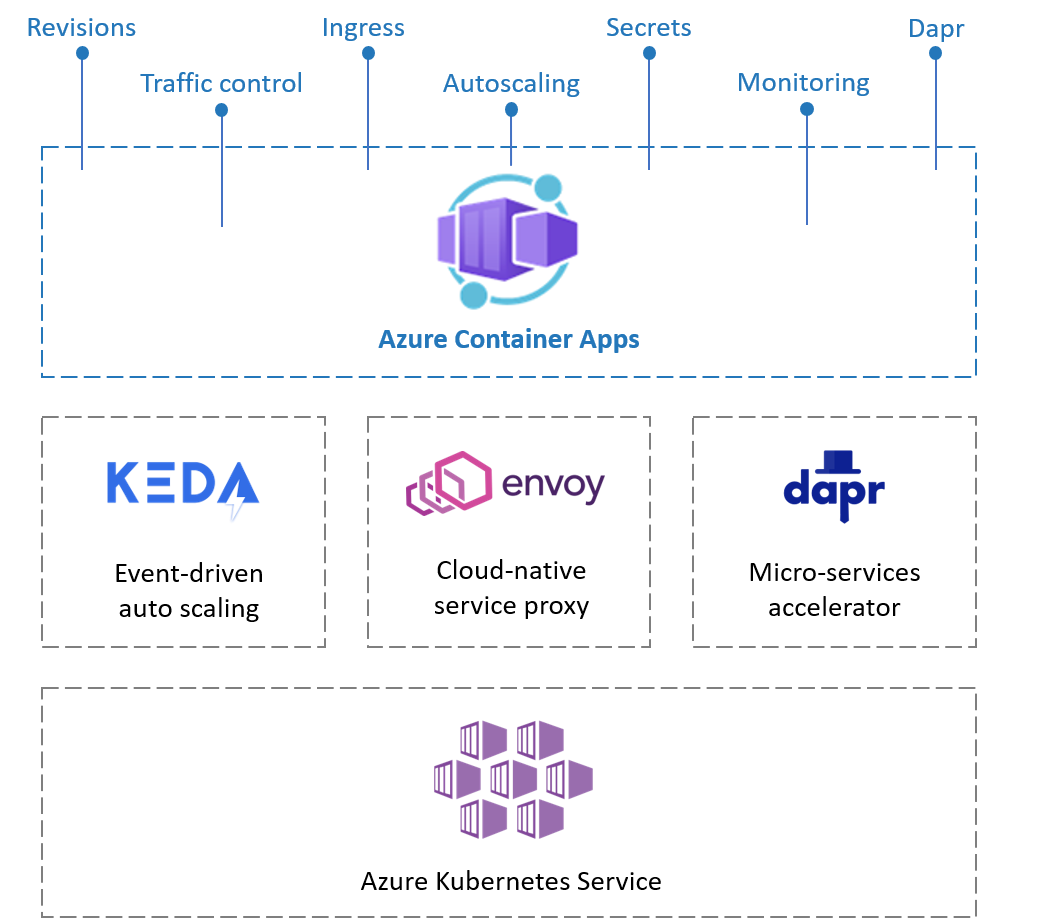
Azure Container Apps has the following features:
-
Revisions: automatic versioning that helps to manage the application lifecycle of your container apps
-
Traffic control: split incoming HTTP traffic across multiple revisions for Blue/Green deployments and A/B testing
-
Ingress: simple HTTPS ingress configuration, without the need to worry about DNS and certificates
-
Autoscaling: leverage all KEDA-supported scale triggers to scale your app based on external metrics
-
Secrets: deploy secrets that are securely shared between containers, scale rules and Dapr sidecars
-
Monitoring: the standard output and error streams are automatically written to Log Analytics
-
Dapr: through a simple flag, you can enable native Dapr integration for your Container Apps
Azure Container Apps introduce the following concepts:
-
Environment: this is a secure boundary around a group of Container Apps. They are deployed in the same virtual network, these apps can easily intercommunicate easily with each other and they write logs to the same Log Analytics workspace. An environment can be compared with a Kubernetes namespace.
-
Container App: this is a group of containers (pod) that is deployed and scale together. They share the same disk space and network.
-
Revision: this is an immutable snapshot of a Container App. New revisions are automatically created and are valuable for HTTP traffic redirection strategies, such as A/B testing.
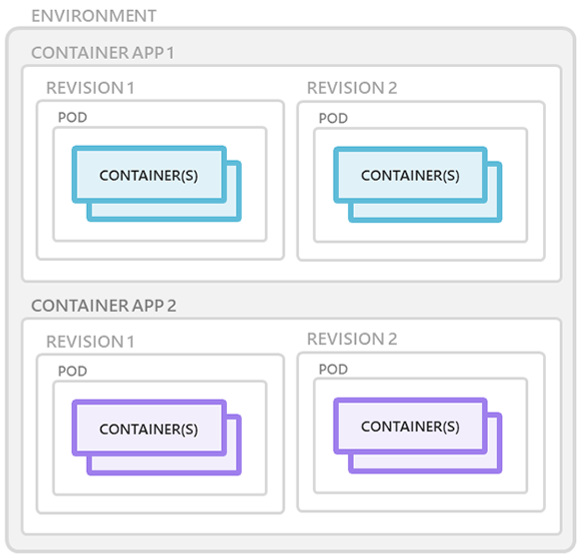
Setting Up Azure
To be able to deploy the application to Azure, you first need an Azure subscription. If you don’t have one, go to https://signup.azure.com and register.
Then, sign in to Azure from the CLI:
az loginMake sure you are using the right subscription with:
az account showSetting Up the Azure Environment
Azure CLI is extensible and you can install as many extensions as you need.
For this workshop, install the Azure Container Apps and Database extensions for the Azure CLI:
az extension add --name containerapp --upgrade
az extension add --name rdbms-connect --upgrade
az extension add --name log-analytics --upgradeYou can then check the extensions that are installed in your system with the following command:
az extension listYou should see the extensions that have been installed:
|
If you are on Windows and using WSL, the extensions should be installed under |
[
...
{
"experimental": false,
"extensionType": "whl",
"name": "containerapp",
"path": "/Users/agoncal/.azure/cliextensions/containerapp",
"preview": true,
"version": "0.3.4"
},
...
]Then, register the needed Azure namespaces:
az provider register --namespace Microsoft.App
az provider register --namespace Microsoft.OperationalInsights
az provider register --namespace Microsoft.InsightsCreating Azure Resources
Before creating the infrastructure for the Super Heroes application and deploying the microservices to Azure Container Apps, we need to create some Azure resources.
Setting Up the Azure environment variables
Let’s first set a few environment variables that will help us in creating the Azure infrastructure.
Set the following variables.
If you’ve picked up Azure OpenAI for the Narration microservice, then you should already have the PROJECT, RESOURCE_GROUP, LOCATION and TAG variables setup.
PROJECT="<give-your-project-a-name>"
RESOURCE_GROUP="rg-${PROJECT}"
LOCATION="eastus"
TAG=$PROJECT
LOG_ANALYTICS_WORKSPACE="log-${PROJECT}"
UNIQUE_IDENTIFIER=$(whoami)
REGISTRY="registrysuperheroes"$UNIQUE_IDENTIFIER
IMAGES_TAG="1.0"Now let’s create the Azure resources.
Resource Group
A resource group is a container that holds related resources for an Azure solution. The resource group can include all the resources for the solution, or only those resources that you want to manage as a group. In our workshop, all the databases, all the microservices, etc. will be grouped into a single resource group.
Execute the following command to create the Super Hero resource group:
az group create \
--name "$RESOURCE_GROUP" \
--location "$LOCATION" \
--tags system="$TAG"Log Analytics Workspace
Log Analytics workspace is the environment for Azure Monitor log data. Each workspace has its own data repository and configuration, and data sources and solutions are configured to store their data in a particular workspace. We will use the same workspace for most of the Azure resources we will be creating.
Create a Log Analytics workspace with the following command:
az monitor log-analytics workspace create \
--resource-group "$RESOURCE_GROUP" \
--location "$LOCATION" \
--tags system="$TAG" \
--workspace-name "$LOG_ANALYTICS_WORKSPACE"Let’s also retrieve the Log Analytics Client ID and client secret and store them in environment variables:
LOG_ANALYTICS_WORKSPACE_CLIENT_ID=`az monitor log-analytics workspace show \
--resource-group "$RESOURCE_GROUP" \
--workspace-name "$LOG_ANALYTICS_WORKSPACE" \
--query customerId \
--output tsv | tr -d '[:space:]'`
echo $LOG_ANALYTICS_WORKSPACE_CLIENT_ID
LOG_ANALYTICS_WORKSPACE_CLIENT_SECRET=`az monitor log-analytics workspace get-shared-keys \
--resource-group "$RESOURCE_GROUP" \
--workspace-name "$LOG_ANALYTICS_WORKSPACE" \
--query primarySharedKey \
--output tsv | tr -d '[:space:]'`
echo $LOG_ANALYTICS_WORKSPACE_CLIENT_SECRETAzure Container Registry
In the next chapters we will be creating Docker containers and pushing them to the Azure Container Registry. Azure Container Registry is a private registry for hosting container images. Using the Azure Container Registry, you can store Docker-formatted images for all types of container deployments.
First, let’s created an Azure Container Registry with the following command:
az acr create \
--resource-group "$RESOURCE_GROUP" \
--location "$LOCATION" \
--tags system="$TAG" \
--name "$REGISTRY" \
--workspace "$LOG_ANALYTICS_WORKSPACE" \
--sku Premium \
--admin-enabled trueUpdate the repository to allow anonymous users to pull the images:
az acr update \
--resource-group "$RESOURCE_GROUP" \
--name "$REGISTRY" \
--anonymous-pull-enabled trueGet the URL of the Azure Container Registry and set it to the REGISTRY_URL variable with the following command:
REGISTRY_URL=$(az acr show \
--resource-group "$RESOURCE_GROUP" \
--name "$REGISTRY" \
--query "loginServer" \
--output tsv)
echo $REGISTRY_URLIf you log into the Azure Portal you should see the following created resources.
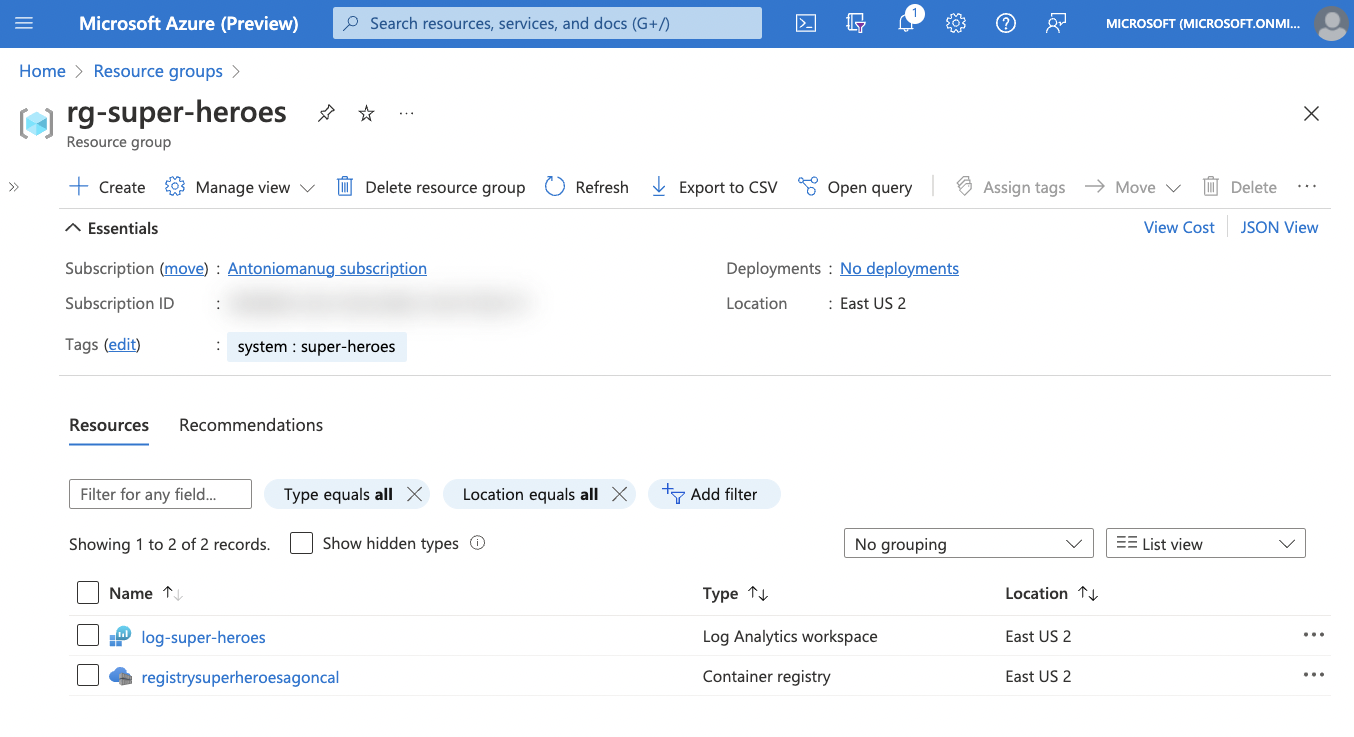
Setting Up the Environment Variables
The Super Heroes environment and application will be created and deployed using a set of Azure CLI commands. Each of these commands need a set of parameters, and some of these parameters can be set of environment variables.
Set the following environment variables, there will be needed in the Azure CLI commands:
# Container Apps
CONTAINERAPPS_ENVIRONMENT="env-${PROJECT}"
# Postgres
POSTGRES_DB_ADMIN="superheroesadmin"
POSTGRES_DB_PWD="super-heroes-p#ssw0rd-12046"
POSTGRES_DB_VERSION="15"
POSTGRES_SKU="Standard_B1ms"
POSTGRES_TIER="Burstable"
# Heroes
HEROES_APP="heroes-app"
HEROES_DB="heroes-db-$UNIQUE_IDENTIFIER"
HEROES_IMAGE="${REGISTRY_URL}/${HEROES_APP}:${IMAGES_TAG}"
HEROES_DB_SCHEMA="heroes"
HEROES_DB_CONNECT_STRING="postgresql://${HEROES_DB}.postgres.database.azure.com:5432/${HEROES_DB_SCHEMA}?ssl=true&sslmode=require"
# Villains
VILLAINS_APP="villains-app"
VILLAINS_DB="villains-db-$UNIQUE_IDENTIFIER"
VILLAINS_IMAGE="${REGISTRY_URL}/${VILLAINS_APP}:${IMAGES_TAG}"
VILLAINS_DB_SCHEMA="villains"
VILLAINS_DB_CONNECT_STRING="jdbc:postgresql://${VILLAINS_DB}.postgres.database.azure.com:5432/${VILLAINS_DB_SCHEMA}?ssl=true&sslmode=require"
# Fights
FIGHTS_APP="fights-app"
FIGHTS_DB="fights-db-$UNIQUE_IDENTIFIER"
FIGHTS_IMAGE="${REGISTRY_URL}/${FIGHTS_APP}:${IMAGES_TAG}"
FIGHTS_DB_SCHEMA="fights"
FIGHTS_DB_CONNECT_STRING="jdbc:postgresql://${FIGHTS_DB}.postgres.database.azure.com:5432/${FIGHTS_DB_SCHEMA}?ssl=true&sslmode=require"
# UI
UI_APP="super-heroes-ui"
UI_IMAGE="${REGISTRY_URL}/${UI_APP}:${IMAGES_TAG}"
# Statistics
STATISTICS_APP="statistics-app"
STATISTICS_IMAGE="${REGISTRY_URL}/${STATISTICS_APP}:${IMAGES_TAG}"
# Kafka
KAFKA_NAMESPACE="fights-kafka-$UNIQUE_IDENTIFIER"
KAFKA_TOPIC="fights"
KAFKA_BOOTSTRAP_SERVERS="$KAFKA_NAMESPACE.servicebus.windows.net:9093"
# Narration
NARRATION_APP="narration-app"
NARRATION_IMAGE="${REGISTRY_URL}/${NARRATION_APP}:${IMAGES_TAG}"Running the Application Locally
In this chapter we will push the containers we’ve created in the previous chapter to Azure Container Registry, and we will run them locally. Later we will deploy them on Azure Container Apps.
Pushing Local Images to Azure Container Registry
In the previous chapter we have built our Docker containers and run locally thanks to Docker Compose.
Check that you have all the Docker images installed locally before going further by executing the following command:
docker image lsThe output should look like this:
REPOSITORY TAG IMAGE ID SIZE
<org>/rest-fights 1.0.0-SNAPSHOT adb8a546a66b 419MB
<org>/rest-heroes 1.0.0-SNAPSHOT d9e6ae6e3e23 402MB
<org>/rest-villains 1.0.0-SNAPSHOT 60a5c813f59a 402MB
<org>/ui-super-heroes 1.0.0-SNAPSHOT 82fce62c11a5 379MB
<org>/event-statistics 1.0.0-SNAPSHOT a5472c5bd576 395MB
<org>/rest-narration 1.0.0-SNAPSHOT fcfe334594f3 390MBNow we will tag the images, push them to Azure Container Registry and execute them locally, again, with Docker Compose.
|
Make sure you’ve set all the environment variables defined in the previous chapter and that you’ve also created the resource group and the Azure Container Registry. |
Before you can push an image to your registry, you must tag it with the fully qualified name of your registry login server (the REGISTRY_URL variable).
Tag the image using the docker tag commands (make sure to change the value of quarkus/ by the value of your local organisation):
docker tag quarkus/ui-super-heroes:1.0.0-SNAPSHOT $UI_IMAGE
docker tag quarkus/rest-fights:1.0.0-SNAPSHOT $FIGHTS_IMAGE
docker tag quarkus/rest-villains:1.0.0-SNAPSHOT $VILLAINS_IMAGE
docker tag quarkus/rest-heroes:1.0.0-SNAPSHOT $HEROES_IMAGE
docker tag quarkus/event-statistics:1.0.0-SNAPSHOT $STATISTICS_IMAGE
docker tag quarkus/rest-narration:1.0.0-SNAPSHOT $NARRATION_IMAGEMake sure all the images have properly been tagged by executing the following command:
docker image lsThe output should look like this:
REPOSITORY TAG IMAGE ID SIZE
registrysuperheroes<uniquename>.azurecr.io/fights-app 1.0 f6605baa0b3c 461MB
registrysuperheroes<uniquename>.azurecr.io/heroes-app 1.0 c5acab2980c3 443MB
registrysuperheroes<uniquename>.azurecr.io/villains-app 1.0 666953f1bd0c 444MB
registrysuperheroes<uniquename>.azurecr.io/super-heroes-ui 1.0 879013ecd43a 420MB
registrysuperheroes<uniquename>.azurecr.io/event-statistics 1.0 a5472c5bd576 395MB
registrysuperheroes<uniquename>.azurecr.io/narration-app 1.0 50c657de360d 432MBTo be able to push these Docker images to Azure Registry, we first need to log in to the registry:
az acr login \
--name "$REGISTRY"You should see the prompt Login Succeeded.
Then, push all the images with the following commands:
docker push $UI_IMAGE
docker push $FIGHTS_IMAGE
docker push $VILLAINS_IMAGE
docker push $HEROES_IMAGE
docker push $STATISTICS_IMAGE
docker push $NARRATION_IMAGEYou can check that the images have been pushed to Azure Container Registry by executing the following command:
az acr repository list \
--name "$REGISTRY" \
--output tableYou can also get some information on a particular repository or image if needed:
az acr repository show \
--name "$REGISTRY" \
--repository "$HEROES_APP"You can visualize the content of the registry on the Azure Portal.
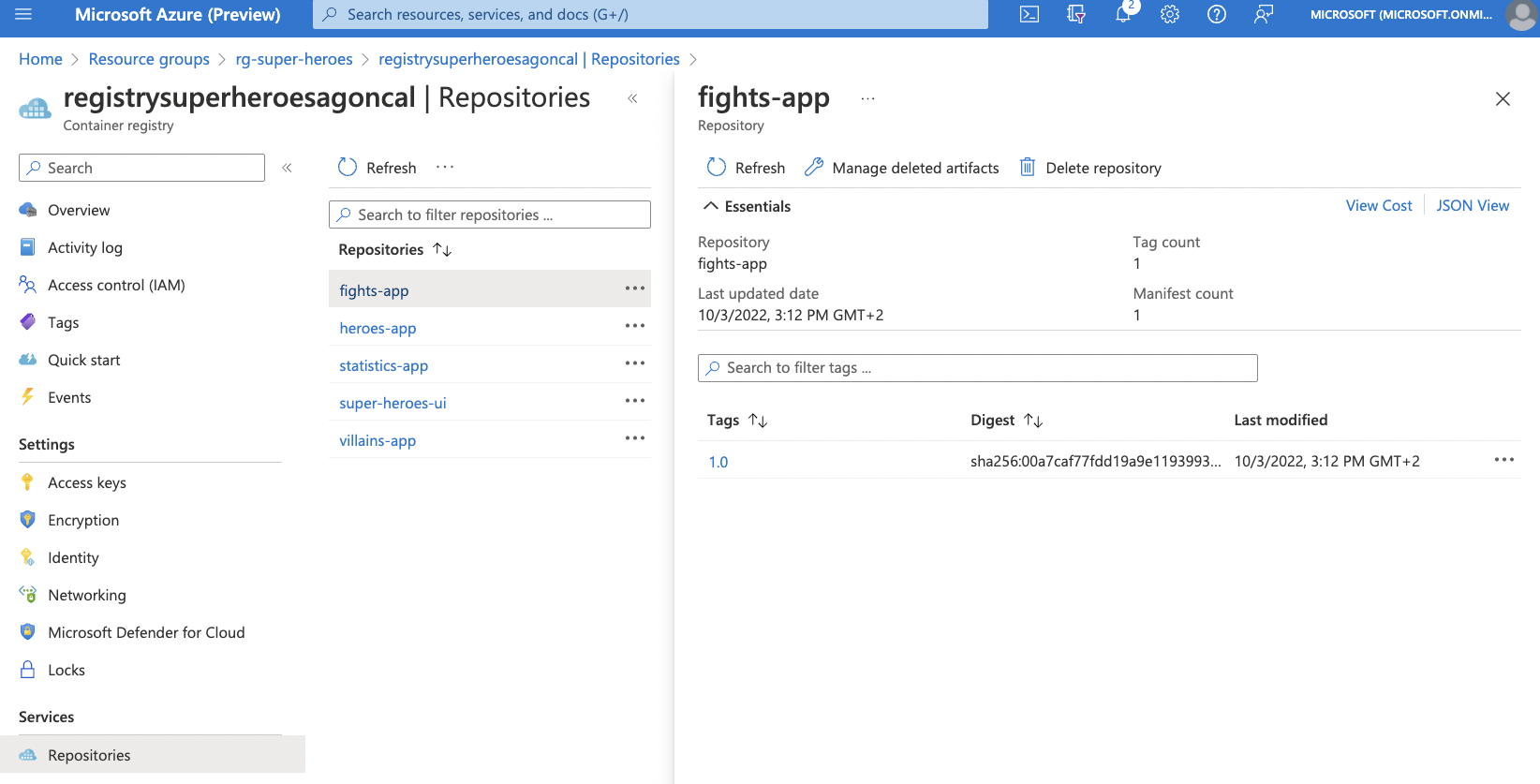
Running Remote Images Locally
Now that we have our docker images pushed to Azure Container Registry, we can run them locally with Docker Compose.
We will use the docker-compose-app-remote.yaml file under super-heroes/infrastructure to run the remote images locally.
But before we need to change a few things.
You should edit the docker-compose-app-remote.yaml file under super-heroes/infrastructure and change the name registrysuperheroesagoncal with the value of the $REGISTRY variable.
Now that we have all our Docker containers pushed to Azure Container Registry, let’s execute them with:
docker compose -f docker-compose-app-remote.yaml ups Once all the containers are started, you can:
-
Go to http://localhost:8080 to check the main UI
-
curl http://localhost:8084/api/villains | jq
-
curl http://localhost:8083/api/heroes | jq
-
Go to http://localhost:8085 to check the statistics UI
On http://localhost:8080 you should see the user interface, and you should be able to fight super heroes against super villains:

On http://localhost:8085 you should see the statistics of the fights. When super heroes and super heroes are fights, the statistics shows which one has won the most fights, and the percentage of fights won by the two groups. The UI is automatically updated at each fight:

You should see the user interface and everything should work. Remember to shutdown the entire application with:
docker compose -f docker-compose-app-remote.yaml downOk, enough running these containers locally! In the next chapter we will take these remote containers, configure them, and make them work remotely on Azure Container Apps.
Running the Application on Azure Container Apps
Now that we have containerized our application, push it to Azure Container Registry and execute it locally, time to execute it on Azure Container Apps. In this chapter we will create the needed infrastructure in Azure Container Apps (database, Kafka, etc.) and then deploy the containers so we can execute our application.
Deploying the Infrastructure
Before deploying our microservices to Azure Container Apps, we need to create the infrastructure.
Create a Container Apps environment
First, let’s create the container apps environment. A container apps environment acts as a boundary for our containers. Containers deployed on the same environment use the same virtual network and the same Log Analytics workspace. Create the container apps environment with the following command:
az containerapp env create \
--resource-group "$RESOURCE_GROUP" \
--location "$LOCATION" \
--tags system="$TAG" \
--name "$CONTAINERAPPS_ENVIRONMENT" \
--logs-workspace-id "$LOG_ANALYTICS_WORKSPACE_CLIENT_ID" \
--logs-workspace-key "$LOG_ANALYTICS_WORKSPACE_CLIENT_SECRET"Create the managed Postgres Databases
We need to create three PostgreSQL databases so the Heroes, Villains and Fights microservice can store data.
Because we also want to access these database from external SQL client, we make them available to the outside world thanks to the -public all parameter.
Create the databases with the following commands:
az postgres flexible-server create \
--resource-group "$RESOURCE_GROUP" \
--location "$LOCATION" \
--tags system="$TAG" application="$HEROES_APP" \
--name "$HEROES_DB" \
--admin-user "$POSTGRES_DB_ADMIN" \
--admin-password "$POSTGRES_DB_PWD" \
--public all \
--tier "$POSTGRES_TIER" \
--sku-name "$POSTGRES_SKU" \
--storage-size 32 \
--version "$POSTGRES_DB_VERSION"az postgres flexible-server create \
--resource-group "$RESOURCE_GROUP" \
--location "$LOCATION" \
--tags system="$TAG" application="$VILLAINS_APP" \
--name "$VILLAINS_DB" \
--admin-user "$POSTGRES_DB_ADMIN" \
--admin-password "$POSTGRES_DB_PWD" \
--public all \
--tier "$POSTGRES_TIER" \
--sku-name "$POSTGRES_SKU" \
--storage-size 32 \
--version "$POSTGRES_DB_VERSION"az postgres flexible-server create \
--resource-group "$RESOURCE_GROUP" \
--location "$LOCATION" \
--tags system="$TAG" application="$FIGHTS_APP" \
--name "$FIGHTS_DB" \
--admin-user "$POSTGRES_DB_ADMIN" \
--admin-password "$POSTGRES_DB_PWD" \
--public all \
--tier "$POSTGRES_TIER" \
--sku-name "$POSTGRES_SKU" \
--storage-size 32 \
--version "$POSTGRES_DB_VERSION"Then, we create the database schemas, one for each database:
az postgres flexible-server db create \
--resource-group "$RESOURCE_GROUP" \
--server-name "$HEROES_DB" \
--database-name "$HEROES_DB_SCHEMA"az postgres flexible-server db create \
--resource-group "$RESOURCE_GROUP" \
--server-name "$VILLAINS_DB" \
--database-name "$VILLAINS_DB_SCHEMA"az postgres flexible-server db create \
--resource-group "$RESOURCE_GROUP" \
--server-name "$FIGHTS_DB" \
--database-name "$FIGHTS_DB_SCHEMA"Now that we have all our databases setup, time to create the tables and add some data to them.
Each microservice comes with a set of database initialization files as well as some insert statements.
Thanks to Azure CLI we can execute these SQL scripts.
Create the tables using the following commands (make sure you are under quarkus-workshop-super-heroes/super-heroes to execute them):
az postgres flexible-server execute \
--name "$HEROES_DB" \
--admin-user "$POSTGRES_DB_ADMIN" \
--admin-password "$POSTGRES_DB_PWD" \
--database-name "$HEROES_DB_SCHEMA" \
--file-path "infrastructure/db-init/initialize-tables-heroes.sql"|
If you get the error |
az postgres flexible-server execute \
--name "$VILLAINS_DB" \
--admin-user "$POSTGRES_DB_ADMIN" \
--admin-password "$POSTGRES_DB_PWD" \
--database-name "$VILLAINS_DB_SCHEMA" \
--file-path "infrastructure/db-init/initialize-tables-villains.sql"az postgres flexible-server execute \
--name "$FIGHTS_DB" \
--admin-user "$POSTGRES_DB_ADMIN" \
--admin-password "$POSTGRES_DB_PWD" \
--database-name "$FIGHTS_DB_SCHEMA" \
--file-path "infrastructure/db-init/initialize-tables-fights.sql"Now, let’s add some super heroes and super villains to these databases:
az postgres flexible-server execute \
--name "$HEROES_DB" \
--admin-user "$POSTGRES_DB_ADMIN" \
--admin-password "$POSTGRES_DB_PWD" \
--database-name "$HEROES_DB_SCHEMA" \
--file-path "rest-heroes/src/main/resources/import.sql"az postgres flexible-server execute \
--name "$VILLAINS_DB" \
--admin-user "$POSTGRES_DB_ADMIN" \
--admin-password "$POSTGRES_DB_PWD" \
--database-name "$VILLAINS_DB_SCHEMA" \
--file-path "rest-villains/src/main/resources/import.sql"az postgres flexible-server execute \
--name "$FIGHTS_DB" \
--admin-user "$POSTGRES_DB_ADMIN" \
--admin-password "$POSTGRES_DB_PWD" \
--database-name "$FIGHTS_DB_SCHEMA" \
--file-path "rest-fights/src/main/resources/import.sql"You can check the content of the tables with the following commands:
az postgres flexible-server execute \
--name "$HEROES_DB" \
--admin-user "$POSTGRES_DB_ADMIN" \
--admin-password "$POSTGRES_DB_PWD" \
--database-name "$HEROES_DB_SCHEMA" \
--querytext "select * from hero"az postgres flexible-server execute \
--name "$VILLAINS_DB" \
--admin-user "$POSTGRES_DB_ADMIN" \
--admin-password "$POSTGRES_DB_PWD" \
--database-name "$VILLAINS_DB_SCHEMA" \
--querytext "select * from villain"az postgres flexible-server execute \
--name "$FIGHTS_DB" \
--admin-user "$POSTGRES_DB_ADMIN" \
--admin-password "$POSTGRES_DB_PWD" \
--database-name "$FIGHTS_DB_SCHEMA" \
--querytext "select * from fight"Create the Managed Kafka
The Fight microservice communicates with the Statistics microservice through Kafka. We need to create an Azure event hub for that.
az eventhubs namespace create \
--resource-group "$RESOURCE_GROUP" \
--location "$LOCATION" \
--tags system="$TAG" application="$FIGHTS_APP" \
--name "$KAFKA_NAMESPACE"Then, create the Kafka topic where the messages will be sent to and consumed from:
az eventhubs eventhub create \
--resource-group "$RESOURCE_GROUP" \
--name "$KAFKA_TOPIC" \
--namespace-name "$KAFKA_NAMESPACE"To configure Kafka in the Fight and Statistics microservices, get the connection string with the following commands:
KAFKA_CONNECTION_STRING=$(az eventhubs namespace authorization-rule keys list \
--resource-group "$RESOURCE_GROUP" \
--namespace-name "$KAFKA_NAMESPACE" \
--name RootManageSharedAccessKey \
--output json | jq -r .primaryConnectionString)
JAAS_CONFIG='org.apache.kafka.common.security.plain.PlainLoginModule required username="$ConnectionString" password="'
KAFKA_JAAS_CONFIG="${JAAS_CONFIG}${KAFKA_CONNECTION_STRING}\";"
echo $KAFKA_CONNECTION_STRING
echo $KAFKA_JAAS_CONFIGIf you log into the Azure Portal you should see the following created resources.
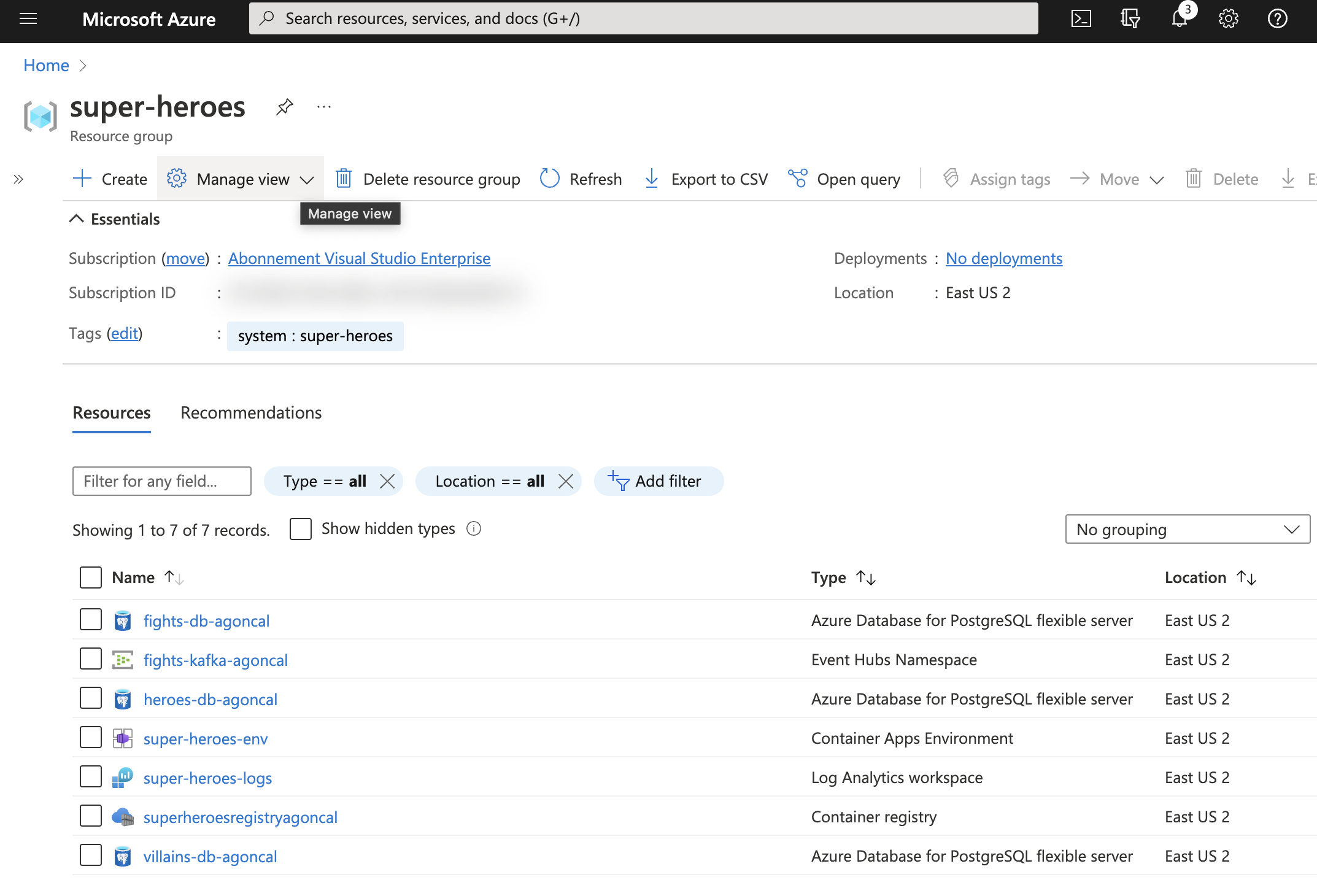
Deploying the Applications
Now that the Azure Container Apps environment is all set, we need to deploy our microservices to Azure Container Apps. So let’s create an instance of Container Apps for each of our microservices and User Interface.
Heroes Microservice
First, the Heroes microservice.
The Heroes microservice needs to access the managed Postgres database.
Therefore, we need to set the right properties using our environment variables.
Notice that the Heroes microservice has a --min-replicas set to 0.
That means it can scale down to zero if not used (more on that later).
Create the Heroes container app with the following command:
az containerapp create \
--resource-group "$RESOURCE_GROUP" \
--tags system="$TAG" application="$HEROES_APP" \
--image "$HEROES_IMAGE" \
--name "$HEROES_APP" \
--environment "$CONTAINERAPPS_ENVIRONMENT" \
--ingress external \
--target-port 8083 \
--min-replicas 0 \
--env-vars QUARKUS_HIBERNATE_ORM_DATABASE_GENERATION=validate \
QUARKUS_HIBERNATE_ORM_SQL_LOAD_SCRIPT=no-file \
QUARKUS_DATASOURCE_USERNAME="$POSTGRES_DB_ADMIN" \
QUARKUS_DATASOURCE_PASSWORD="$POSTGRES_DB_PWD" \
QUARKUS_DATASOURCE_REACTIVE_URL="$HEROES_DB_CONNECT_STRING"The following command sets the URL of the deployed application to the HEROES_URL variable:
HEROES_URL="https://$(az containerapp ingress show \
--resource-group "$RESOURCE_GROUP" \
--name "$HEROES_APP" \
--output json | jq -r .fqdn)"
echo $HEROES_URLYou can now invoke the Hero microservice APIs with:
curl "$HEROES_URL/api/heroes/hello"
curl "$HEROES_URL/api/heroes" | jqTo access the logs of the Heroes microservice, you can write the following query:
az monitor log-analytics query \
--workspace $LOG_ANALYTICS_WORKSPACE_CLIENT_ID \
--analytics-query "ContainerAppConsoleLogs_CL | where ContainerAppName_s == '$HEROES_APP' | project ContainerAppName_s, Log_s, TimeGenerated " \
--output table|
You might have to wait to be able to get the logs. Log analytics can take some time to get initialized. |
Villains Microservice
The Villain microservice also needs to access the managed Postgres database, so we need to set the right variables.
Notice the minimum of replicas is also set to 0:
az containerapp create \
--resource-group "$RESOURCE_GROUP" \
--tags system="$TAG" application="$VILLAINS_APP" \
--image "$VILLAINS_IMAGE" \
--name "$VILLAINS_APP" \
--environment "$CONTAINERAPPS_ENVIRONMENT" \
--ingress external \
--target-port 8084 \
--min-replicas 0 \
--env-vars QUARKUS_HIBERNATE_ORM_DATABASE_GENERATION=validate \
QUARKUS_HIBERNATE_ORM_SQL_LOAD_SCRIPT=no-file \
QUARKUS_DATASOURCE_USERNAME="$POSTGRES_DB_ADMIN" \
QUARKUS_DATASOURCE_PASSWORD="$POSTGRES_DB_PWD" \
QUARKUS_DATASOURCE_JDBC_URL="$VILLAINS_DB_CONNECT_STRING"The following command sets the URL of the deployed application to the VILLAINS_URL variable:
VILLAINS_URL="https://$(az containerapp ingress show \
--resource-group "$RESOURCE_GROUP" \
--name "$VILLAINS_APP" \
--output json | jq -r .fqdn)"
echo $VILLAINS_URLYou can now invoke the Villain microservice APIs with:
curl "$VILLAINS_URL/api/villains/hello"
curl "$VILLAINS_URL/api/villains" | jqTo access the logs of the Villain microservice, you can write the following query:
az monitor log-analytics query \
--workspace $LOG_ANALYTICS_WORKSPACE_CLIENT_ID \
--analytics-query "ContainerAppConsoleLogs_CL | where ContainerAppName_s == '$VILLAINS_APP' | project ContainerAppName_s, Log_s, TimeGenerated " \
--output tableNarration Microservice
The Narration microservice does not access any database, just a remote OpenAI/AzureAI service.
az containerapp create \
--resource-group "$RESOURCE_GROUP" \
--tags system="$TAG" application="$NARRATION_APP" \
--image "$NARRATION_IMAGE" \
--name "$NARRATION_APP" \
--environment "$CONTAINERAPPS_ENVIRONMENT" \
--ingress external \
--target-port 8086 \
--min-replicas 0The following command sets the URL of the deployed application to the NARRATION_URL variable:
NARRATION_URL="https://$(az containerapp ingress show \
--resource-group "$RESOURCE_GROUP" \
--name "$NARRATION_APP" \
--output json | jq -r .fqdn)"
echo $NARRATION_URLYou can now invoke the Narration microservice APIs with:
curl "$NARRATION_URL/api/narration/hello"
curl -X POST -d '{"winnerName":"Super winner", "winnerLevel":42, "winnerPowers":"jumping", "loserName":"Super loser", "loserLevel":2, "loserPowers":"leaping", "winnerTeam":"heroes", "loserTeam":"villains" }' -H "Content-Type: application/json" "$NARRATION_URL/api/narration" -vTo access the logs of the Narration microservice, you can write the following query:
az monitor log-analytics query \
--workspace $LOG_ANALYTICS_WORKSPACE_CLIENT_ID \
--analytics-query "ContainerAppConsoleLogs_CL | where ContainerAppName_s == '$NARRATION_APP' | project ContainerAppName_s, Log_s, TimeGenerated " \
--output tableStatistics Microservice
The Statistics microservice listens to a Kafka topics and consumes all the fights.
Create the Statistics container application with the following command:
az containerapp create \
--resource-group "$RESOURCE_GROUP" \
--tags system="$TAG" application="$STATISTICS_APP" \
--image "$STATISTICS_IMAGE" \
--name "$STATISTICS_APP" \
--environment "$CONTAINERAPPS_ENVIRONMENT" \
--ingress external \
--target-port 8085 \
--min-replicas 0 \
--env-vars KAFKA_BOOTSTRAP_SERVERS="$KAFKA_BOOTSTRAP_SERVERS" \
KAFKA_SECURITY_PROTOCOL=SASL_SSL \
KAFKA_SASL_MECHANISM=PLAIN \
KAFKA_SASL_JAAS_CONFIG="$KAFKA_JAAS_CONFIG"The following command sets the URL of the deployed application to the STATISTICS_URL variable:
STATISTICS_URL="https://$(az containerapp ingress show \
--resource-group "$RESOURCE_GROUP" \
--name "$STATISTICS_APP" \
--output json | jq -r .fqdn)"
echo $STATISTICS_URLYou can now display the Statistics UI with:
open "$STATISTICS_URL"To access the logs of the Statistics microservice, you can write the following query:
az monitor log-analytics query \
--workspace $LOG_ANALYTICS_WORKSPACE_CLIENT_ID \
--analytics-query "ContainerAppConsoleLogs_CL | where ContainerAppName_s == '$STATISTICS_APP' | project ContainerAppName_s, Log_s, TimeGenerated " \
--output tableFights Microservice
The Fight microservice invokes the Heroes and Villains microservices, sends fight messages to a Kafka topics and stores the fights into a MongoDB database. We need to configure Kafka (same connection string as the one used by the Statistics microservice) as well as the Postgres database. As for the microservice invocations, you need to set the URLs of both Heroes and Villains microservices.
Create the Fights container application with the following command:
az containerapp create \
--resource-group "$RESOURCE_GROUP" \
--tags system="$TAG" application="$FIGHTS_APP" \
--image "$FIGHTS_IMAGE" \
--name "$FIGHTS_APP" \
--environment "$CONTAINERAPPS_ENVIRONMENT" \
--ingress external \
--target-port 8082 \
--min-replicas 0 \
--env-vars QUARKUS_HIBERNATE_ORM_DATABASE_GENERATION=validate \
QUARKUS_HIBERNATE_ORM_SQL_LOAD_SCRIPT=no-file \
QUARKUS_DATASOURCE_USERNAME="$POSTGRES_DB_ADMIN" \
QUARKUS_DATASOURCE_PASSWORD="$POSTGRES_DB_PWD" \
QUARKUS_DATASOURCE_JDBC_URL="$FIGHTS_DB_CONNECT_STRING" \
KAFKA_BOOTSTRAP_SERVERS="$KAFKA_BOOTSTRAP_SERVERS" \
KAFKA_SECURITY_PROTOCOL=SASL_SSL \
KAFKA_SASL_MECHANISM=PLAIN \
KAFKA_SASL_JAAS_CONFIG="$KAFKA_JAAS_CONFIG" \
QUARKUS_REST_CLIENT_HERO_URL="$HEROES_URL" \
QUARKUS_REST_CLIENT_VILLAIN_URL="$VILLAINS_URL" \
QUARKUS_REST_CLIENT_NARRATION_URL="$NARRATION_URL"The following command sets the URL of the deployed application to the FIGHTS_URL variable:
FIGHTS_URL="https://$(az containerapp ingress show \
--resource-group "$RESOURCE_GROUP" \
--name "$FIGHTS_APP" \
--output json | jq -r .fqdn)"
echo $FIGHTS_URLUse the following curl commands to access the Fight microservice. Remember that we’ve set the minimum replicas to 0. That means that pinging the Hero and Villain microservices might fallback (you will get a That means that pinging the Hero and Villain microservices might fallback (you will get a That means that pinging the Hero and Villain microservices might fallback (you will get a _Could not invoke the Villains microservice message). Execute several times the same curl commands so Azure Containers Apps has time to instantiate one replica and process the requests:
curl "$FIGHTS_URL/api/fights/hello"
curl "$FIGHTS_URL/api/fights" | jq
curl "$FIGHTS_URL/api/fights/randomfighters" | jqTo access the logs of the Fight microservice, you can write the following query:
az monitor log-analytics query \
--workspace $LOG_ANALYTICS_WORKSPACE_CLIENT_ID \
--analytics-query "ContainerAppConsoleLogs_CL | where ContainerAppName_s == '$FIGHTS_APP' | project ContainerAppName_s, Log_s, TimeGenerated " \
--output tableSuper Hero UI
Like for the previous microservices, we will be deploying the UI as Docker image as we did for the previous microservices. But we could have also deployed the Super Hero UI using Azure Static Webapps which is suited for React applications. If you are interested in this approach, you can check Azure Static Webapps.
For now, let’s continue with Azure Container Apps and deploy the UI as a Docker image with the following command:
az containerapp create \
--resource-group "$RESOURCE_GROUP" \
--tags system="$TAG" application="$UI_APP" \
--image "$UI_IMAGE" \
--name "$UI_APP" \
--environment "$CONTAINERAPPS_ENVIRONMENT" \
--ingress external \
--target-port 8080 \
--env-vars API_BASE_URL="$FIGHTS_URL"UI_URL="https://$(az containerapp ingress show \
--resource-group "$RESOURCE_GROUP" \
--name "$UI_APP" \
--output json | jq -r .fqdn)"
echo $UI_URLopen "$UI_URL"To access the UI logs, you can write the following query:
az monitor log-analytics query \
--workspace $LOG_ANALYTICS_WORKSPACE_CLIENT_ID \
--analytics-query "ContainerAppConsoleLogs_CL | where ContainerAppName_s == '$UI_APP' | project ContainerAppName_s, Log_s, TimeGenerated " \
--output tableRunning the Application
Now that the entire infrastructure is created and the microservices deployed, you can use all the following commands to either, directly invoke the APIs, or use the user interfaces:
curl "$HEROES_URL/api/heroes" | jq
curl "$VILLAINS_URL/api/villains" | jq
curl "$FIGHTS_URL/api/fights/randomfighters" | jq
open "$STATISTICS_URL"
open "$UI_URL"Monitoring the Application on Azure Container Apps
Restarting a Microservice
If you need to restart a microservice, you need to actually restart the active revision. For that, first get the active revision:
az containerapp revision list \
--resource-group "$RESOURCE_GROUP" \
--name "$FIGHTS_APP" \
--output tableThen, restart it:
az containerapp revision restart \
--resource-group "$RESOURCE_GROUP" \
--app "$FIGHTS_APP" \
--name rest-fights-app--mh396rgRedeploying a new version of a microservice
If you need to push a new version of a Docker image, make sure it has a different tag. Then, update the container with this new tagged image:
az containerapp update \
--resource-group "$RESOURCE_GROUP" \
--image quay.io/quarkus-super-heroes/rest-fights:azure2 \
--name "$FIGHTS_APP"Cleaning Up Azure Resources
Do NOT forget to remove the Azure resources once you are done running the workshop.
az group delete \
--name "$RESOURCE_GROUP"Writing a Quarkus Extension
Most of the Quarkus magic happens inside extensions. The goal of an extension is to compute just enough bytecode to start the services that the application requires and drop everything else.
So, when writing an extension, you need to distinguish the action that:
-
Can be done at build time - following the build time principle of Quarkus
-
Must be done at runtime
Because of this distinction, extensions are divided into two parts: a build time augmentation and a runtime. The augmentation part is responsible for all the metadata processing, annotation scanning, XML parsing… The output of this augmentation is recorded bytecode, which, then, is executed at runtime to instantiate the relevant services.
In this chapter, you are going to implement a version extension. It prints the version of the application in the log of the application when this application starts. It is a straightforward application, but it highlights the distinction between build time and runtime. Instead of extracting the version at runtime and printing it, we find the version at build time and record the print instruction to when the application starts it prints the version.
The extension framework
Quarkus’s mission is to transform your entire application, including the libraries it uses, into an artifact that uses significantly fewer resources than traditional approaches.
These can then be used to build JVM applications and native executables using the GraalVM native-image compiler.
To do this, you need to analyze and understand the application’s "closed world". Without the full context, the best that can be achieved is partial and limited generic support.
To build an extension, Quarkus provides a framework to:
-
Read the configuration from the
application.propertiesfile and map it to objects, -
Read metadata from classes without having to load them; this includes classpath and annotation scanning,
-
Generate bytecode if needed (for proxies, for instance),
-
Pass sensible defaults to the application,
-
Make the application compatible with GraalVM (resources, reflection, substitutions),
-
Implement hot-reload
Structure of an extension
As stated above, an extension is divided into two parts, called deployment (augmentation) and runtime.

From the directory super-heroes execute the following commands:
./mvnw io.quarkus.platform:quarkus-maven-plugin:3.27.0:create-extension -N \
-DplatformVersion=3.27.0 \
-DwithoutTests \
-DextensionId=extension-version \
-DgroupId=io.quarkus.workshop.super-heroes \
-DpackageName=io.quarkus.workshop.superheroes.versionThis command creates the structure for the version extension:
-
One parent
pom.xmlimporting thequarkus-bom -
A module for the runtime
-
A module for the deployment, with a dependency on the runtime artifact
The final structure of the extension developed in this section is the following:
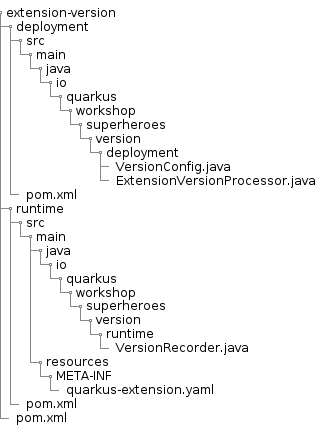
If you want your IDE to manage this new Maven project, you can declare it in the parent POM by adding this new module in the <modules> section
<module>super-heroes/extension-version</module>The version extension
The goal of this chapter is to implement an extension that displays the application version on startup. For this, what do we need:
-
A way to extract the version (we’re lucky, Quarkus provided it)
-
Some code that would print the version when the application starts; so some runtime code,
-
Some build steps that extracts the version and records the runtime invocations
The runtime module
The runtime part of an extension contains only the classes and resources required at runtime. For the version extension, it would be a single class that prints the version.
First, let’s create the configuration class that will allow users to dynamically configure whether the version should be printed:
Under the runtime module, create the src/main/java directory, and, in this directory, create a new interface named io.quarkus.workshop.superheroes.version.runtime.VersionConfig with the following content:
package io.quarkus.workshop.superheroes.version.runtime;
import io.quarkus.runtime.annotations.ConfigPhase;
import io.quarkus.runtime.annotations.ConfigRoot;
import io.smallrye.config.ConfigMapping;
import io.smallrye.config.WithDefault;
@ConfigMapping(prefix = "quarkus.version")
@ConfigRoot(phase = ConfigPhase.RUN_TIME)
public interface VersionConfig {
/**
* Enables or disables the version printing at startup.
*/
@WithDefault("true")
boolean enabled();
}The @ConfigMapping annotation declares VersionConfig as a configuration interface which configuration properties are prefixed with quarkus.version prefix. It is also used in CDI aware environments to scan and register Config Mappings.
The @ConfigRoot annotation declares that the configuration is available during runtime.
The @WithDefault("true") is used to declare the default value returned when enabled() is called.
By default, the name of the property is derived from what’s declared in the prefix attribute inside @ConfigMapping plus the name of the method. In our case, the user-configured property will be quarkus.version.enabled.
Still in the runtime module, create the io.quarkus.workshop.superheroes.version.runtime.VersionRecorder class with the following content:
package io.quarkus.workshop.superheroes.version.runtime;
import io.quarkus.runtime.annotations.Recorder;
import org.jboss.logging.Logger;
@Recorder
public class VersionRecorder {
public void printVersion(VersionConfig versionConfig, String version) {
if (versionConfig.enabled()) {
Logger.getLogger(VersionRecorder.class.getName()).infof("Version: %s", version);
}
}
}Simple right?
But how does it work?
Look at the @Recorder annotation.
It indicates that this class is a recorder used to record actions executed later at runtime.
Indeed, these actions are replayed at runtime.
We will see how this recorder is used from the deployment module.
The deployment module
This module contains build steps, i.e., methods called during the augmentation phase and computing just enough bytecode to serve the services the application requires.
The version extension consists of a single build step that extracts the version and uses the VersionRecorder.
Next, open the ExtensionVersionProcessor class, and update the content to be:
package io.quarkus.workshop.superheroes.version.deployment;
import io.quarkus.deployment.annotations.BuildStep;
import io.quarkus.deployment.annotations.ExecutionTime;
import io.quarkus.deployment.annotations.Record;
import io.quarkus.deployment.builditem.ApplicationInfoBuildItem;
import io.quarkus.deployment.builditem.FeatureBuildItem;
import io.quarkus.workshop.superheroes.version.runtime.VersionConfig;
import io.quarkus.workshop.superheroes.version.runtime.VersionRecorder;
class ExtensionVersionProcessor {
private static final String FEATURE = "extension-version";
@BuildStep
FeatureBuildItem feature() {
return new FeatureBuildItem(FEATURE);
}
@BuildStep
@Record(ExecutionTime.RUNTIME_INIT)
void recordVersion(ApplicationInfoBuildItem app, VersionConfig versionConfig, VersionRecorder recorder) {
recorder.printVersion(versionConfig, app.getVersion());
}
}This class is the core of the extension.
It contains a set of methods annotated with @BuildStep.
The command generated the first one we used to set up the project.
It just produces a FeatureBuildItem.
When the application starts, Quarkus lists the enabled features.
So, when this extension is present, extension-version will be printed.
The recordVersion method is responsible for recording the actions that will happen at runtime.
In addition to the @BuildStep annotation, it also has the @Record annotation allowing to receive a recorder object (VersionRecorder) and indicating when the recorded bytecode is replayed.
Here we are replaying during the runtime initialization, i.e., equivalent to the public static void main(String… args) method.
The method also receives the ApplicationInfoBuildItem.
Quarkus provides many build items which can be reused.
ApplicationInfoBuildItem contains the version.
The second parameter of the recordVersion method is the VersionConfig which provides access to the user configuration we created in the previous step.
The code is straightforward: if enabled is true, the code calls the recorder which prints the version.
|
Recorder at deployment time
At deployment time, proxies of recorders are injected into |
Packaging the extension
From the root directory of the extension, run:
./mvnw clean installUsing the extension
Go back to the villain microservice, and add the following dependency to the pom.xml file:
<dependency>
<groupId>io.quarkus.workshop.super-heroes</groupId>
<artifactId>extension-version</artifactId>
<version>1.0.0-SNAPSHOT</version>
</dependency>If not yet started, start the microservice with:
./mvnw quarkus:devAnd the version will be displayed:
10:16:58 INFO [io.qu.wo.su.ve.ru.VersionRecorder] (Quarkus Main Thread) Version: 1.0.0-SNAPSHOT
...
10:17:00 INFO [io.quarkus] (Quarkus Main Thread) Installed features: [agroal, cdi, extension-version, hibernate-orm, hibernate-orm-panache, hibernate-validator, jdbc-postgresql, narayana-jta, rest, rest-jackson, smallrye-context-propagation, smallrye-health, smallrye-openapi, swagger-ui, vertx]Conclusion
In this section, you have seen how to develop a simple extension for Quarkus. Quarkus offers a complete toolbox to implement extensions, from configuration support, tests, bytecode generation… The mindset to implement an extension is crucial. The distinction between build time and runtime is what makes Quarkus so efficient. To go further, check https://quarkus.io/guides/extension-authors-guide.
Conclusion
This is the end of the Super Hero workshop. We hope you liked it, learnt a few things, and more importantly, will be able to take this knowledge back to your projects.
This workshop started making sure your development environment was ready to develop the entire application. Then, there was some brief terminology to help you in understanding some concepts around Quarkus. If you find it was too short and need more details on Quarkus, Microservices, MicroProfile, Cloud Native, or GraalVM, check the Quarkus website for more references.[23]
Then, we focused on developing several isolated microservices. Some written in pure JAX-RS (such as the Villain) others with Reactive JAX-RS and Reactive Hibernate (such as the Hero). These microservices return data in JSON, validate data thanks to Bean Validation, store and retrieve data from a relational database with the help of JPA, Panache and JTA.
You then installed an already coded React application on another instance of Quarkus. At this stage, the React application couldn’t access the microservices because of CORS issues that we quickly fixed.
Then, we made the microservices communicate with each other in HTTP thanks to REST Client. But HTTP-related technologies usually use synchronous communication and therefore need to deal with invocation failure. With Fault Tolerance, it was just a matter of using a few annotations and we can get some fallback when the communication fails.
That’s also why we introduced Reactive Messaging with Kafka: so we don’t have a temporal coupling between the microservices.
We’ve also added some Artificial Intelligence. Thanks to Semantic Kernel, with a few lines of code, we allowed our Narration microservice to narrate the fight between a Super Hero and a Super Villain.
Then, came production time. With Quarkus it’s very easy to build executable JARs. With a JVM installed you can execute these JARs which are optimal for production. And if you need to turn your microservice into an executable binary (thanks to GraalVM), that’s easy too. Quarkus supports GraalVM since the beginning and makes its integration smooth. Same if you want to package microservices into Docker containers. Quarkus supports Jib. So with a simple Maven command you can turn your microservice into a container.
Remember that you can find all the code for this fascicle at https://github.com/quarkusio/quarkus-workshops/tree/refs/heads/main/quarkus-workshop-super-heroes. If some parts were not clear enough, or if you found something missing, a bug, or you just want to leave a note or suggestion, please use the GitHub issue tracker at https://quarkus.io/.
References
Appendix A: Installing extra software
Apache Maven 3.9.x
All the examples of this workshop are built and tested using Maven.[24] Maven offers a building solution, shared libraries, and a plugin platform for your projects, allowing you to do quality control, documentation, teamwork, and so forth. Based on the "convention over configuration" principle, Maven brings a standard project description and a number of conventions such as a standard directory structure. With an extensible architecture based on plugins, Maven can offer many different services.
Installing Maven
The examples of this workshop have been developed with Apache Maven 3.9.x.
For this workshop, it is not necessary to install Maven.
You can just use the Maven wrapper in your working directory, ./mvnw.
The wrapper is always at a suitable Maven version.
However, if you’d prefer to have a global installation of Maven (mvn), here’s how.
Once you have installed JDK 17, make sure the JAVA_HOME environment variable is set.
Then, download Maven from http://maven.apache.org/, unzip the file on your hard drive and add the apache-maven/bin directory to your PATH variable.
More details about the installation process are available on https://maven.apache.org/install.html.
If you are on Mac OS X and use Homebrew, install Maven with the following command:
brew install mavenChecking for Maven Installation
Once you’ve got Maven installed, open a command line and enter mvn -version to validate your installation.
Maven should print its version and the JDK version it uses (which is handy as you might have different JDK versions installed on the same machine).
$ mvn -version
Apache Maven 3.8.4 (ea98e05a04480131370aa0c110b8c54cf726c06f)
Maven home: /usr/local/Cellar/maven/3.8.4/libexec
Java version: 11.0.15, vendor: AdoptOpenJDK, runtime: /Users/clement/.sdkman/candidates/java/11.0.15.hs-adpt
Default locale: en_FR, platform encoding: UTF-8
OS name: "mac os x", version: "11.5", arch: "x86_64", family: "mac"Be aware that Maven needs Internet access to download plugins and project dependencies from the Maven Central and other remote repositories.[25]
Some Maven Commands
Maven is a command-line utility where you can use several parameters and options to build, test, or package your code. To get some help on the commands, you can type, use the following command:
$ mvn --help
usage: mvn [options] [<goal(s)>] [<phase(s)>]Here are some commands that you will be using to run the examples in the workshop.
Each invokes a different phase of the project life cycle (clean, compile, install, etc.) and use the pom.xml to download libraries, customize the compilation, or extend some behaviors with plugins:
-
mvn clean: Deletes all generated files (compiled classes, generated code, artifacts etc.). -
mvn compile: Compiles the main Java classes. -
mvn test-compile: Compiles the test classes. -
mvn test: Compiles the main Java classes as well as the test classes and executes the tests. -
mvn package: Compiles, executes the tests, and packages the code into an archive. -
mvn install: Builds and installs the artifacts in your local repository. -
mvn clean install: Cleans and installs (note that you can add several commands separated by a space, likemvn clean compile test).
cURL
To invoke the REST Web Services described in this workshop, we often use cURL.[26] cURL is a command-line tool and library to do reliable data transfers with various protocols, including HTTP. It is free, open-source (available under the MIT Licence), and has been ported to several operating systems. If your operating system does not already include cURL (most do), here is how to install it.
Installing cURL
If you are on Mac OS X and have installed Homebrew, then installing cURL is just a matter of a single command.[27] Open your terminal and install cURL with the following command:
brew install curlFor Windows, download and install curl from https://curl.se/download.html.
Checking for cURL Installation
Once installed, check for cURL by running curl --version in the terminal.
It should display cURL version:
$ curl --version
curl 7.64.1 (x86_64-apple-darwin20.0) libcurl/7.64.1 (SecureTransport) LibreSSL/2.8.3 zlib/1.2.11 nghttp2/1.41.0
Release-Date: 2019-03-27
Protocols: dict file ftp ftps gopher http https imap imaps ldap ldaps pop3 pop3s rtsp smb smbs smtp smtps telnet tftp
Features: AsynchDNS GSS-API HTTP2 HTTPS-proxy IPv6 Kerberos Largefile libz MultiSSL NTLM NTLM_WB SPNEGO SSL UnixSocketsSome cURL Commands
cURL is a command-line utility where you can use several parameters and options to invoke URLs.
You invoke curl with zero, one, or several command-line options to accompany the URL (or set of URLs) you want the transfer to be about.
cURL supports over two hundred different options, and I would recommend reading the documentation for more help.[28]
To get some help on the commands and options, you can type, use the following command:
$ curl --help
Usage: curl [options...] <url>You can also opt to use curl --manual, which will output the entire man page for cURL plus an appended tutorial for the most common use cases.
Here are some commands you will use to invoke the RESTful web service examples in this workshop.
-
curl http://localhost:8083/api/heroes/hello: HTTP GET on a given URL. -
curl -X GET http://localhost:8083/api/heroes/hello: Same effect as the previous command, an HTTP GET on a given URL. -
curl -v http://localhost:8083/api/heroes/hello: HTTP GET on a given URL with verbose mode on. -
curl -H 'Content-Type: application/json' http://localhost:8083/api/heroes/hello: HTTP GET on a given URL passing the JSON Content Type in the HTTP Header. -
curl -X DELETE http://localhost:8083/api/heroes/1: HTTP DELETE on a given URL.
Warming the caches
This workshop needs internet access to download all sorts of Maven artifacts, Docker images, and even pictures. Some of these artifacts are large, and because we have to share internet connexions at the workshop, it is better to download them before the workshop.
If you’re getting ready for a workshop, you might find it helpful to pre-download some Docker images. This can save strain on shared bandwidth. If, however, you’re already attending a workshop, don’t worry about warming anything up.
Warming up Maven
Download the workshop scaffolding
First, download the zip file https://raw.githubusercontent.com/quarkusio/quarkus-workshops/refs/heads/main/quarkus-workshop-super-heroes/dist/quarkus-super-heroes-workshop.zip, and unzip it wherever you want. This zip file contains some of the code of the workshop, and you will need to complete it.
Download the Maven dependencies
Now that you have the initial structure in place, navigate to the root directory and run:
./mvnw clean installBy running this command, it downloads all the required dependencies.
Warming up Docker images
To warm up your Docker image repository, navigate to the quarkus-workshop-super-heroes/super-heroes/infrastructure directory.
Here, you will find a
docker-compose.yaml
or
docker-compose-linux.yaml
file which defines all the needed Docker images.
Notice that there is a db-init directory with an initialize-databases.sql script which sets up our databases, and a monitoring directory (all that will be explained later).
Then execute the following command which will download all the Docker images and start the containers:
docker compose -f docker-compose.yaml up -d|
Linux Users beware
If you are on Linux, use |
|
If you have an issue creating the roles for the database with the |
After this, verify the containers are running using the following command:
docker compose -f docker-compose.yaml psThe output should resemble something like this:
Name Command State Ports
--------------------------------------------------------------------------------
kafka sh -c bin/kafka-server-sta ... Up 0.0.0.0:9092->9092/tcp
super-database docker-entrypoint.sh postgres Up 0.0.0.0:5432->5432/tcp
super-visor /bin/prometheus --config.f ... Up 0.0.0.0:9090->9090/tcp
zookeeper sh -c bin/zookeeper-server ... Up 0.0.0.0:2181->2181/tcpOnce all the containers are up and running, you can shut them down and remove their volumes with the commands:
docker compose -f docker-compose.yaml down
docker compose -f docker-compose.yaml rm|
What’s this infra?
Any microservice system is going to rely on a set of technical services. In our context, we are going to use PostgreSQL as the database, Prometheus as the monitoring tool, and Kafka as the event/message bus. This infrastructure starts all these services, so you don’t have to worry about them. This infra will only be used when we run our services in prod mode. In dev mode, Quarkus will start everything for us. |